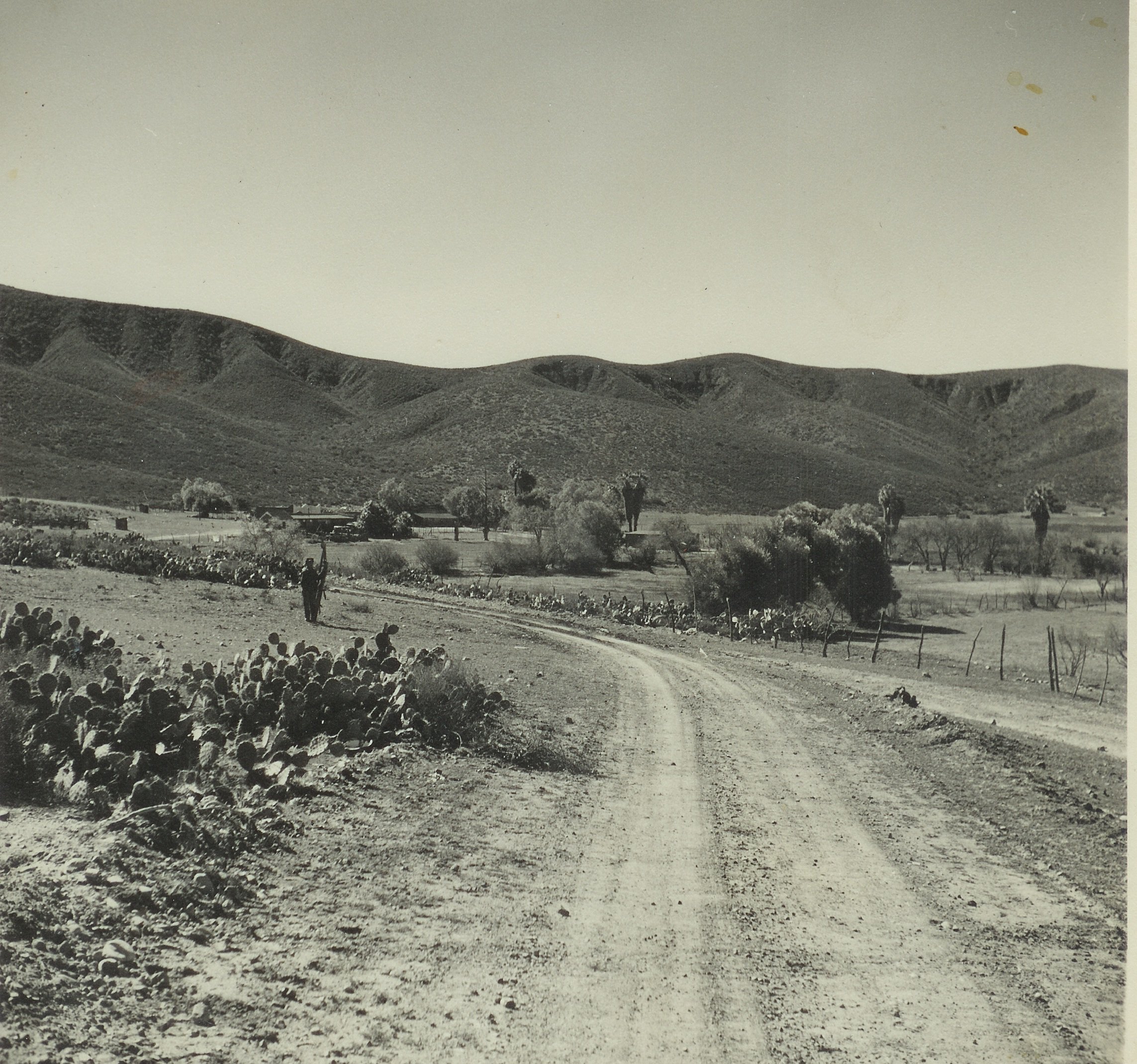
Once the final decision to start a ranch in San Telmo was made we set about gathering equipment for the project. The first thing on the list was to get the remaining Star 71 drill rig ready for service. We had the engine tuned up and also had the tower re-enforced, so that it would be strong enough to use for pump installation. We went to a used drilling equipment yard in Fillmore to buy the drilling tools. Our long time friend, neighbor, and well driller, Harry Crinklaw, was my mentor in all if this.

The little village of San Telmo, looking West
By the time that we started our project, the development of Grampa Uttís ranch, called San Andres, was pretty far along. They had installed pumps in their two wells; installed a booster pump to lift water up to a large concrete tank (pila) located at the top of a hill, started land leveling, and completed some buildings. One of these buildings was a kitchen and dining room, where everyone was fed. We arranged to have our meals there also. We built a small room of wood frame and siding at their ranch headquarters, which we used for storage, as well as sleeping. We also arranged for an area to use for our tractors and equipment.
The wife of Senovio Beltran, who was a mechanic, ran the cookhouse. They had come from Santa Rosalia; Senovio having been laid off there because of the closure of the copper mine. They had a daughter named Aldegunda, who married Pancho Martinez, who worked on our ranch. Some of you will remember Pancho and Aldegunda as waiters at the El Rey Sol in Ensenada.
Of course there was no electricity available in the valley, which meant that all pumps would have to be engine driven, and light came from gasoline or kerosene lanterns. The other ranch did have a small generator to furnish power to their buildings.

Terry, fifteen months
Looking back, I canít believe how many foolish things we did. For starters, our original plan was to spend a year getting the ranch in order before planting a crop. At some point we decided that if we accelerated all the work, we could plant the first year. This probably was the worst mistake of all. When you are moving too fast, there are too many compromises. By the time we got our drill rig ready and hauled to San Telmo it was obvious that it was too late in the season to use the painfully slow method of drilling with our cable tool rig. So, we next hired Cozart Brothers from San Fernando with a rotary drill rig to go down and drill a well for us.
Meanwhile, on the assumption that we would get water, we purchased two small Farmall tractors, and a TD-9 crawler tractor, all from Maulhardt Equip. Co, and also took the Sinaloa Ranch TD-9 tractor. We also bought a plow, disc, harrows, and Lanplane. We installed an angle-bulldozer on one of the TD-9s.
Clearing the land proved to be much, much harder than we anticipated. It was covered with Mescal, which is a very tough, robust cactus that puts out a six or eight foot flower stock every year, if there is sufficient rain. We finally settled for using the angle dozer to push the mescal side-ways, six feet at a time, into windrows that we could plant 20 or 30 rows of beans between.
Meanwhile, Cozarts drilled a well at one of the two locations that Steve Riess had given us. I donít remember how deep they drilled: probably not more than two or three hundred feet. After setting the casing, they started to bail out the mud and sand with a long bucket on a high-speed cable, known as the "sand line". After a few minutes of bailing we could see that the well was producing very little, if any water. This was quite a blow, as we had just assumed that we would get water. I think I mentioned that Steve had located some very good water wells in unlikely places, and that they had been well publicized. Not so well publicized were his many failures!

David, about
six months
We moved to another of Steveís locations, farther up the valley. After a day or two of drilling, we began to think that this well was not going to produce any more water than the first one. Tom quickly made arrangements for an easement from Grampa Utt to drill on his ranch, where there were already two producing wells. So, the drill rig was moved, again, and drilling got underway, again. This well was in the main San Telmo valley, between the other two producing wells, so we were quite certain that it would be a good one. We were not disappointed! When it was done we installed a 1000-gallon per minute pump in it. I installed the pump, using our drill rig. As I mentioned earlier, I had worked with the pump crews on Sinaloa Ranch, and I also got some coaching from the Wintroath Pump Co, where we bought the pump.
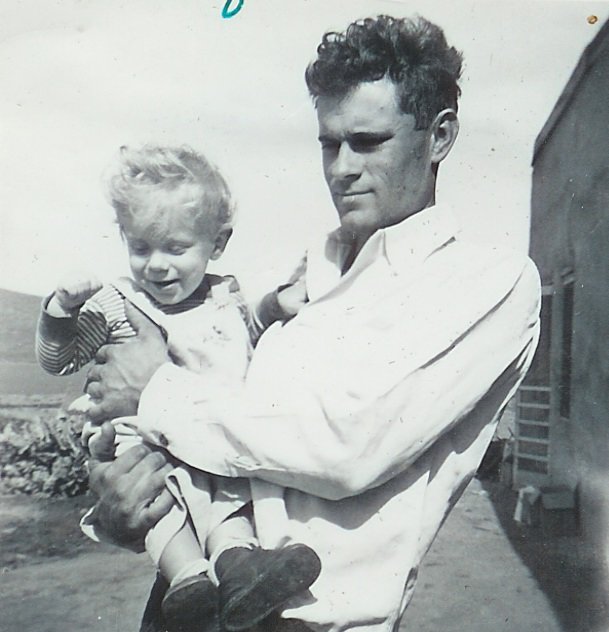
David and
Daddy
Of course the location of our well meant that we had to pump the water a half mile to the edge of our ranch, then another half mile to the upper end, uphill all the way! At this point we made possibly our worst mistake. Actually it was part of a bigger mistake-our determination to get a crop in that first year. In hindsight, it would have been much better to go more slowly, do things right, and probably for less money. Starting too late on a project of this kind is always a mistake. Of course, time is money, and the need to conserve money drove the decision-making.
The decision at hand was what to do about a pipeline to deliver water to the top of the ranch. We had recently installed some Transite (high-pressure) pipe on the ranch in Simi, and I thought that would be the way to go. Tom said that we could not afford Transite, and started shopping for something cheaper. What he found was some 14" concrete pipe in Ensenada. It had been made for someone who did not take it, so he was able to get it for a very good price. Now, as Iím sure all of you know, concrete pipe has this tiny little flaw; it wonít stand much more than 10 pounds of pressure (about 22 feet of elevation). Since we had triple that, we had to install two booster pumps along the line, to keep from putting too much pressure on the line. The lift from the well to the first booster was about twenty feet. The lift to the second booster was slightly more, and the last lift also about twenty feet. Of course there is friction in the pipe, which means that the actual pressure was more than that.
Tom found a man in Maneadero that had learned to lay concrete pipe while working for Fowler and Meyers, who put in all the pipelines on Sinaloa Ranch. We couldnít line up a trencher, so we used the angle dozer to scrape out a shallow ditch to lay the pipe in, then used the dozer again to cover the pipe, very carefully, I might add!
We surely spent at least three or four thousand dollars on each booster for pump, fittings, engine and fuel tank. This money would have been much better spent on pressure pipe. As it turned out, the line between the two boosters was a great source of trouble. It broke many times, always when we needed it the most. More on that later.
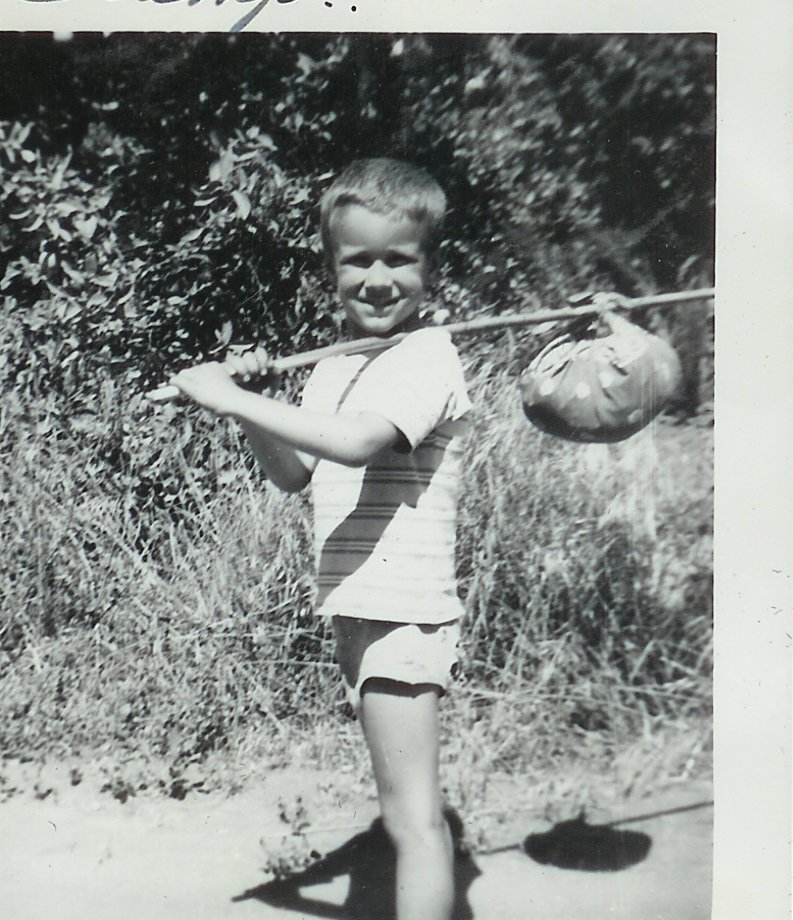
Dan, age 41/2 years, headed off into the orchard for a picnic.
During that first fall and winter John Wilson spent quite a bit of time at the ranch with us. He and I made several trips down there together. One of these was in an old Ford truck that he had taken in trade at his Ford dealership in Fillmore. We loaded it with some old galvanized irrigation pipe from Sinaloa Ranch, drove it to Santa Terresa and left it there to be used on the ranch.(A couple of years later, I mounted the drill rig, which had been mounted on four steel wheels, on this old truck, to make it easier to move around) I donít remember how we got home. Another, more memorable, trip started with John and I in the Sinaloa Ranch truck. We went to Oxnard to load a large Diesel engine for the pump in our well. This was a 100 horsepower, six cylinder, International UD-18. Engines were big and heavy in those days. This one weighed nearly 2,000 lbs. From there we went to Alhambra, to load the pump itself. Besides the pump, which hangs near the bottom of the well, there were six or eight twenty foot joints of eight-inch pipe to bring the water to the surface, along with the same number of drive shafts, and tubing to contain the shaft. Then there was a right angle gear head that was driven by the engine. All in all, it was a good load. When we reached the border, Tom had arranged for a Mexican truck to take our cargo the rest of the way.
A little side-light here; a man named Bernardo Castro had acquired a large ranch in the San Telmo valley, and he had sold the eastern portion of that ranch to Grampa Utt, to become Rancho San Andres. Bernardo had started a trucking and bus service in Tijuana. Over time the business had grown to be the dominant bus service in Tijuana, and between Tijuana, Ensenada, and Mexicali. In fact it was the only bus service that I can remember at that time. Iím not sure about the trucking end; surely he had lots of independent competitors. At some point his unionized employees became so demanding that he persuaded them to form a Co-op (cooperativa) to buy him out. This they did, hiring him as manager for a certain number of years. Part of the money from the sale of his business went to developing the San Telmo ranch. The cooperativa had a long name that I canít recall, but it was known as "La Diligencia Verde", affectionately, or otherwise! These buses were still the only ones available when we left Mexico five years later. During that time, and beyond, the cooperativa never replaced any buses with new ones. They just cannibalized some to keep others running, until they were out of business.
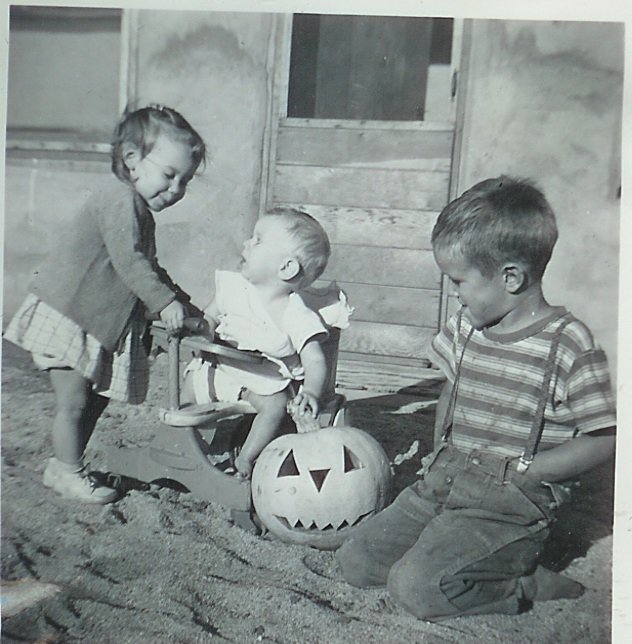
Halloween
at San Telmo, 1949
It was one of these Cooperativa trucks that was to haul our pump and engine the rest of the way to the ranch. As we transferred the load to his truck, the driver got a very worried look on his face, and he started to question me about the condition of the road we were to travel. I assured him that, while not yet paved, it was graded all the way, except for the last 15 miles from the main road to the ranch. I didnít dwell much on the fact that there was one very rough, steep grade on that stretch. He explained to me that the drive axle in his truck had failed and that it had been replaced with an axle from one of the buses, which was a much higher speed, and therefore lower power for pulling uphill. Despite his apprehension, we convinced him it would be OK.
We left TJ early the next morning, John and I riding on the back of the truck, as the cab was too small for three of us. It was a long, tiring, day. We must have had some lunch with us, or maybe we stopped somewhere for lunch. The truck was very slow, especially so on the grades. We were beginning to understand the driverís apprehension. However, we managed fine on the main road and the first half of the road into the ranch. Just past the village of San Telmo the road made a very sharp right turn and started up a very, very steep, rutted, grade toward the top of the ridge about 200 yards away. We only made it about 100 feet when the engine just wouldnít take us any farther. The driver used a technique known as "popping the clutch" to get us the rest of the way to the top. For those of you who have grown up with automatic transmissions, this consists of revving up the engine with the clutch disengaged, then engaging the clutch, allowing the momentum of the engine to take you as far as it could, then repeating the process. Popping the clutch on a heavily loaded truck is an almost sure-fire way to break a U-joint on the drive shaft or snap a drive axle. That he was able to get us to the top without breaking anything was a tribute to the driverís skills. (Or perhaps a reflection of the low power of the engine.)
During those times that John and I worked together we installed the booster pumps and engines. John was very energetic, and whenever he thought of something that needed doing he wanted to start on it immediately. On the other hand, my philosophy was, and has always been, "donít start a dayís work in the middle of the afternoon". I tend to think about the best way to do a job, make all the preparations, and then start first thing in the morning. John almost always prevailed in these situations, and I must admit that most of the time we finished whatever we set out to do that same day. This must be a Wilson trait. A certain Barbara Wilson, though not related to John, has always been the same way. When she thinks of something, she just gets in and does it, no matter what time of day!
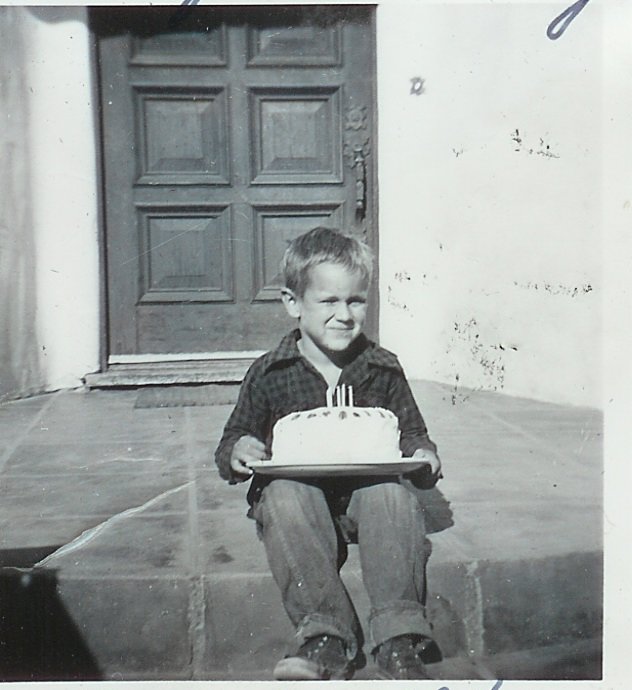
We celebrated
Danís fifth birthday in Simi
After that I made several trips to San Telmo in the Sinaloa Ranch truck. Also, Rancho San Andres hauled some of our equipment on their GMC truck. Felipe Meling was the driver of that truck. The first time I drove the truck down all the way to the ranch, the Zacaton grade, just south of Santo Tomas was under construction. As I started up the grade I noticed a sign that I did not understand. When I rounded a corner, I encountered a loaded dump truck on "my" side of the road. At the last minute he swerved to the other side to go by me, all the while honking and shaking his fist at me. I thought this rather unfriendly, to say the least. When another truck approached in the same manner, it suddenly dawned on me what that sign meant! Traffic was reversed, to allow the loaded trucks to have the inside track on the downgrade. Enlightenment came soon enough for me to move over to the left, and avoid further confrontation! On another occasion I had stopped in Santo Tomas for something or other. One of the dump trucks pulled up beside me, and the driver got out and came over to greet me. He turned out to be Armando Pena. Tom had bought and rented horses from the Pena family the two summers that we had camped at Bahia Santo Tomas. Their ranch was in the lower end of Santo Tomas valley. He had recognized me right away, but I sure would not have recognized him. We were very nearly the same age. A year or so later, Tom brought at least one of those horses to the ranch in San Telmo.
As I mentioned earlier, Grampa Utt intended to grow seed for Haven Seed Co. Iím not sure exactly what financial connection he had with them, but he had grown seed for them for many years. Tom had also grown tomato seed for them on the Sinaloa Ranch in Simi. In fact, at one time he had been the largest single producer of tomato seed in the world.
Haven Seed Co. had fallen into serious financial trouble, and this venture into Mexico was sort of a last ditch effort to stay afloat. Ralph Haven was in charge of Grampaís ranch, to do the growing and oversee the seed processing. He had dismantled a seed processing plant in California and installed it on the San Telmo Ranch. Incidentally, that ranch was called San Andres, for Andy Meling. Grampa had arranged with him to hold title to the property. Andy also managed the ranch in the very early stages, but that didnít work out, for whatever reason. My brother Tom tells me that this plant had been on Grampa Uttís Mugu Ranch, which had been purchased by the Navy.
Both ranches grew Fordhook Lima Beans (the kind used for freezing) for seed, of course. I think we had a contract that paid us $.30 per pound, delivered to Santa Ana, and after re-cleaning and meeting germination requirements. Limas were sky high the year before we planted, bringing as much as $.40 per pound.
We also planted about fifteen acres of tomatoes for seed. Rancho San Andres planted 60 acres.
Rather than tell two stories at the same time, I think I will tell the Lima bean story to its end, then get to the tomatoes.
During our years in San Telmo I think that there was only one year that we had sufficient winter rain to plant a crop without irrigating first (pre-irrigating). So, once we got the ground cleared and the pumps and pipeline installed, we started to irrigate our fields. To do this we used a "ditcher", pulled behind one of the crawler tractors, to open a ditch about three feet wide at the top, running in both directions away from the pipeline. Tom used his "Dumpy Level" to lay out these irrigation ditches. This was the level that he used to lay out all the contoured rows of oranges at Sinaloa Ranch. I think that the ditches had about three or four inches of fall per hundred feet. We turned the water from the pipeline into the ditch at the highest elevation of the field, letting it run to the end. As the water backed up and reached a level higher than the furrows we used siphon pipes to get it out of the ditch and into the furrow.
This was a pretty exciting time in the beginning, as none of us had any experience filling siphons. Little by little we learned some techniques that made it rather fast. Speed was important, because if we didnít get enough siphons going the ditch would overflow and break. Also, as the water backed up toward the higher end of the ditch it reached a point where it was too low to siphon out. That meant that we had to insert a metal dam to back the water up to a higher level. This process was repeated several times in the length of each ditch. The dam was called a "tapon"(plug), naturally. A tapon with an adjustable gate in it was a tapon con puerta, shortened to simply "conpuerta".
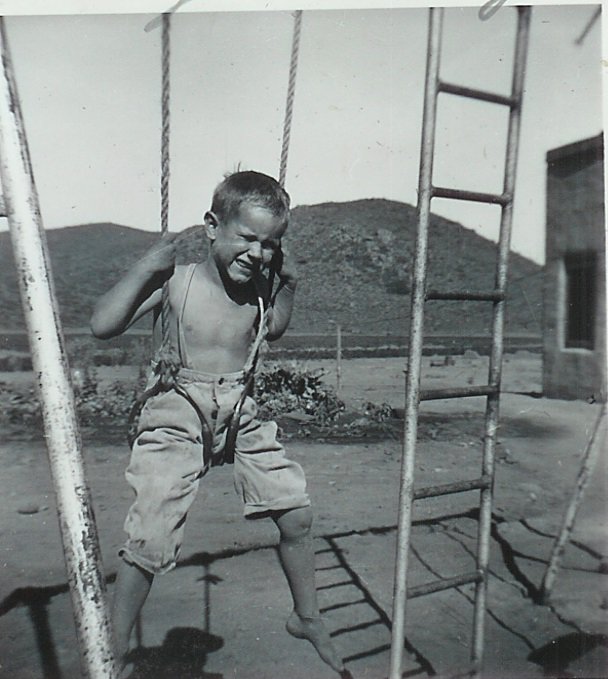
I should mention that we had moved into an area where there were no men with any kind of experience in farming. As a matter of fact, farming at that time was pretty much limited to the Maneadero valley, south of Ensenada. Of course there was some small- scale farming scattered about, but all done by hand and sometimes a mule. More like large gardens than farms. This meant that everyone we hired had to be trained to do the work, from tractor driving to irrigating to harvest. And of course Tom had no experience with tractors, so that part was left to me, and my knowledge was rather limited. So, you might say that the blind were leading the blind.

Pop Wilson had this swing set made in the welding class at Moorpark High
School.
When the ground was sufficiently dry after irrigation, we worked it up and planted our Fordhooks, using a four-row Ventura planter. As the beans grew, we cultivated, and made furrows, then watered and cultivated again. During this first year we did not even own a hoe. There were absolutely no weeds on this virgin ground. Iím not sure how many irrigations the beans got, but one too many, thatís for sure! Some beans were starting to mature in the pods, and others were just forming, so we felt that we must water to get these later ones to mature. Ralph Haven tried to talk us out of it, saying that it would be best to just take what we could get without more water. We didnít listen, and it was a huge mistake! The extra water kept the vines so active that the more mature beans started to sprout in the pods. As a result, when they were harvested and delivered to the Seed Company they would not meet germination requirements, even after several re-cleanings.
The two ranches went together to buy a bean thrasher. Lima Beans cannot be harvested with a general-purpose thrasher, such as those used for grain and corn. There were, to my knowledge, three small manufacturers in California that built all the bean thrashers. We ended up with a machine from the G. E. Price Co, in Costa Mesa. Getting it in to the ranch those last 15 miles was sort of tedious. At one place the road was too narrow, so we unhooked the truck that was towing it and towed it with a tractor down into the brush and back onto the road. I think we left it hooked to the tractor to go up the steep grade also.
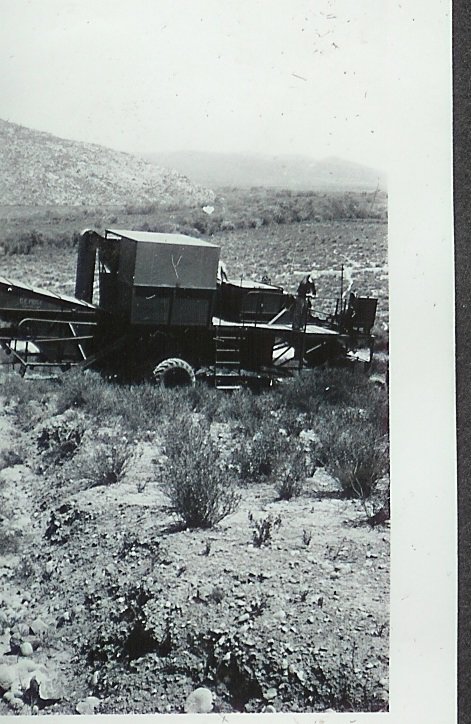
The
bean thrasher on the road to the Ranch
We bought a four row bean cutter, another specialized tool made in a blacksmith shop. This consisted of four long knives running about an inch or two below the surface of the ground, and four bars several inches above ground that pushed the two center rows together, and the two outside rows to the outside. Thus four rows became two rows of cut vines, making a path for the tractor and rake to go through, creating one windrow for every six or eight bean rows.
I think that trying to make those cutters work was the most frustrating thing I was ever involved with. They just would not seem to cut cleanly. Sometimes they would ride up on top of the ground, creating all sorts of havoc. Sometimes they would push the vines off the ends of the knives without completely severing the root. If the vines are not cut cleanly, the rake, in struggling to move them sideways tends to strip the pods from the vine. Every one that tried to help us had a different suggestion. The one thing that seemed obvious was that our little tractors did not have enough power to handle four knives. I took the two outside knives off in order to run at a higher speed so the knives had a tendency to slice, rather than push. This, along with tinkering with the angle and pitch of the knives made them cut much better, but certainly not like they should have.
Eventually we got them cut, raked, and thrashed. Gerry Price had come down to get us started with the bean thrasher, then I ran it the rest of the time. I had a tractor driver pulling the thrasher, a "jigger" filling the bags, and a sewer to close the bags. The thrasher worked well, except for an occasional plugging caused by the large cactus roots that had not yet disintegrated.
The harvested beans were then hauled to the Haven Seed Co. in Santa Ana, CA. At the border we had to pay a small export duty to Mexico, and another larger duty to the U.S. At Santa Ana the beans were cleaned, and cleaned, and then cleaned again. As I mentioned earlier, they never were able to make them meet the germination requirement. Also, we had lots and lots of cull beans. Tom found out that we could get a refund of the U.S. duties if we returned them to Mexico, since they were imported as seed but could not be sold as seed. Through a broker in Oxnard we were able to sell the clean beans for commercial use. I arranged with Juan Rudemetkin from Ensenada to take his semi truck to Santa Ana to load the beans. The duty was much lower on commercial beans than on seed beans, so we drove to the border, got credit for returning the seed beans, made a U-turn and imported them as commercial beans. We then delivered them to a warehouse in Oceanside.
Meanwhile we had been hauling all the culls back to the ranch in order to get back the duties we had paid. What to do with them was the next problem. Tom came up with the idea of going into the hog business, and feeding the beans to them. Of course we also cooked them for our own use. Thus, Lima beans will forever be referred to as "pig beans" in our family. More on the pigs later.
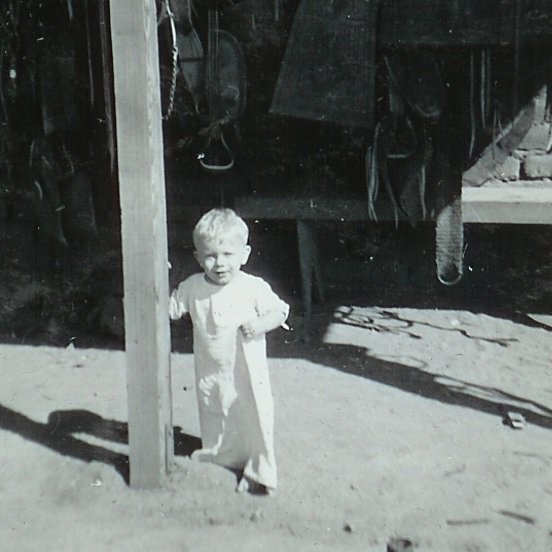
David
I mentioned that both ranches grew tomatoes. We both had our own seedbeds, and transplanted much the same way as I described in an earlier chapter. Of course we cultivated with tractors, rather than mules! There was one other difference, which turned out to be significant. Our seedbed was planted in the same field that would later become the larger tomato field. When it came time to dig the plants for transplanting, Tom suggested that we leave enough plants in place so that we would not have to transplant that area.
All was well until the plants got about a foot or more high and started bushing out. Suddenly they started to turn yellow and eventually die. Only about 15% survived. As time went on, I noticed that the plants in the original seedbed that had not been transplanted seemed to have a very good survival rate. At some point someone determined that the plants were dying from something called Western Yellow Blight. The plants were being infected by leafhoppers. By the time we understood the problem it was too late to try to control the leafhoppers. I reasoned that the plants that had not been weakened from transplanting were better able to fight off the blight.
As a result of this near failure of the tomatoes, and a drastic drop in the price of beans, Grampa and Uncle Jimmie decided to abandon their project in the fall of 1948. I think Grampaís health may have had something to do with it as well. He was over eighty years of age by then. Tom and Jimmie worked out some sort of arrangement for us to take over Rancho San Andres. I was not part of that negotiation, so I donít really know what the price and terms were. I do know that Grampa passed away within a year or two after that. Jimmie was anxious to settle his estate, so he offered a reduction in price in return for early payment. We managed that by selling two parcels of San Andres to Stuart Frazier and Bill Plourde. I was never at all involved in the financial end of the ranch, so all of this is a little fuzzy in my mind.
Haven Seed Co. was still interested in buying Tomato seed from us, so I convinced Tom that if we planted the seed directly in the field, with no transplanting, that we could grow a good crop. Also, we determined to have about twice as many plants per acre as normal. In that way even if we lost some to the blight, we would still have enough left for a normal crop. So, the plan for the next year was to plant about half of Santa Teresa to tomatoes and bell peppers for seed, and the rest to pink beans that could be sold in Mexico.
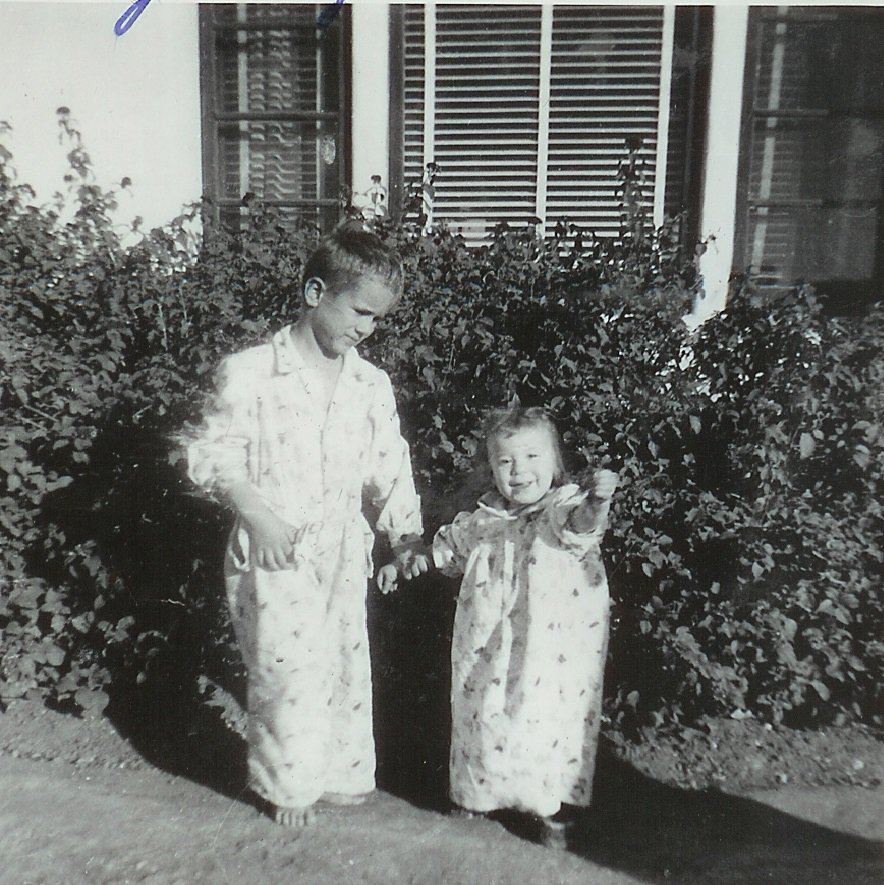
We were still in Simi.
During the very early stages of the development of the ranch I traveled back and forth a lot. I would spend a week or so in San Telmo, then a couple of weeks at home with Barbara. I can remember more than once working until noon or later, then driving straight through to Simi, arriving at midnight, or later. All this without freeways! Oh! To be young again! (And foolish!) Early on Tom bought a ford F-3 pickup, and later I bought one also. This made the commute easier. Some time during the commuting period my younger brother, Tommy, came down to work with us at the ranch. I canít put an exact time frame on how long he stayed at the ranch, but probably about two years. Also during the commuting time Barbara was carrying our third child, expected in April of 1948. I managed to be home when David Leigh arrived, one year and one day after Terry was born. So now we are five, including "almost" twin babies, getting ready to venture off to live in the wilderness. Talk about young and foolish!
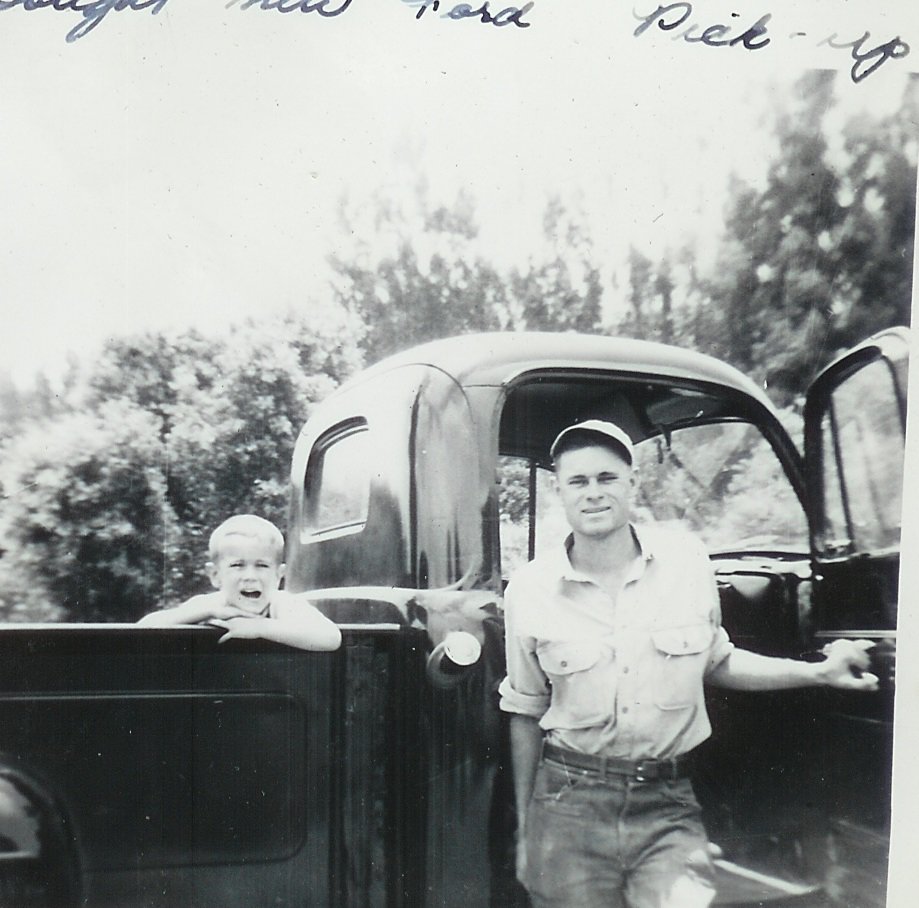
My new pickup
Dr. Shore, in Ventura, was our doctor at that time. I remember that he charged us $150 for pre-natal, delivery, and six weeks post-natal. Barb put $10 per month away to pay him. When we took David to him for the six-week checkup, we told him of our plans to move to a somewhat remote area of Mexico. Much to my surprise, he was not shocked and horrified. He applauded our spirit of adventure, and helped us with a list of medicines that we might need, and recommended some books on home health care.
Meanwhile, at San Telmo, the buildings At Rancho San Andres had all been completed. Besides the cookhouse, there was a large two-room building that was used for storage, and a larger yet, "L" shaped building that was two separate dwellings, with another storage room at one end. Ralph Haven lived in one wing, along with another man from Sata Ana that helped run the farming operation, or maybe ran the seed processing. I canít remember his name, or exactly what his duties were. He had a teenage daughter living with him, at least in the summer months. Later on, my folks moved into that wing of the house.
Andy Meling and his new wife moved into the other wing. They didnít stay very long before moving to California, where her parents lived. Tom arranged to rent that wing for the Leigh Robertson family. I donít know exactly when we made the move, but surely in the early summer.
The house, of course, was made of adobe blocks, with concrete floor. Inside, the walls were plastered with a mix of sand and clay soil, outside with cement plaster. The mud plaster was really quite satisfactory, once we got a coat of paint on it. We had a large kitchen-dining room, front room, bath, and a hallway leading to the bedroom, or possibly two small bedrooms. There was no closet, only a large wooden wardrobe type cabinet in the hall. The house had a covered, screened, porch on the inside of the "L", with walls about thirty inches high. One of my first projects was to make a partition, with a screen door, to create a bedroom for Danny.
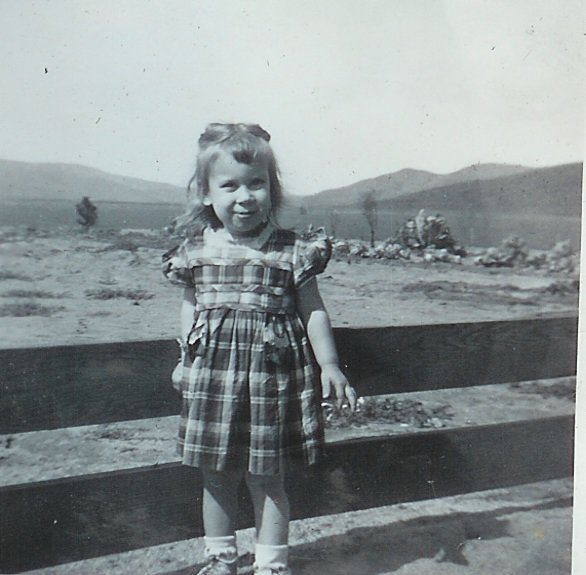
Terry, two years old.
We had been using electric appliances in Simi, so that meant we had to start over again with a butane stove and refrigerator. Barbaraís brother, Bob, had a pluming and appliance store in Moorpark at that time and he got us a good price on an OíKeefe & Merrit range that we picked up at a warehouse in Los Angeles. It was a great stove; four burners and a grill on top, with an oven and broiler below. In 1953, when we moved back to Simi, we brought the stove with us, setting it up out on the big porch, to serve as a second stove. It served us well, especially when we fed large groups, which we were known to do from time to time. When we sold that house, the stove was returned to Mexico, to be used in the house that Glenn built on his ranch up the canyon from San Miguel. I found a Servel gas refrigerator in Ensenada. They delivered and installed it for me. We also took our oil-burning space heater to install in the front room.
We had sold our í41 Ford sedan to have money to get the things we needed for the move, so that meant that there were five of us in the pickup. I donít have much memory of the move itself, but surely there had to be more than one trip to get all our belongings down to our new home in San Telmo.
My memory of the bedroom and sleeping arrangement that first year is unclear. What is clear in my mind is that the following summer we started the construction of a large bedroom for Barbara and me. What we ended up with was our room and two smaller bedrooms, as well as Dannyís room on the screen porch. I think it was in September, when the room was completed, except for the tarpaper on the roof, that we got some unseasonable rain that did some damage to the things that were already in the room. This experience was to be repeated a few years later, when I was adding on to the Chula Vista house. Oops, Iím getting ahead of myself!
Barbara had been using her motherís White Sewing Machine, which was electric. Now she needed a treadle machine. The problem was that no one sold treadle machines any more. We finally found a Singer in downtown Los Angeles. It cost $150. And the store agreed to let us make payments on it, even though they knew that we were taking it to Mexico. I was rather surprised at that. This was the first of only about a half-dozen times in our lives that we bought anything, other than houses, on time payments.
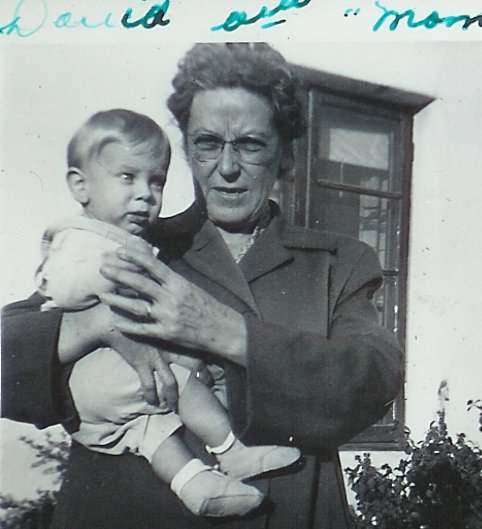
Mom Wilson and David
We did one rather extravagant thing when we were living in the "Lake House". Barbara found a carpet, or rather a large rug that she really liked, so we bought it to put in our front room. It fit nearly wall to wall, but we had to have one corner cut and bound, to accommodate the corner fireplace. Being the frugal couple that we are, we saved the cut piece, just in case. Well, "just in case" happened. We had the corner piece sewn back on, and our rug was installed in the new bedroom in Mexico, this time with two feet taken off one side. You guessed it! Later on that strip was sewn back on and the rug went into our bedroom in the "Big House" when we moved back to Simi! I would say that we got our moneyís worth from that rug.
We didnít have a washing machine for the first year or two. There was a set of stationary laundry tubs in the screen porch. So, the laundry was done using a scrubbing board, plunger and hand-operated wringer. Occasionally we hired someone to wash for us, but mostly Barbara did it. With Terry and David both in diapers, this was no small task! What? Paper diapers? Who ever heard of such a thing? Eventually, Bob Wilson brought us an electric machine, and heavier wire to bring power from the generator. The houses had been wired for lights only.
We soon discovered that the 7.5 KW generator, driven by a four cylinder Wisconsin engine, was too expensive to run every night. We bought kerosene lanterns for the house. They had glass tanks and chimneys. One night, as Danny was carrying a lighted lamp to his bedroom, he dropped it on the concrete floor of the porch. To this day, I canít imagine why it did not catch on fire, but it didnít! Poor Danny; he felt so badly about that. About a year later I was in Johnís shop in Fillmore, and one of his mechanics mentioned that he knew of a small generator for sale on a ranch in the hills south of Fillmore and Piru. It was a Saturday, and he offered to take me there when he got off work at noon. What we found was a generator like I have never seen, before, or since. It was a four cylinder, in line, water cooled Kohler engine, with a 1000 Watt DC generator. The owner said that it had been giving him some trouble, so he replaced it with a larger one. I thought that it would be perfect for running a few light bulbs, so I gave him the forty dollars he was asking. We took it back to the shop, and soon had it running. I took it back to the ranch, and set it up in the little room with the big generator. It handed our lights very nicely. I found that there was something missing in the control panel, but it did not seem to affect the performance in any way. On my next trip to San Diego, I found a Kohler dealer to ask about the missing part. He said that it was a demand switch that would start the engine whenever we turned on a light, and shut it down when the last light was turned off. I bought the switch, installed it, and it worked perfectly! The little engine only ran at 1000 RPM, and was very stingy with gas. It served us well.


During the first or second winter in the house we had a heavy rain that lasted for six days and seven nights, with no let-up. The little wash in front of the house, normally dry, became a raging stream, and ran water for two weeks after it stopped raining. Our adobe house didnít fare too well! The problem was that it had a shed roof, with no overhang at the top. The rainwater found itís way between the cement plaster and the adobes, eventually bringing little rivers of mud into the house, mainly around the doors and windows. When the roads were dry enough for me to get out, I brought some 1x12ís from Ensenada to nail over the ends of the rafters, then put heavy tarpaper over the peak of the roof and the new fascia boards. We never had any more leaks after that. A little patching, with cement on the outside, and mud plaster and paint on the inside, and we were as good as new!
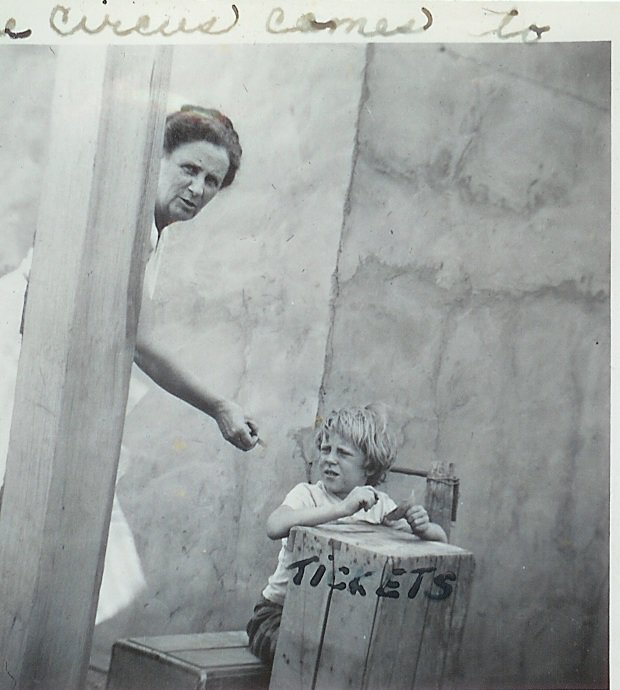
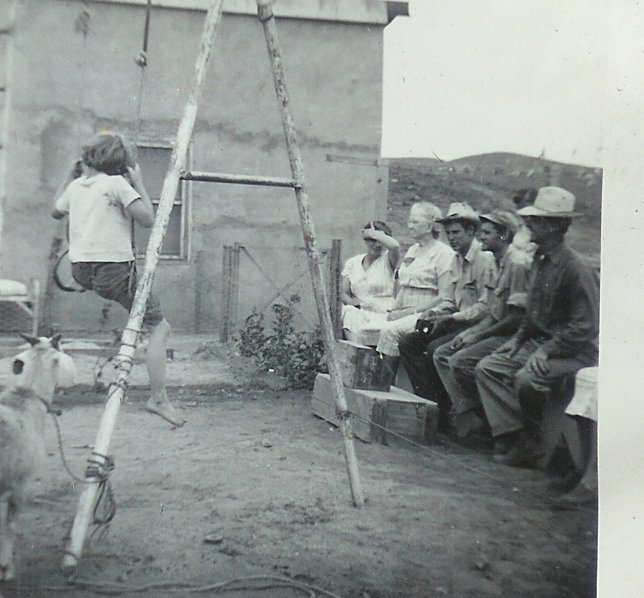

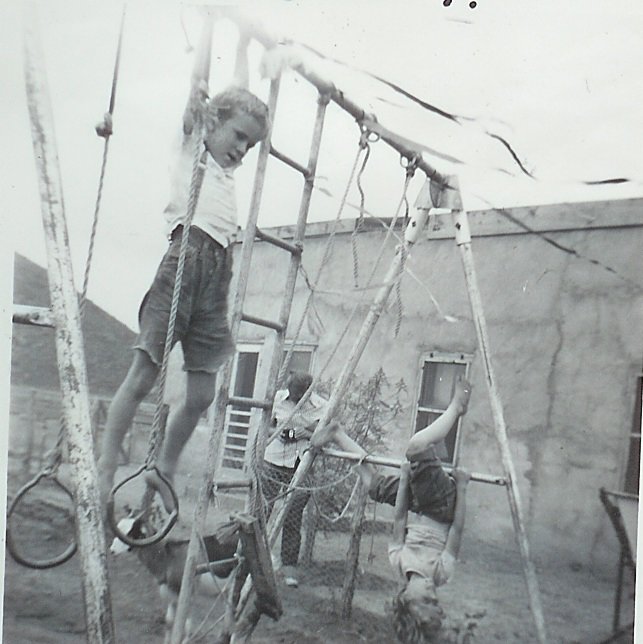

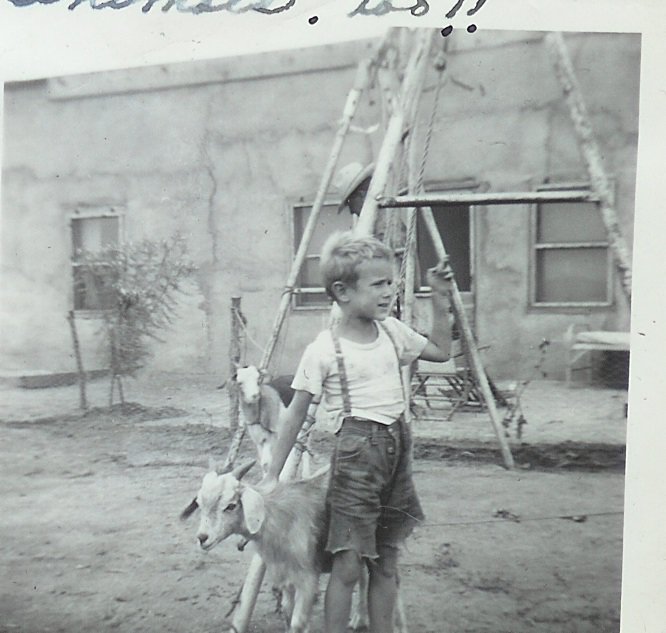
The
Circus comes to San Telmo, with daring acrobats, exotic animals, and refreshments.
They played to a rapt audience!
Tom made the acquaintance of a man in Tijuana who was the business agent for Miguel Aleman, president of Mexico. Sr. Aleman was developing a ranch near Tecate at that time. His agent had access to a small airplane, so possibly that was the motivation for our landing strip. It also is possible that my Uncle Jimmie Utt was a pilot, and that may have had something to do with it. I do know that Tom was flown in and out of the ranch a few times. Before we made the move to SanTelmo, Tomís father, "Dad" became very ill. We thought that Tom should know about Dadís condition, but there was no way to get in touch with him. In retrospect, I should have driven down to look for him, but chose instead a much more adventurous route. My cousin Mabel Hess had married a high school friend of mine, Bob Crowell. Bob had been an Air Force pilot during the war, and at that time was crop dusting for Murray Aviation, in Oxnard. He arranged with Murray to use an AT-6 that they had for personal use, not crop dusting. Iím sure that all of you know that an AT-6 was a widely used Advanced Trainer for fighter pilots during WW-2. It was built for performance, not comfort. It had two seats, in separate cockpits. We were able to communicate with microphone and headsets.
The plan was to leave Oxnard early in the morning, find Tom and be home before dark. Bob was flying into unknown territory, so I was the navigator. I knew that we should stop near the border to let US Customs know that we were flying into Mexico. At that time there was a small air field about two miles north of the border, Brown Field, I think, so that was our first stop. I got us there, using the tried and true navigational system know as IFR; No, not Instrument Flying Regulations, but I Follow Roads. The only problem was that when I pointed out the landing strip Bob spotted the old Airport just across the border in Mexico. I kept waiting for him to make a turn for the approach to Brown Field, but it wasnít happening, so I yelled that we were crossing the border. With that he did make a turn, hard and fast! By the time we came out of the turn I was pretty light headed. He calmly asked if I had felt that a little, saying that we had pulled about two "Gís"
After doing whatever it was we had to do at Brown, we hopped across the border to land at the old airfield in the Tijuana River Valley, near the Agua Caliente racetrack. We probably went through Customs and Immigration, then I started inquiring about Tom. No one seemed to know him, or his whereabouts. So, we took wing once again for the ranch. Once again, we more or less followed the road, straightening it out a bit, but keeping it in sight on one side or the other. South of San Vicente we lined up on the new high highway, and when it turned sharply right into Arroyo Seco, we continued straight ahead over some hills and came out almost exactly at the ranch. As we circled the little strip Bob commented that it was a little short for the AT-6, but we would be fine if he didnít waste any strip on the approach. To complicate matters, the approach called for making a "downwind" into the little Santa Terresa Valley, then a relatively tight turn into the final approach over a little hill that stuck out into the valley. He said that he would "fly" us all the way to the ground. "Well, I should hope so", I thought to myself, I sure didnít want to walk the rest of the way! I will say that he wasted less than thirty feet of runway and got us stopped with room to spare. He explained later that "flying" to the ground meant keeping the power on until the wheels touched the runway. The higher speed gave him better control of his aircraft.

Dan, Maryann, and goats, Blue and???
We soon found that Tom and his friend had flown in, and out, of the ranch that very morning. Off we went, hoping to catch up with him at the Tijuana airport. No such luck! This time I did find someone that knew where they were. Their plan was to stop in Ensenada for the night, returning in the morning. We left word that we would meet him there in the morning. Neither of us was excited at the prospect of spending the night in Tijuana, so we somehow made our way to the border, then caught a bus to San Diego. One tiny little problem was that we had expected to make the round trip in one day, therefore we had only a very few dollars between us. We shopped around in the downtown area and finally ended up in the Far Western, which turned out to be the hangout of sailors on leave, and flop-house in general! Next morning we were back on the bus to the border. Most of the passengers seemed to be heading for the racetrack. Most of them knew each other, so this was obviously a routine trip for them. They were busy telling each other of their surefire system for picking horses, and the "canít miss" winners of the day. It occurred to me that if I had a foolproof system for betting the horses, I would (1) keep it to myself, and (2) drive a new Cadillac to the track rather than ride this old bus!
We did hook up with Tom that morning, and, for reasons I donít remember, we all came back together in the AT-6. This meant that Tom crawled into the rear cockpit first and I somehow got in and sat on his lap all the way home. What a long, uncomfortable trip that was! The plan, from the beginning, was to fly into Santa Susana. As we approached Los Angeles, we ran into some overcast that we had to stay beneath. By the time we were over San Fernando Valley we were too low to get over the pass into Simi Valley and Santa Susana Airport. "No problem" said Bob. "Iíve done this hundreds of times". The method was to line up on Devonshire Blvd., fly west to Topanga Canyon Blvd, climb to a certain elevation, then, in a certain number of minutes, drop through the clouds into Simi Valley. O.K! Sure enough, when we broke out of the clouds, we were just where we were supposed to be. It worked for us, but I hope that none of you who are flyers ever get that confident.

Davidís first steps
I mentioned that we had decided to get into the hog business. Tom sent for all sorts of publications from the University of California pertaining to hogs. We started with six or eight young sows and a young boar from a different bloodline. They were of some newly developed breed that was supposed to grow very fast. The first thing we found was that they would not eat our cull Lima beans unless we cooked them first! I cut a 55-gallon barrel in two, the long way, placed it on a firebox of adobe bricks and we were in business. It soon became apparent that gathering wood for the fire was out of the question, so I created a crude burner out of pipe and fed it from a barrel of diesel fuel nearby. In a few months the sows were bred, and some time later delivered their litters. When all the new pigs were old enough to be weaned it became clear that our supply of cull beans was not going to last very long. One of the UC booklets promoted the idea of pasturing hogs on alfalfa, so that was the next project.
By this time we had taken over Rancho San Andres from Grampa and Jimmie. We chose to put the alfalfa on some red ground on the south side of the valley, across the wash from our houses. This was good, in that we could irrigate that field directly from one of the wells, without going through a booster. However, since we planned to use the "flood" system of irrigating, it turned out to be a bad choice. This field had way too much fall for flood irrigating. Instead of spreading out to cover all the area between checks, it just flowed downhill in a narrow path. We should have planted some ground in the center of the valley, which was almost flat. As a result, we had a very spotted field of alfalfa. Then, when we turned the hogs in to graze, they started rooting it up!
When we finally had hogs ready for market, Tom took a few to Tijuana where he found a buyer. When he went back to arrange for more sales, the buyer said that our hogs tasted like fish, and he wanted nothing to do with them! We deduced that the fish flavor was the result of being fed green alfalfa, and the only solution was to feed them grain for several weeks to clean them up. Of course we had no grain, so we had to buy it. This meant that an enterprise that was started in order to use up the cull Lima beans turned into an exercise in buying grain where we could, hauling it to the ranch, then hauling the hogs 100 or 160 miles to market. Would this make a good script for a Keystone Cops movie?
We were able to sell hogs for market after "graining" them, but it was obvious that we had a long way to go to make the operation profitable. It was taking twice as long as we anticipated to get our hogs to market weight, about 200 lbs. Therefor, our costs were very high. Another thing that we had not anticipated was that there did not seem to be any buyers, or brokers to buy a large truckload of hogs, or beans, or any of the staple foods of Mexico. This meant that we could only sell a few hogs, or, later on, a few bags of pink beans at a time.
While the rest of the hogs grew slowly, our boar seemed to do nothing but grow. We couldnít keep him in a pen. I well remember the last effort we made. I had a pen made of hog wire, buried a foot in the ground, and about four feet high. Many juniper posts, wired horizontally around the wire fence backed this up. I was confident that we had finally "penned him in". When we turned the boar into his new home, he first tried to root under the wire, to no avail. Then he just stood, gazing at this latest affront to his freedom. Finally he turned to look at me. I swear that he looked amused by all this. Then, he simply raised up on his hind legs and came crashing down on the fence, reducing it to a tangle of wire and splintered wood. He gave me one more quizzical look, as if to say "what next?"
I donít know for sure how long we had hogs: two years, for sure, maybe three. Finally, we sold all of them to a man that was starting a ranch in La Calentura, about 30 miles north of us. I will have to say, that was one of the happiest days of my time in San Telmo. I swore that I would never again have anything to do with livestock. Wait a minute! Didnít I make that same statement after a summer of milking Alanís cow? Why are some lessons so hard to learn?
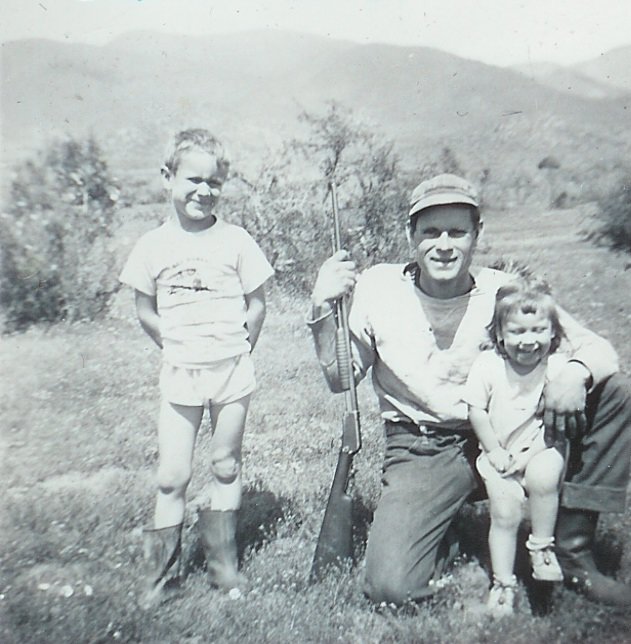
Danny, Leigh, Terry, hunting jackrabbits
Our second year in SanTelmo brought many changes. First of all, we took over Grampa Uttís Rancho San Andres. Tom and Dorothy moved into the other wing of the house. With the ranch we got the two wells, with pumps and engines, and the domestic water system. We also got two small high clearance tractors for cultivating tomatoes. I remember making a separate deal for the GMC truck. We only hired a few of the men that had been working on San Andres. We tried to create enough housing for the men, and families, which meant that we could close the cookhouse. The small store in San Telmo was barely surviving, and no one working for us had a car, so we had to have our own store. Thatís a story unto itself.

Employee Housing, Santa Teresa Valley in the background
We set aside one room in the storage building for our little store. We stocked mostly the basics; coffee, sugar, salt, flour, baking powder, lard, tomato sauce, canned Chile Serrano, canned sardines, soap, crackers, beans, rice, and from time to time, candy bars. Surely there were other things that I canít recall. Most of this came from Ensenada, but we also brought some things from Smart and Final in San Diego. Our mark-up was about 10%, which hardly covered the transportation. We kept a running tab for all our workers, then deducted that from their pay. Some managed to get well ahead, and others were always behind. And of course, since they had no way to get to town, every time I went to Ensenada, I had a long list of things to buy for various people; shoes, boots, Levi trousers and jackets, and much more. I tried my best to establish regular hours for the store, other than working hours, and also a regular Saturday afternoon to review accounts. I even made an attempt to have enough cash on hand to pay in cash, and put the store on a cash basis. Needless to say, I failed in all of this, for various reasons. Paying in cash was very difficult because cash was only available in Ensenada, and I wasnít comfortable with having too much on hand at any one time. The regular hours and days concept was difficult because when Tom and Dorothy were there, one of them was apt to handle those chores, and they were much more obliging than I was! All in all, the whole system added lots of hours to my workweek.
It was Tomís nature to have many, and varied interests. Some of these kept him away from the ranch for extended periods, leaving me in sole charge. During these times I did things in the way that I was comfortable with. Then, when he returned, he wanted them done in a different manner. I was sort of on a see-saw, but he had all the experience, and I was just a minor partner, so his judgement prevailed in most cases. I donít say any of this to be critical of my father, only to explain some of the difficulties in a family partnership.
During the winter of 48-49 we cleared all the windrows of mescal that we had created in the Santa Terresa valley. We burned them as best we could, then loaded, by hand, what was left onto our old truck, to be hauled away. This meant that we now had totally cleared as much ground as we could get water to. What a relief to be able to plow, disc, harrow and plant a complete field, without working between windrows!
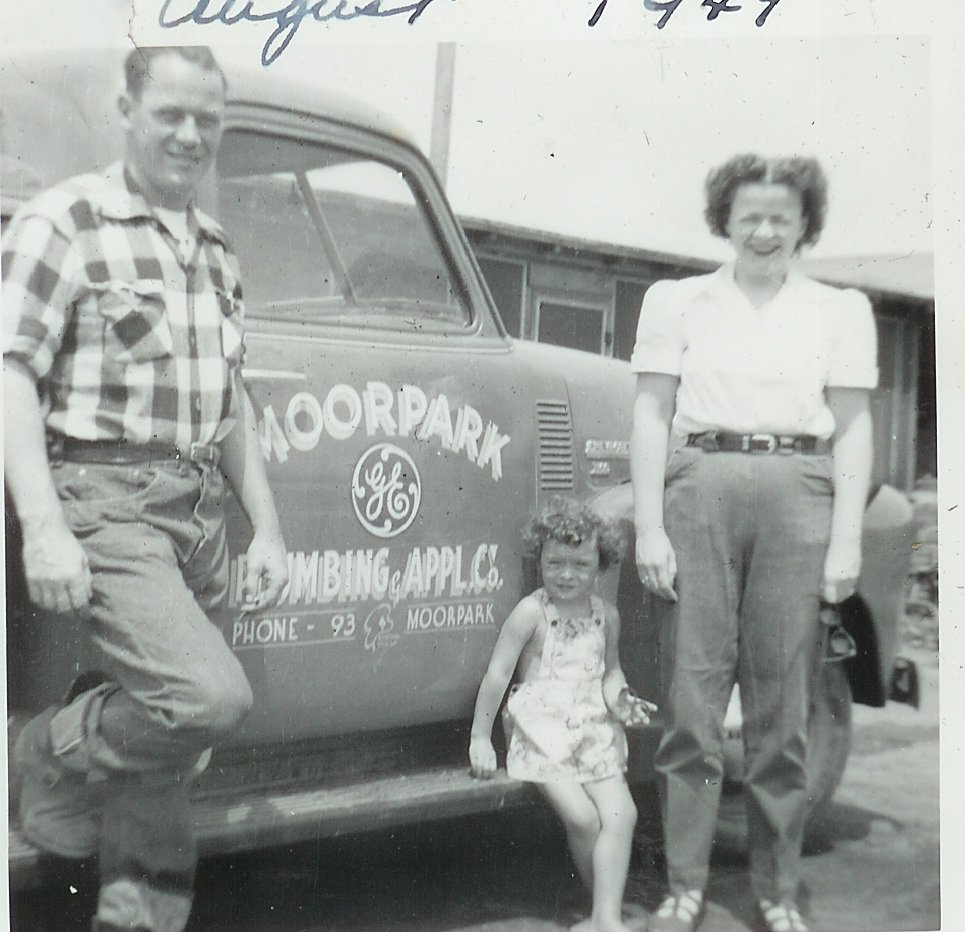
Bob, Marcella
and Katherine arrive for a visit, bringing us a WASHING MACHINE!
We planted about 40 or 50 acres of tomatoes, using the method I had suggested. The rows were 60 inches apart, so that the tractors could work either beans or tomatoes without changing the wheel spacing. The seed was placed about an inch under the ground. We made a furrow on each side of the seed-row, as close as possible. Then we ran water in the furrows until the moisture had reached the seed. All that was left to do was wait for the seed to come up, which it did in about ten or twelve days. When the plants were about 4 or 5 inches tall, we started to thin them out with hoes, leaving a plant about every foot, instead of every five feet, as they would have been if we transplanted. The ranch was still relatively weed-free, so the thinning process was not too difficult. When the ground was dry enough, we started the tractors working to cultivate the soil, cover the two furrows, and create a new one in the center between rows. Now we waited for the moment of truth, to see if we would have a healthy field after the leafhoppers came in. To our delight, we lost very few plants. In the fall we had a very good harvest of tomato seed. I think that we grew tomatoes for three years, until Haven Seed co. went out of business.
The method used at that time to break down the jelly sack that surrounds the seed was to let it ferment for a day or two. The "Seed Plant" consisted of two large, round, redwood tanks. Next to the tanks was an earthen ramp. The wagons, with long, waterproof boxes, were pulled up onto the ramp and the rear gate of the box removed. The tomatoes were then shoveled out the back into a hopper that fed into a chopper, which then fed to one or the other of the fermenting tanks. In warm weather the seed was ready to be washed in one day. In cooler weather it took two days, thus two tanks. When it was time, the gate at the bottom of the tank was opened into a long wooden flume that had a very gradual fall. At intervals in the flume were what we called "riffle gates". These were just pieces of wood about three inches high that could be inserted and removed at will. After the juice had drained from the tank, a stream of water was started near the outlet gate in order to move the pulp out of the tank. As this mixture of pulp, seed, and water moved along the flume, the seed, being heavier, went to the bottom and collected behind the riffle gates. The pulp, being lighter, floated on out the end of the flume and into evaporation ponds. When the tank was empty, the seed in back of the riffle gates was stirred gently to float out any remaining pulp. After that the flow of water, at the lower end of the flume, was diverted into a deep seed collecting box. The riffle gates were then removed, one at a time, starting at the lower end. When all the seed had been collected the flow of water was stopped. We used a two-inch molasses valve to drain the seed into a heavy cloth bag, which let the water go through and retained the seed. This bag was put into a converted "spin dry" washing machine tub to extract as much water as possible The seed was then put into drying trays, to dry in the sun. These trays were about 20X40 inches, 4 inches high, with screen bottoms for air circulation. The seed was not more than Ĺ inch deep, and required frequent stirring to keep it from sticking together in lumps. Rubbing them between our hands could break up any lumps that formed.
Some of our ancestors used flumes and riffle gates to separate gold from sand and gravel in the gold rush days of California.
In 1949 we also grew some Bell Peppers for seed. Late in the season, when the price of peppers was very high, we took a pickup load to sell on the fresh market. That provided all of us with a little Christmas money.
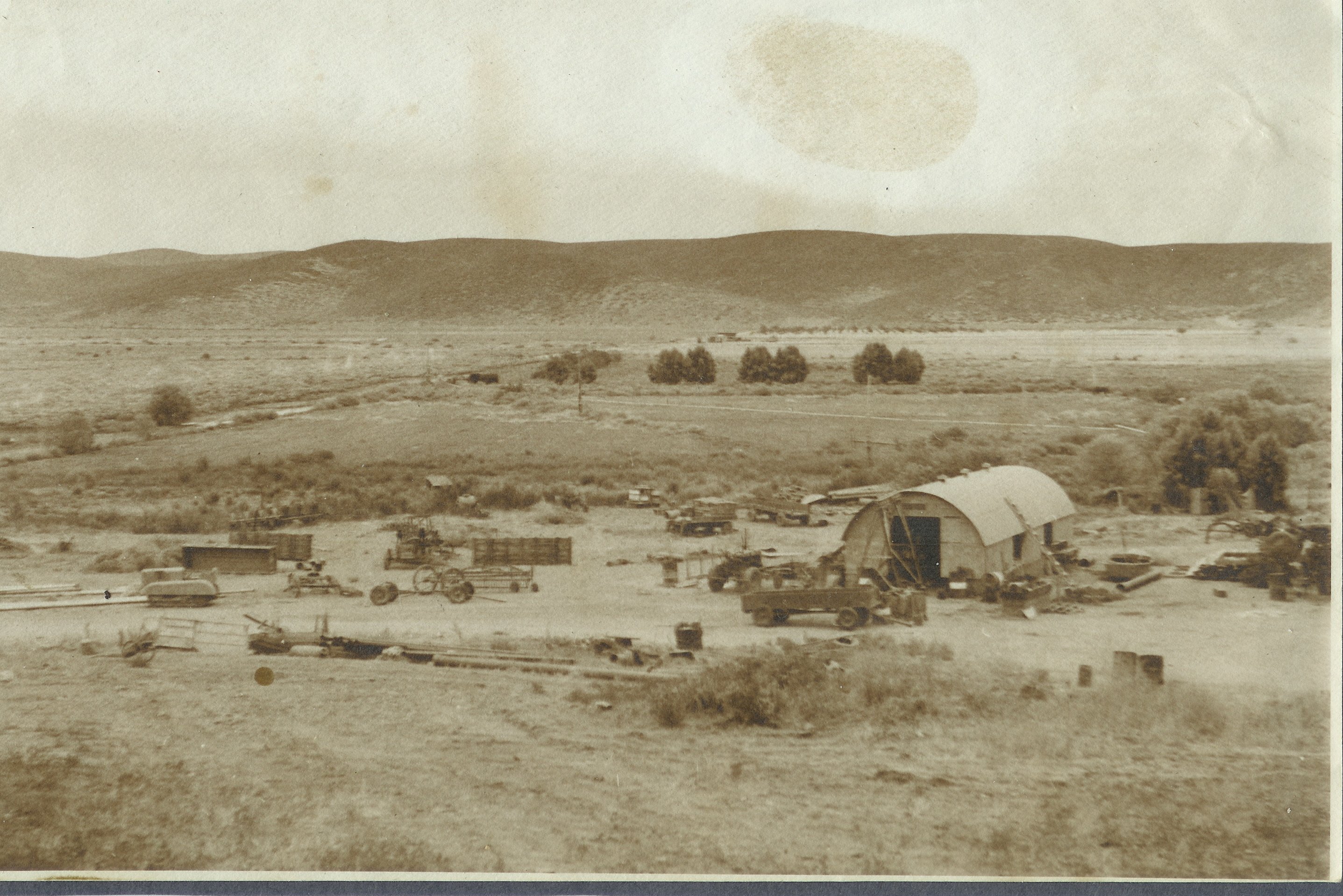
Quonset Hut, with San Telmo Valley in the background
I think that in this same year I brought down the Quonset Hut we had purchased in 1946. We had not found a use for it at Sinaloa Ranch. I had a concrete slab poured long enough to hold the Quonset, with a large apron in front. Using flat surfaced stone from a hillside a couple of miles up the San Telmo valley, we built walls about two feet high to serve as foundation for the Hut. This gave us six feet of headroom at the sides. I built shelves, and bins to hold the many supplies that we needed toward the front, leaving a small work area just inside the door. We had a large A-Frame on casters, with a chain hoist hanging from it. This we kept on the apron.
It was probably a year later that we built a large warehouse of adobes to store crops in. I can remember having it nearly full of either pink beans or barley. Someone suggested that the crop should be protected from rodents and bugs by fumigation. The method of fumigating was to open a number of canisters of Chloropicrin at various locations in the warehouse. All of this sounded easy, until I realized that Chloropicrin and tear gas are the same thing. I managed this encounter by starting at the back end, taking a deep breath, then releasing two canisters, scrambling quickly towards the open door, releasing canisters as I went, then closing and sealing the door.

Leigh and Barbara residence in the left wing of the large building,. Tom and Dorothy in the right wing. The middle building was half storage and half our little store.
Epifanio Rendon and his wife lived in the building on the right.
The rest of the ranch was planted to pink beans, for sale in Mexico. I think they produced OK, but we ran into the marketing problem that I mentioned earlier. We finally rented a small house in Ensenada, and filled one room with bags of beans. Tom had located a man, Sr. Preciado, who had a retail market, and also did some wholesaling. We arranged to buy all our groceries from him for our little store, and he would buy several bags of beans at a time from us. It was a slow process, but we did move all the beans.
Early in this second year two strangers arrived at the ranch who would change our focus and direction in the following years. They introduced themselves as Al Condit and Howard Peto. Al was manager of the Santa Paula Division of Burpee Seed Co. and Howard worked for him, as a plant breeder, I think. They were interested in growing seeds in a place where costs were low, and there was plenty of room for the isolation of varieties, to prevent cross-pollination. We made a deal to grow some small plots of Zinnias and Marigolds, on a trial basis. These plots turned out rather well, so Al and Howard recommended to the company that they move a substantial part of their production to our ranch. As a result, they brought Bill Burpee and W.Atlee Burpee 3rd to see the ranch and OK the project. We sat on the screen porch and worked out a deal to grow seed at a discount to what they were paying in Santa Paula. They also decided to put in a trial plot of exotic plants that were still in the development stage. To conduct these trials, and oversee our production, they sent a very nice young graduate of New Mexico A&M, John Sais. John lived in the small, old travel trailer that Al and Howard had brought down to stay in during their visits to the ranch.
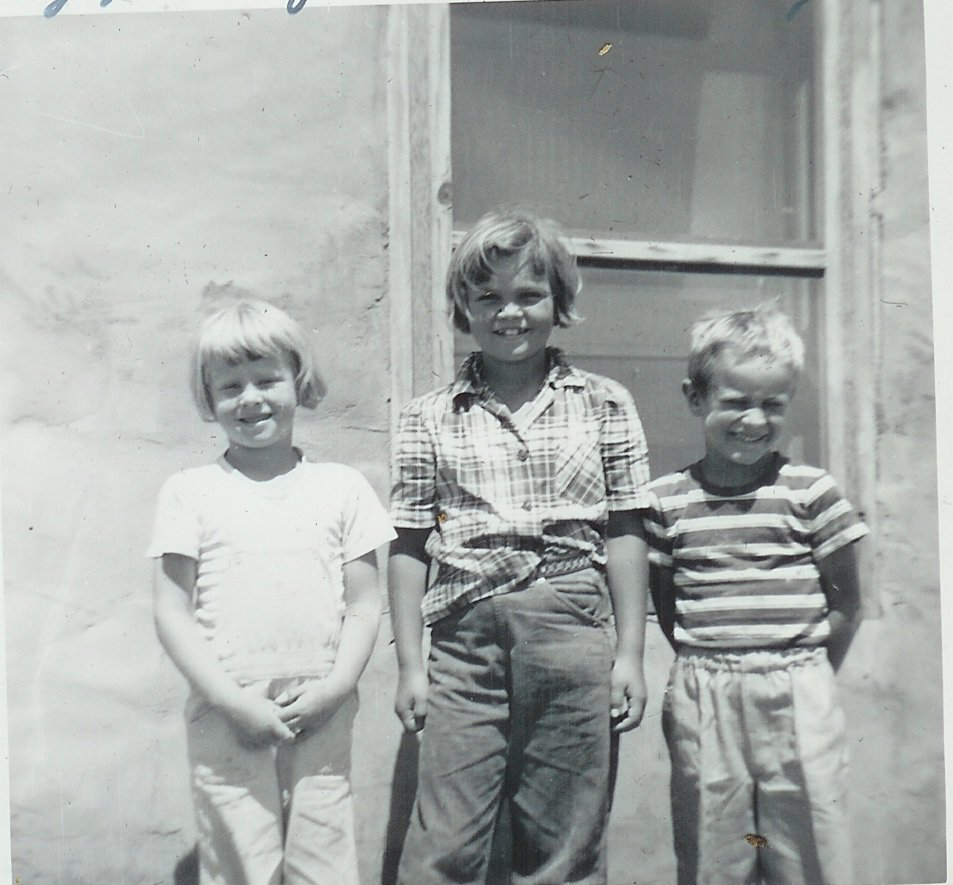
Marilyn and Janice Condit, Danny
The following year we had a considerable acreage of Zinnias and Marigolds, as well as ten acres of hybrid cucumbers. The cucumbers were planted three rows of the female parent, then one row of the male parent, alternating across the field. When the plants started to bloom, we had a crew go through every day to remove all the male flowers from the female plants, so that the only pollen present was from the male plants. It took a little while to educate the crew as to which flowers to remove. Before harvesting, the male rows were destroyed somehow. I canít remember how we did that!
These new crops meant that we needed some special harvest equipment. For the flowers, Al suggested that we buy a used Allis Chalmers Allcrop that Burpee had traded in on a new one. This was a small grain harvester that worked well for thrashing the flower seeds. I loaded the harvester on a truck, then went to Santa Paula to pick up a dozen stands of bees, to place in the Cucumbers, for pollination. The hives were sealed, but there were still a few bees hovering about. I parked the truck at the folksí house in Simi, and left early the next morning. At every stop I made, it seemed like there were a few more bees hovering about. I managed to get stung a couple of times, once near one of my eyes. By the time I reached the border one eye was swollen nearly shut, and my bees were getting a little angry! The customs inspector took one look at the situation and waved me on through! I was sure glad to get that cargo delivered and unloaded!
Burpee loaned us what they called a "cucerbit" harvester. This consisted of a large horizontal, rotating drum. This drum was made of a perforated metal sheet. I think that as the drum turned, the cucumbers broke up, the seed went through the perforations into a collecting tank, and the pulp went out the low end of the drum. We used this harvester for some watermelons we planted the next year. The watermelons turned out to be a disaster. As they started to ripen, the coyotes came in for a feast! We were able to harvest only a small part of the crop. Live and learn!
Speaking of animal pests, we were invaded by jackrabbits from the beginning. We went out most evenings to shoot them with shotgun or .22 rifle, but didnít make a dent in the population. Finally, we bought a mile, or more, of 30-inch chicken wire to fence all of the Santa Terresa. That did the job pretty well, along with an occasional evening patrol.
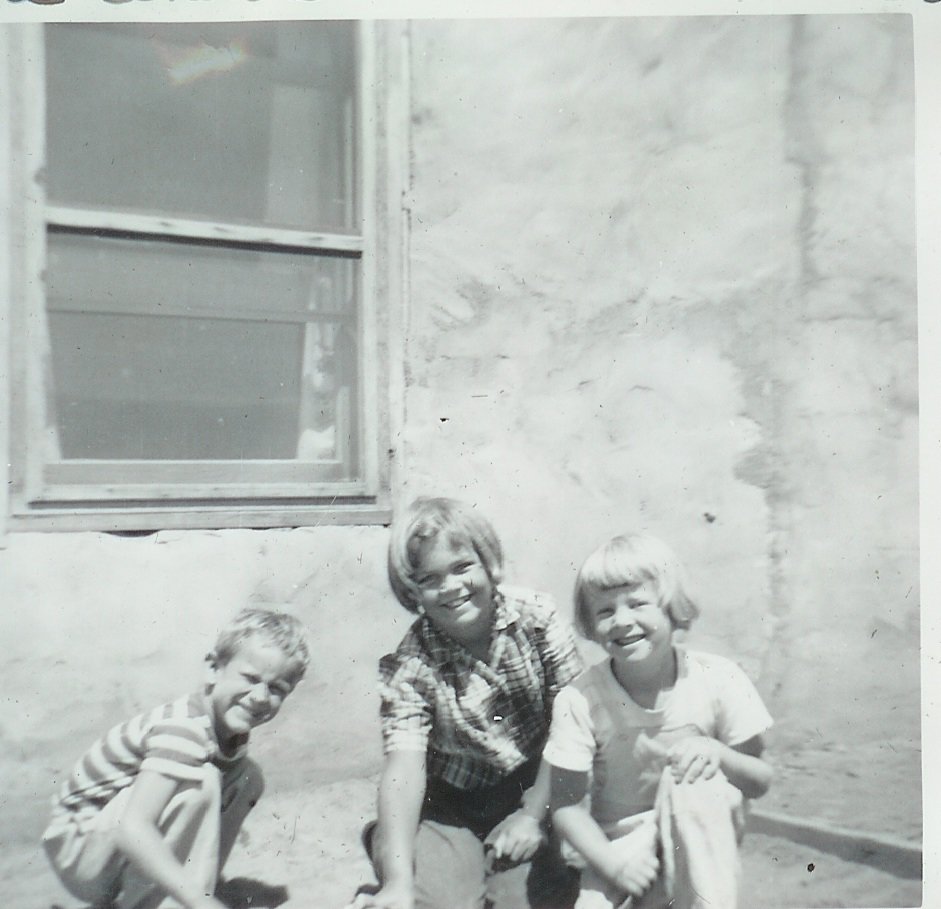
Danny, with Janice
and Marilyn Condit
For three years, nearly all our effort went into seed production. We grew tomatoes and bell peppers (California Wonder) for Haven Seed Co, and flowers and vegetables for Burpee. Along the way, I learned a little about processing the seed, and the importance of keeping accurate records. I supervised the tomato seed plant, as well as doing some of the work. I have described this process in an addendum to the "Growing Up" story. Our plant in San Telmo was nearly a duplicate of the one in Simi. During the drying process, I placed a tag with lot number, harvest date and variety in each drying tray. Then, when we bagged the seed, a tag with lot number and variety went inside the bag, and another on the outside. I logged all of this into a notebook. These records came in very handy on at least one occasion. Soon after I moved the family to Chula Vista, I got a call from Laurence Haven. He was obviously disturbed, but said he did not want to talk on the phone. He drove down to tell me in person about the problem. He said that as he was re-cleaning a batch of seed, he saw some bits of tomato skin that were yellow, rather than red. We had grown a small acreage of a yellow- skin tomato for him, but the problem was that the tag indicated that they were of the red-skin variety. By going over my records, we were able to determine that there was only the one mislabeled bag.
I also learned about walking the fields to look for, and remove "rogue" plants; in other words, plants of a different variety. Naturally, the seed needs to be of only one variety. I also walked the bell pepper fields, searching for, and marking plants that had exceptionally uniform shaped fruit in large numbers. These plants were harvested separately, to provide seed stock for the following year.
The flowers were picked by hand, after they were mostly dry. They were then spread out on large canvasses to dry thoroughly in the sun. When needed, we could pull one edge of the canvass over the top to keep them dry. When they were good and dry, we shoveled them into the little thrasher. When the machine was properly adjusted, we got reasonably clean seed into the bags.
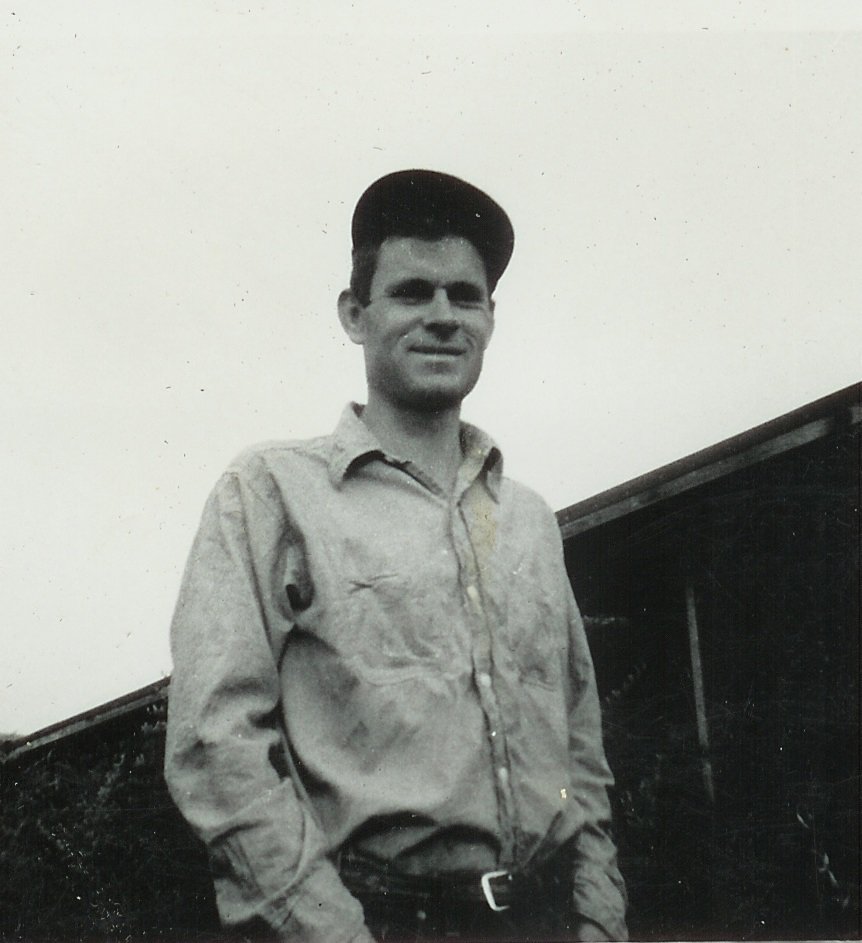
Leigh, ready for
work
Zinnias seemed to be the best producing of the flower seeds. After two or three years of growing them, Burpee gave us a contract to grow 100 acres of a new variety that had been under development for several years. They wanted to hit the market with a splash, and in a big way. Also, they did not want their competitors to know about this radical new flower. I canít bring back the name of it, (Dalia-flowerred Zinnia, I think)but it was a flower of greater size, with about twice as many petals as a normal zinnia. The plants grew tall, and were absolutely covered with flowers. Santa Terresa Valley looked like a sea of yellow and red. We were certain that this would be the bonanza crop that we had been waiting for. Since they had not grown this crop before, and had no way of predicting
what the production would be, we were to be paid a small premium for it. Al Condit came to look at the field when it was in full bloom. He spotted something that we had missed; mildew was starting to form on the plants, and he was worried that it could affect the plantsí ability to mature the crop. The standard, and only, treatment for mildew in those days was sulfur dust. It was used on many crops. Al talked to Tom about how much dust to apply per acre, and Tom drove over to Mexicali to find a crop duster to apply the sulfur. Somewhere along the line Al didnít make it clear that he was talking about dust that was 20% sulfur, so Tom ordered 100% sulfur. The pilot of the duster that arrived at our little airstrip turned out to be a classmate of mine, Joe Hitch. He spent the night with us, then flew the sulfur onto our fields the next morning. A few days later our beautiful field of zinnias started to turn brown. We called Al to come back down to see what was going on. Thatís when we figured out the misunderstanding about the strength of the sulfur dust. There was nothing to be done but wait, and hope for the best.
I could tell by squeezing the flowers that the seed was not filling well. When we picked them and started thrashing, way too much light seed was going off the back of the thrasher and the bags of seed were very light. About this time Haven Seed Co. decided that they could not stay in business, and we acquired from them what is called a "fanning mill". We used this to clean the seed before shipping it. This eliminated a fair portion of the seed that was not going to germinate, thereby saving us some export and import duties at the border. Burpee had to use even more sophisticated cleaners to salvage what seed that was viable. Our bonanza crop had quickly become a disaster.
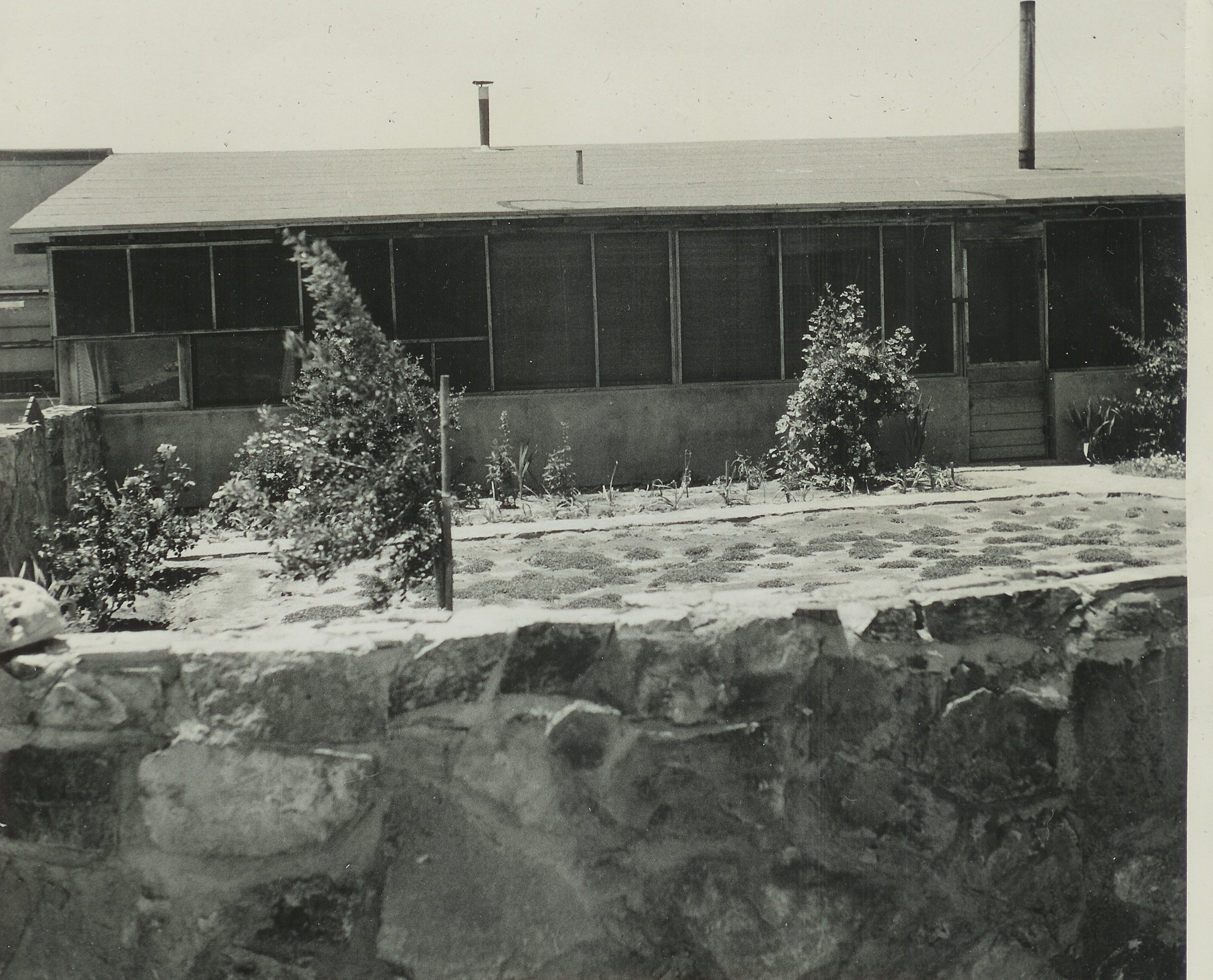
This was our home from 1948 to 1953
There were a number of developments in 1950, 51 and 52. Iím not sure I can put them in their proper sequence, but then, who can challenge me! Starting with the most important, we were expecting another child in the spring of 1950. We talked it over quite a bit, and thought that it was important to have this child born in the US. After all, we should not be making the decision for him about being born in Mexico. So, when the time approached, I moved the family back to Simi. By this time, Barbaraís parents were living in the lake house, so she moved in with them. We went to see Dr. Shore, and he said that everything was fine, but the baby was two or three weeks away. I decided to go back to the ranch for ten days, then come back up. About three days later, Al Condit arrived at the ranch on one of his visits. When he got out of his car, he handed me a greeting card. When I opened it, I discovered that I was the father of a new baby boy. Needless to say, I threw a few things in the pickup and made a mad dash for Simi. Barbara was still in the hospital, so I went there to see her, and our son, who we named Glenn Thomas. I stayed a few days, long enough to get the two of them settled in with her folks again. She stayed there for several weeks, until Dr. Shore thought it was all right to go back to the ranch. I recall a small crisis after returning to our house. It seemed as though this baby was not content to finish his bottle and leave it in his crib. He had to somehow push it out, onto the concrete floor. This was awfully hard on glass bottles! In no time at all, we were down to two bottles. We came up with the idea of tying a loop, just large enough to fit under the screw-top of the bottle, on one end of a string that was fastened to the top rail of the crib. This may not have been the safest arrangement, but it did serve the purpose!
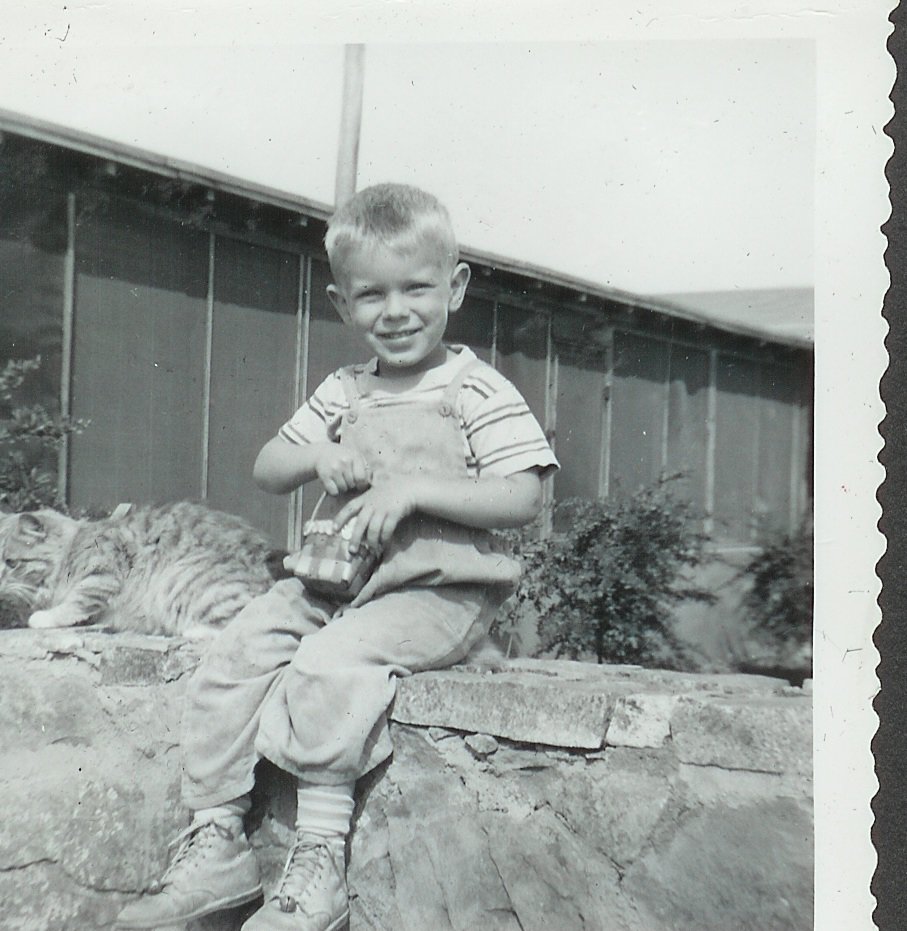
David, on the garden wall
A young man drove into the ranch one day and introduced himself as Pedro Pedroarena. He said that he was going to be farming next door to us. A man named Ed Lasalle had bought the Bernardo Castro ranch, and the two of them were partners in the farming operation. I soon got well acquainted with both of them. Ed was the owner of a fleet of about 30 tank trucks that hauled almost all the fuel from San Diego to Tijuana, Ensenada, Tecate, and Mexicali. At that time, all the fuel used in northern Baja came from the U.S. He told me of getting his start in the trucking business as a teenager, driving between Tijuana and Mexicali over the old Rumorosa grade. He said that the switch-backs were so tight that even his two-axle truck had to be backed up, then forward again to get around them! I had heard other tales of that grade, but never experienced it until 1999. By then it was a paved, divided highway, but still formidable. I could see parts of the old road, and dozens of wrecked, abandoned vehicles. Ed named his ranch "Hacienda Sinaloa". Now, how can you not like a man that chooses that name for his ranch? For all his success, he turned out to be a very down to earth, old-shoe sort of person.
I didnít know it at the time, but the Pedroarena family dated back to the mission days of Baja California, and what is now California. Pedro grew up on the family ranch near Tecate, went to school at UC Davis, and owned his own ranch a few miles east and south of Tijuana. He called it the Pinacate Ranch. As you all know, pinacate means stinkbug. I understood the name when I drove out there. The country was all a series of perfectly rounded hills, resembling stinkbugs!
Pedro and Ed planted the entire ranch to barley, I think, or maybe wheat. They had sprinklers to irrigate as needed. The first year they planted was a good rain year, so I planted all the non-irrigated land we had to barley and wheat, and we got a nice crop. That meant that there were going to be many truckloads of grain hauled out of the valley after harvest. Pedro suggested that we improve the road in a few places, so that we could get our trucks in and out easier. Pedro, Ed, and I took a little tour of the road to decide just what needed to be done. When we stood at the top of the high ridge just east of the town of San Telmo, looking at the very steep, rutted grades on either side, I came up with a plan to cure that problem. I suggested that we start up the side of the ridge far enough up the valley to make a gradual climb to the top, then drop down the same way, on a gentle grade that would take us in back of the town. They liked the idea, so we cleared it with the people in town. No one seemed to really own the land, it was just used as needed. I sent our bulldozer and operator, and Pedro sent his larger, D-6, dozer and operator. We re-routed the road in a few other places to avoid some nasty spots. When we finished, we had a much-improved road. The road has been rebuilt several times since then, but if you travel it today, you will travel on the same road that I laid out over the high, steep ridge. That may be the most enduring mark that I left in San Telmo!
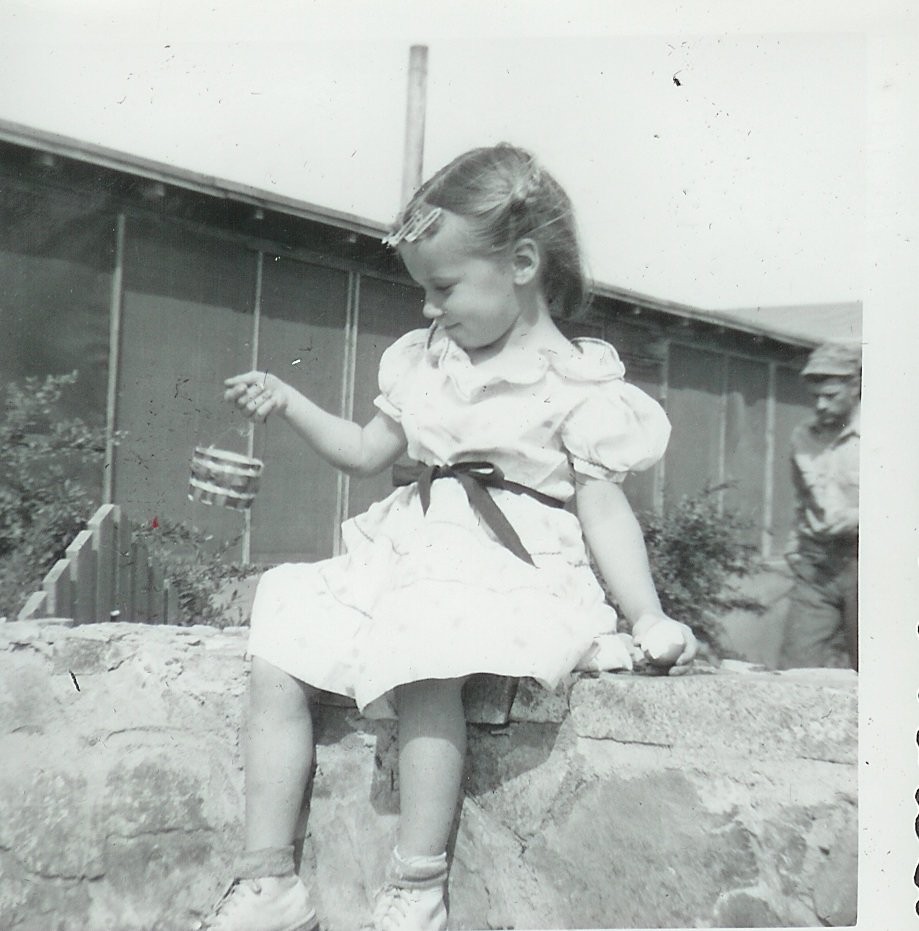
Terry on the wall. It looks like Easter!
Another fateful event was the appearance at our ranch of a man named Stuart Frasier. He introduced himself as an aviation engineer, working at Ryan Aircraft Co. in Chula Vista. He said that he wanted to leave that work, and was thinking of farming in Baja. He had no background in farming, so I donít know why he chose that as his next endeavor. At the time, I didnít think much about how he found us, but recently I may have found the answer to that. Near Colonia Guerrero was a guest ranch, known and frequented by virtually all American tourists who ventured that far south in the early days, the Hamilton Ranch. "Miss Hattie" Hamilton operated it for many years. She was the niece of a Mr. Young, owner and operator of the Valledares mine, in the foothills of the San Pedro Martir mountains. (For those of you fortunate enough to have made the trip to those mountains with me in 1992, he was responsible for Youngís Ditch, near La Zanja and Campo Contento). In the forties and fifties it was operated by at least two other families, and has now fallen into ruin. On a recent trip to San Quintin and the Colonia area, I had the opportunity to go through two old Guest Registers that had been salvaged by friends of Gerry, who is overseeing the production of strawberries in that area. In one of those books, I came across the name of Stuart Frasier, of La Jolla. All of that country was very sparsely settled at that time, and surely the folks at the Hamilton Ranch knew of the happenings in San Telmo Valley. I also found Grampa Uttís name several times during the years that he, and we, were developing our ranches.
After many visits, much discussion, and some negotiating, Stu bought a parcel of land from us. It was part of the San Andres, on the south side of the San Telmo valley. I think it was about 80 acres, and did not have a well on it. It had not been leveled, and I considered it to be rather poor soil, but in later years I have observed some nice crops there. We had planted it to barley once or twice, but didnít get much of a crop. That was without irrigation, of course.
Stu located an old American well driller around Ensenada that came down to drill a well for him. His helper was a young Mexican, who had been raised in Los Angeles. I should remember both of their names, but I donít. They drilled a well for Stu, then we had them come over to finish a well that I had started with our drill rig. I had drilled to about 80 feet, then got busy with other things, so they just ran our rig to finish the job. Then, using their rig, they drilled a well for Tom on 250 aces of government land that he had filed on just east of the San Andres.
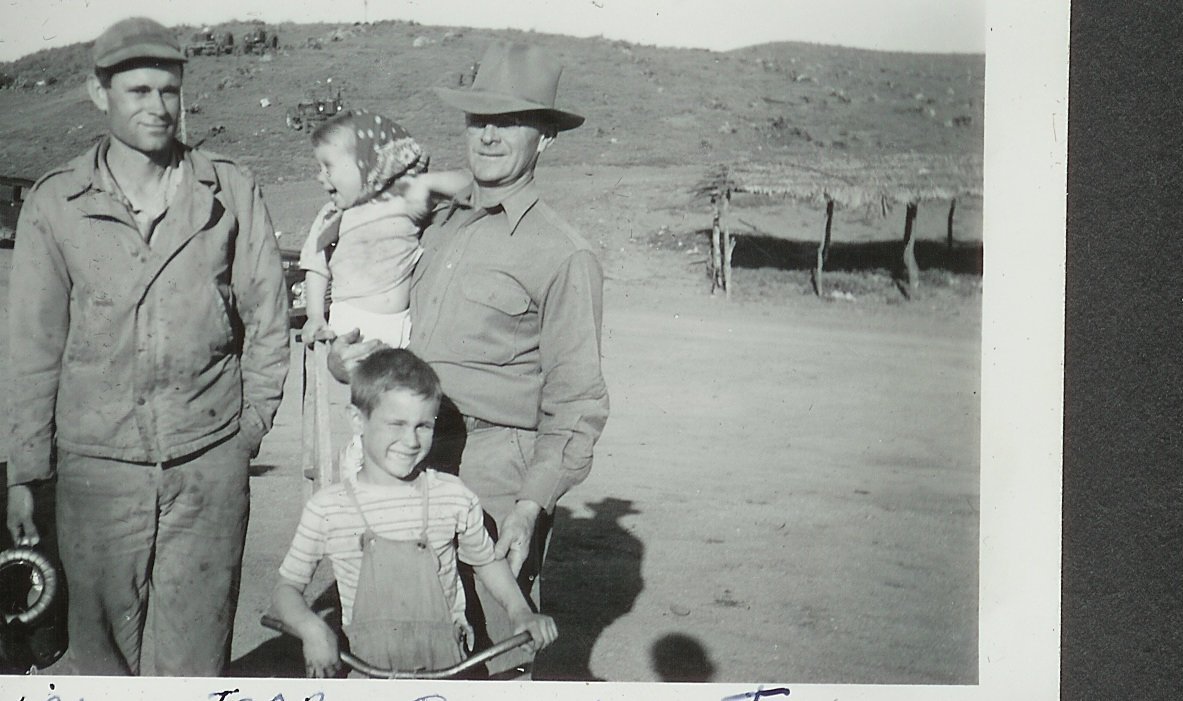
Leigh, Terry, Tom, Danny.
It looks like Iím getting ready to change the oil in one of the tractors.
That last paragraph needs a little explaining. One of those events that I canít put in exact sequence is that our partner, Santiago Campbell, became very impatient for the profits that he had imagined would flow immediately to him. Never having been involved in farming, he could not understand how much it cost to produce a crop. Tom decided that there was never going to be a reconciliation on this, so he agreed to simply abandon any right that we had to farm the Campbell property. We removed our pumps and engines, leaving him the land and pipelines. We lost the entire Santa Terresa valley, which was by far the most productive ground. By then of course, we had acquired the San Andres property, so we were not out of business. Part of the San Andres had not been purchased from Bernardo Castro. Andy Meling had filed on another parcel for Grampa, which also became ours. This parcel was where I had started to drill a well. Also, before the breakup, Tom had decided to become a Mexican citizen. This took some time and several trips to Mexico City. His citizenship allowed him to file on land in his own name. He had 100 hectarias (250 acres) surveyed, fenced, and cleared. This parcel lay to the east of the main San Andres, and to the south of the Meling parcel named above. This is where the second well was drilled. By this time we were starting to use sprinkler irrigation, so each of those wells was drilled in the center of their respective fields.
Within a short time after Stu got his operation started, he brought a friend down to see what he was doing. Bill Plourde, another engineer, had worked with Stu at Bell Aircraft. Both of them had worked on the design of the first jet airplane flown in the US. When Bill left Bell, he and his wife, Betty, had started a very successful childrenís clothing store in San Diego. He soon became excited about the prospect of farming; so much so that he purchased land and a well, with pump and engine, from us. We were left with 60 acres of good ground, plus all the ranch headquarters area, plus about 70 acres of good farm land on the "Meling" parcel.
Stu and Bill planned to grow chile peppers, and built a small dehydrator for drying the chile. I know that they grew at least one crop while I was still there, but I canít remember much about it.

David, Dan, and Terry.
It looks like winter, 1949
I do have vivid memories of several things relating to Stu. He brought down a 1936 Ford truck, with a two-compartment fuel tank, with transfer pump. He had bought it surplus from Ryan Aircraft, where he had worked. He intended to use it only for storage, not to haul fuel. I got thinking about that truck, and the fact that there were now several ranches close by using large amounts of diesel fuel to run their pumps. I thought that maybe I could make a little money on the side by hauling that fuel. I talked to all the parties involved; Stu, Bill, and Lasalle-Pedroarena, and all were agreeable to the idea. We had all had the problem in the past of having to go in person, or send word with someone, that we needed fuel, as there was no telephone communication to Ensenada. Having a truck based in the valley would be a great convenience. Did I mention earlier that we bought all our fuel and oil from Walter Hussongís Standard Oil bulk plant? They also delivered it to the ranch. I talked to Ricardo Hernandez, who managed Walterís businesses, about my idea. He said that he would sell the fuel at the plant for 2.8 cents per gallon cheaper than delivered to the ranch. The deal I made with Stu was to give him two 1000-gallon storage tanks in exchange for the truck. These I bought from Ricardo for $125 each. So, I was in business. Does anyone see the irony in me hauling fuel for Ed LaSalle, who owned thirty, or so, tankers of his own? The various ranches bought the fuel from Hussong, and I billed them for the haul. Sometimes I drove, usually leaving after lunch, filling with fuel, and returning after dark. The next day I would deliver the fuel to my customers. Other times I hired one of the men from the ranch to drive for me. Once I got so far behind that I hired a driver from Ensenada for a week. He made six trips in six days. I billed them about once a month. The engine in the truck was pretty tired, so when I got a little money ahead, I went to Sears in San Diego and bought a rebuilt short block for about $75. With gaskets, hoses, and belts, it was less than $100. I took it to the ranch and installed it in my truck. It ran like a CHAMPION! The truck did have one teensy little flaw. It had mechanical brakes, with a vacuum booster. To say that they were inadequate is being too kind! They were lousy! We had to adjust our driving accordingly; not too fast, use the engine for braking as much as possible, allow plenty of room for stopping. I did have one rather exciting experience in the truck. I was headed home one night with a full load, about 1750 gallons. Going down a gentle grade north of San Vicente, I spotted several cattle in the road ahead. I put on all the brakes I had, then, because of a curve in the road, I lost sight of the cows. I knew they were still there, and braced myself for plowing into them as I came out of the curve, but miraculously, they had moved of the road!

Dannyís hay wagon, with Terry and David on board
Partly because of that little incident, I started thinking of getting a better truck. By then I could see that I could make a few dollars with this business. I spotted a Ford truck on the used lot of the International Harvester dealer in San Diego, so I stopped to check it out. It was a 1947 F-6, with V-8 engine, larger tires than the old truck, two-speed rear axle, and best of all, vacuum assist hydraulic brakes. It had a flat cargo bed on it. I decided that it would be perfect for me. The only problem was that I didnít have the money to buy it. Why do those things happen so regularly? I did have the down payment, and they assured me that they would finance the balance, that is until I told them that I was taking the truck to Mexico. They were very apologetic, but said that it was against their policy to finance a vehicle in Mexico. We visited awhile, and when I told them I would be hauling for Ed Lasalle, among others, the policy quickly changed! I think the credit manager called Ed to confirm that he knew me, and that I was doing a little work for him. When I got my new truck to the ranch, I realized that I had not measured correctly, and the tank was too long for the frame and wheelbase of the truck. I had seen how some of my friends in Simi had taken trucks such as this, "fishplated" the frames, moved the rear axle back, put on heavier springs, and all sorts of things to create a truck capable of hauling much larger loads than the factory ever intended. What I was faced with was rather simple; cut the rivets holding the spring shackles to the frame, lay a piece of steel U-beam over the outside of the frame, bolt it in place, move the axle back 18 inches, drill holes in the extended frame, and bolt the spring shackles back in place. I had never done this, but how hard could it be? I did all of this at the ranch, using steel from a scrap yard in San Diego. The only thing I could not do was to extend the drive shaft. I took that to an automotive machine shop. They told me that they did not recommend a shaft that long. The proper way to do it was to make two shorter shafts, which meant installing another bearing to support them, and a cross member to support the bearing! I finally got them to make the long shaft, and to balance it well. In the time that I owned the truck, the shaft gave me no problems. My new truck was a delight to drive, compared to the old one.
Stu drove a large car, not very new. I think it was a Lincoln. I never made a long trip with him in the car, but he had a reputation for driving very fast. Later, when he bought a small airplane, a Taylorcraft, everyone kidded him because the plane would not fly as fast as the Lincoln would run on the highway. I think that it was slightly smaller than a Piper Cub at that time, with a 65 HP engine.
He kept the plane at our landing strip. It barely had room for two people, so he took all of us up, one at a time, for a short sightseeing flight. I made at least three other, longer, trips with him. The first was when I hurt my back, just leaning over. It got so bad that I could hardly move. It was no better the next day, so Stu offered to fly me to San Diego, and take me to a Chiropractor that he knew. I think they had to use a shoehorn to get me into the plane. We flew straight to San Diego Airport (Lindbergh Field). The approach was from the SE, and the Customs and Immigration Station were located at the extreme far end of the field. He explained to me that to avoid taxiing to the far end, we would fly most of the way, then land. He added that "everyone knows me here, because the first time I did this, I misjudged the distance, and overshot the runway, and had to go around for another attempt. So, now I am know as the one who overshot a 6,000-foot runway in a Piper Cub". (It was a T-Craft, not a Piper). From there we flew to another, smaller, field on the mesa east of Mission Bay, where he kept an old car for local transportation. I got to the Chiropractor, and we spent the night with his father. The next day I was feeling much better, so we took wing back to the ranch.
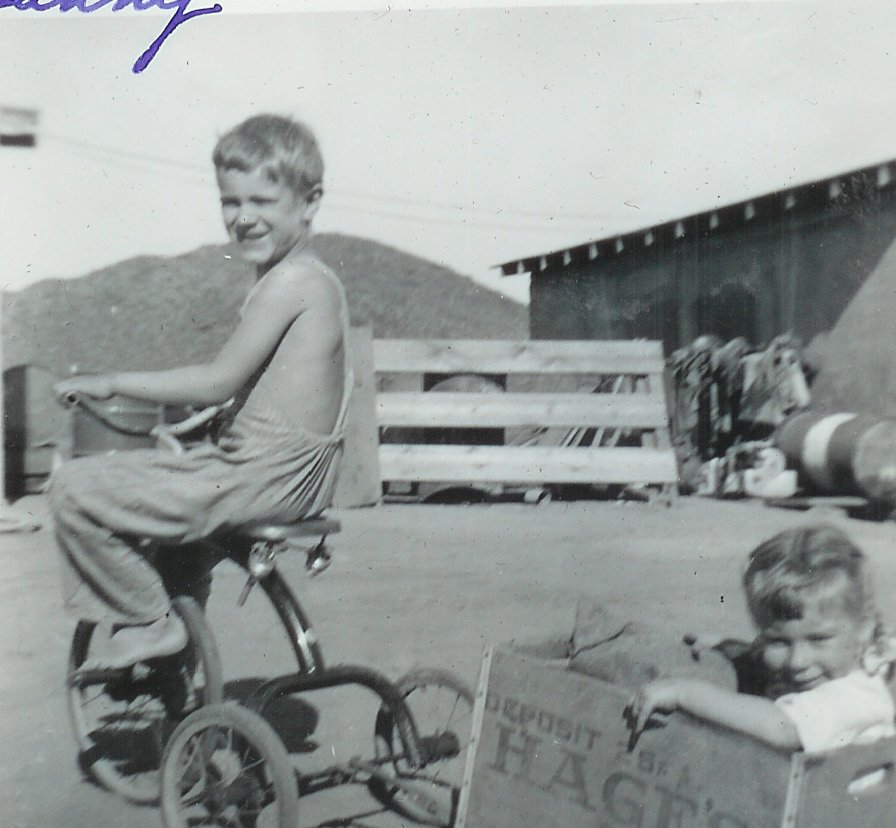
I put wheels and a hitch on the milk box.
Danny and Terry
Another time I needed a part from Wintroath Pump Co. in Alhambra,
near Los Angeles. Stu said that he wanted to see someone in LA, and suggested
that we fly up. This time we landed in Ensenada, for some reason. This turned
out to be a repeat of the approach to Simi Valley a few years earlier. We had
to fly up into cloud cover on a certain course, for a certain time, then drop
down out of the clouds over the ocean south of Ensenada. It worked as planned,
of course, or I would not be writing this now! Still, it struck me as not being
the wisest thing to do. As we got close to town, Stu told me that the rule of
thumb in Mexico was to look for the landing field next to the cemetery. That
worked too, as there was a small strip next to the old cemetery in town. From
there, we must have stopped at Lindbergh again to check in at Customs before
going on to a small airport near Alhambra. From there we flew across town to
Hawthorn Airport. Iím not sure, but I think that all Stu had to navigate by
was a street map. For sure, he was not familiar with flying conditions over
LA. The plan was to follow Wilshire Blvd, or one of the other main East-West
streets that we could identify, until we saw Hawthorn on our left. At that point
we would turn left to the airport. I asked about other traffic, and he told
me that East-West traffic flew between certain altitudes that were different
from the North-South traffic. Piece of cake, right? Once again, we were flying
underneath a cloud cover. Once again, the plan worked perfectly, almost. We
spotted our destination, and made our left turn, but that meant that we were
flying south at an altitude reserved for East-West. Besides that we were crossing
the final approach to LAX! Suddenly a commercial passenger plane dropped out
of the clouds and crossed no more than three or four hundred feet in front of
us, and maybe one hundred feet above us. It all happened in the blink of an
eye, too quick to even be scared. It did make me think that there was at least
one too many airplanes in the sky over Los Angeles on that particular day!
We spent the night with Stuís friend, a very nice man that was also in the process of starting a little ranch in the Las Chollas arroyo, a couple of miles east of our ranch. The trip home was uneventful, except that Stu let me "drive" most of the way between San Diego and Ensenada, with much coaching of course. I canít say that I was smitten with an overwhelming desire to learn to fly.
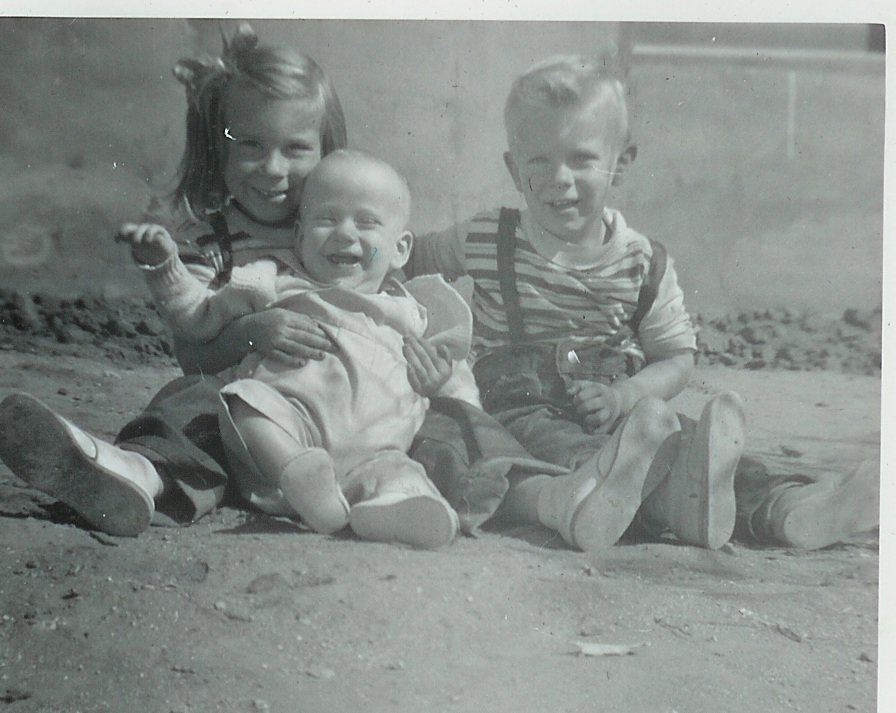
Terry, Glenn, David
The other trip was much shorter. One day Stu invited me to fly with him down to the Hamilton Ranch for lunch. He had been there a number of times, both by car and airplane. This was only about a 25-minute flight. They had a pretty long landing strip, but it was a bit tricky to land on. It lay east and west, sloping somewhat to the west, with the eastern end quite near the hills. The wind was always from the west, so you had the choice of landing downhill or downwind. The safest way was downhill, but that meant hugging the hills on the approach, then trying to get down in the updraft caused by those hills. I guess it would be easier in a heavier plane, but our little "feather in the wind" seemed to take forever to settle to the ground. I mentioned earlier that I had looked through a couple of guest registers from that ranch. There were many people flying in and out of the ranch during those years. At one extreme, there had been a Douglas DC-3 land there, which strikes me as a rather large craft for that field. Then there was the comment that they had to spread glue on the runway in order to make one of the lighter airplanes "stick" to the ground. We could have used a little glue!
I mentioned that we had started using sprinkler irrigation. I think we were sort of pioneers in this in Baja. When Stu started his ranch, he also bought a sprinkler system. He bought from a different source, and got a much better brand than we had. The pipe, of course, is all the same, but the couplers on the ends make the difference. Ours had steel couplers, with a self-locking device that worked well enough, but the self un-locking part gave us trouble. Stu got pipe with cast aluminum couplers that hooked together. He also made a deal with the distributor in Los Angeles to be a dealer for them in Mexico. He asked me to participate in this venture with him. All it cost us to get started was the cost of printing some business cards. Stu took the liberty of putting Ing. (Inginero) in front of my name, saying it would make a good impression! I got a Rainbird catalogue and manual containing all sorts of useful information on designing systems and calculating the horsepower needed to run them. I used this book during the time I worked at Maulhardt Equip. Co, and later, when I was farming. I may still have it in the shop. We sold two small systems, one to the Pedroarena ranch in Tecate, and one to an aqaintence of mine, Armando Fernandez. His ranch was in an area called La Calentura, east of the highway, about 30 miles north of us. I had been to that ranch in 1941, or 42, with Tom and Grampa Utt. We were on our way back from my first visit to the Meling Ranch.
Sadly, in the winter of 52-53, Stu was trapped in an avalanche while on a ski vacation in Sun Valley, Idaho. Barbara and I attended a memorial service for him, but he was not found until several months later.
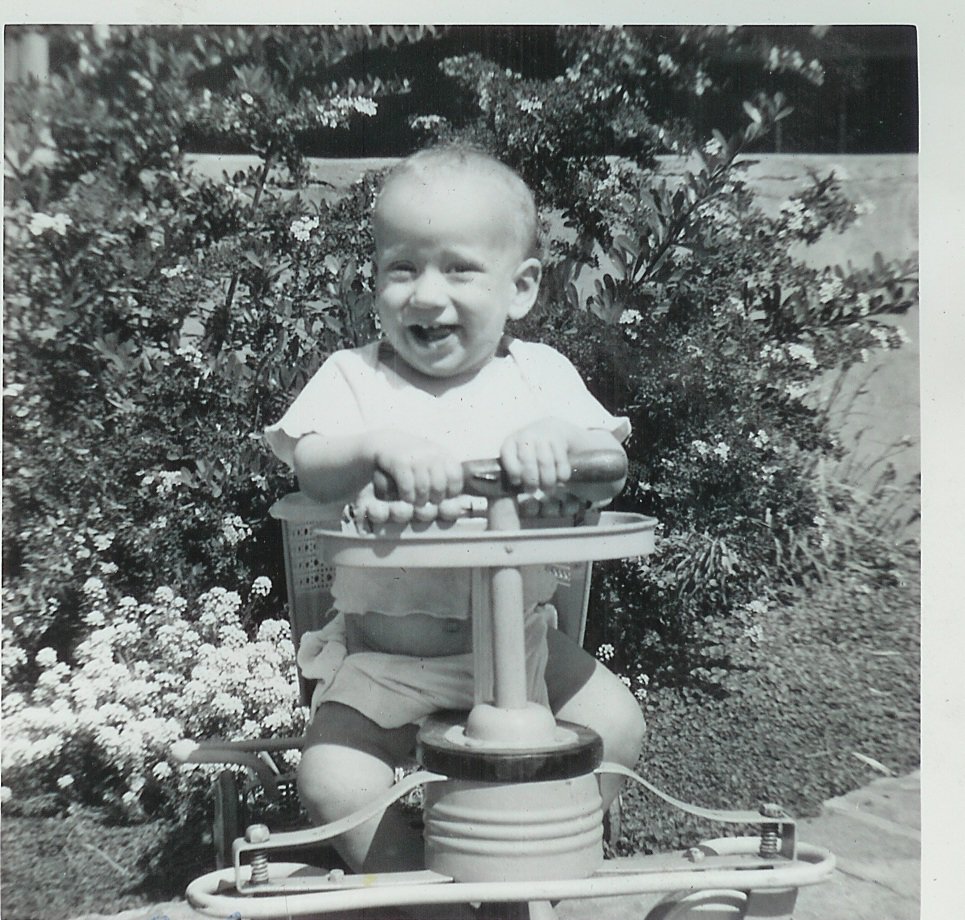
Glenn, in stroller
The most significant thing that happened in 1951 was that Barbara and I decided that we should move our family to CA. Danny was already of school age, and Terry would soon be. Barbaraís parents met us in Chula Vista to help us find a house. I canít tell you why, but I donít think we even considered renting. We were looking for a house we could buy. We finally settled on a nearly new two-story house that was two blocks from downtown Chula Vista, and about five blocks from St. Rose of Lima Catholic Church and School. Mom and Pop helped us with the down payment, and we felt we could handle it from there, even though we knew we would have to add on to it. When the deal was done, I made a rough drawing of what I wanted to do, then went up to Garden Grove to talk to an Army buddy, Carl Minor, (remember the tear gas!), who did carpentry and concrete work. He gave me lots of advice, and a Uniform Building Codebook, so that I could submit proper plans for my Building Permit. He also volunteered to help me pour the concrete, provided that we do it on a Saturday, since he worked during the week. As it happened, he was working on a job near San Diego at the time.
I had found out that I could get a permit myself, without being a licensed contractor, since I was the owner-builder. I got started right away, drawing up a very detailed set of plans to submit to the building dept. I was delighted at the fact that they found no flaws in my plans and specifications. However, there was a slight problem! The original house had been built three or four feet too close to the back property line. I donít know if the ordinance had changed, or if the inspectors just missed it. At any rate, the only way I was going to get a permit for what I wanted to do was to get a variance from the Planning Dept. So, off I went to see what the procedure was. I was told to get written permission from the lot owners on both sides, and the back, which I was able to do with a little perseverance and diplomacy. I submitted that, along with a written explanation of why it was necessary to build there, and told to appear at the next scheduled meeting of the Planning Board. Much to my relief, my request was granted, and a week or so later I had my permit. This did not all happen as quickly as it sounds. The family was still living at the ranch, and I was still spending most of my time there. I just came up for a day or two at a time. Once I was able to start the actual work, my time was more or less equally divided between the two places.
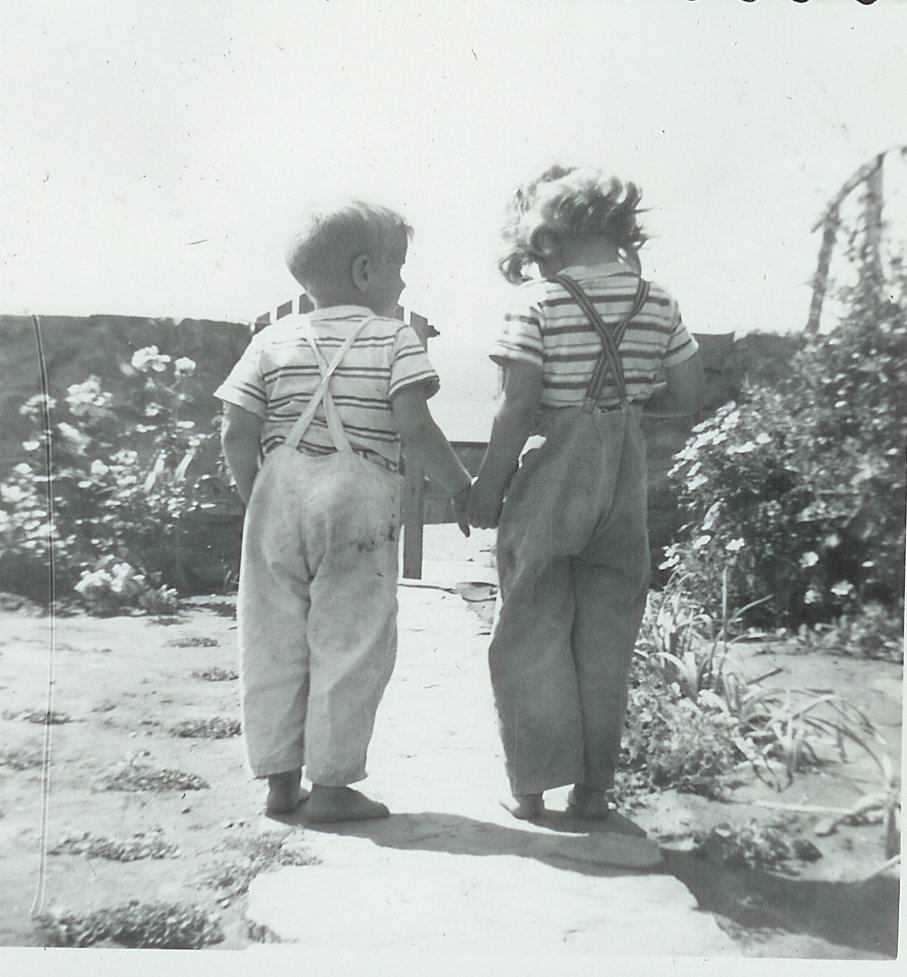
Terry and David
I LOVE this picture!
The original house was nearly square, with block walls on the lower level, frame with shake siding on the upper level, full-hipped roof, with asphalt shingles. The ground floor had a large front room and dining area, adequate kitchen and small laundry area. One large bedroom and the bathroom were on the second floor. My plan was to nearly double the size, adding a family room, small bedroom, and a bathroom with shower downstairs, and two large bedrooms upstairs. Iím guessing that the addition was about 20x20, or 800 sq. ft. total. Like most jobs, this one required that I start at the bottom, then work my way up. That meant digging footings for the concrete. Naturally, the logical time for this is in the heat of summer, right? The last six or eight inches of that trench were so hard that the pick barely made a dent in it. Swinging the pick in the hot sun was making me feel ill, the only time I have ever experienced that from being overheated. I went inside to rest and ponder the situation. Dare I put water in the ditch, hoping to soften the soil, knowing that it might not penetrate at all, and I would have a larger problem? "Desperate times call for desperate measures". I went out and ran about six inches of water in the trench, and rested until daylight the next morning. Wonder of wonders! The water had disappeared, and before the sun was high in the sky, I had spaded out my trench without further use of the pick! I think that Carl may have come over on a Saturday to help me set the forms. He told me that the type of soil on my lot had a great tendency to crack, and move. He suggested putting a layer of sand on the bottom of the trench, and under the slab, so that the soil could move without cracking the concrete. On Monday I went to a concrete plant nearby to order a load of sand delivered, and order the concrete. I found out that they did not deliver on Saturday. They only knew of one company that did, and that was way out in El Cajon. I called them, and yes, they would deliver on Saturday. They grumbled a bit about the distance from their plant, but we managed to overcome that problem.
Meanwhile, I had a plumber come out to put in the drainpipe for the new bathroom. I vaguely remember some complications in finding, and tying into the existing drain, but it got done. I spread sand under the footings and slab, being certain to maintain all the proper depths for the inspector. After he left, I shoveled in a little more sand, to be certain that we did not run short of concrete. Carl came on a Saturday to do the pour, and when it was done there was not one tablespoon of concrete left over!
Carl had a radial arm saw that he loaned me for the entire time I worked on the house. I think he worked with me long enough to start the framing of the bottom floor. From then on I worked alone, although I called on him for advice on occasion. When the lower walls were up, I put the second-floor joists in place, and laid a sub-floor on them. After that I started over, nailing the walls together on the top floor, then standing them up. This turned out to be a little exciting by myself, on the second floor. One long wall almost got away from me, but I managed to save it. Next came more ceiling joists, then the really exciting part, tying the new roof into the old one. To do this, I had to remove about a quarter of the old roofing. This I did, then framed the new roof, with hip rafters at the corners, to mach the rest of the roof. What I had learned about using a framing square came in handy for this whole project.
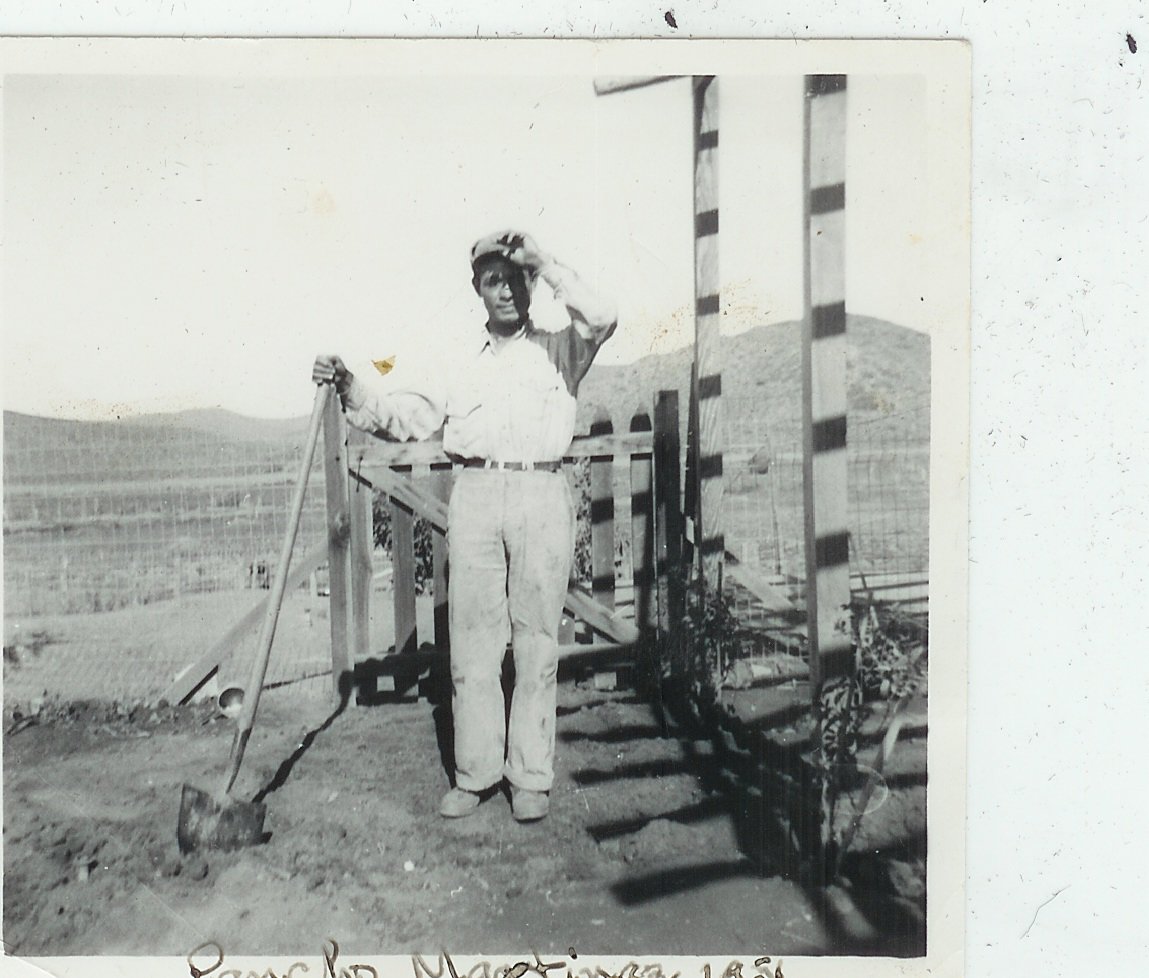
Dannyís special
buddy, Pancho Martinez
At this point I needed to be at the ranch for a while. It was July, so surely I didnít need to worry about rain while I was away. Wrong! We were listening to the radio one evening, when we heard that it was raining in San Diego. Early the next morning Barbara and I took off for Chula Vista, with one of the large canvasses that we used for drying flowers. We also took all the towels and rags that we could find, anything to help us clean up. We must have left the kids with Dorothy. We spent all day mopping and sopping up the water in the bedroom upstairs and the front room downstairs. I canít seem to remember whether or not there was carpet in either of these rooms. It was bright and sunny all day long, so I didnít bother to cover the roof. The stars were out when we went to bed. Sometime in the night, we were wakened by rain on the roof! By the time I got the canvass in place on the roof, I was so frustrated and angry that I knew I would not be able to sleep. I got out saw, hammer, and nails, and started putting sheathing on the roof. The neighbors must have known for sure that a madman had moved in next door!
Luckily, there was no permanent damage done by the rain. On my next time up I finished the roof, and by the first of September I had completely closed in the house, including the drywall on the inside. This meant that we could move in, and get Danny enrolled in school. I think that I had his bedroom downstairs completely done. We juggled the other kids around from room to room, so that I could finish up one room at a time. Carl gave me some pointers on building cabinets. I made built-ins on the west walls of both upstairs bedrooms. The family room had knotty pine up four feet all the way around, then drywall from there up. I put asphalt tile on the concrete floor, and a very cheap carpet sort of thing upstairs. We figured it would do till we could afford something better, and then it would serve as carpet pad. Barbara helped do the painting, after she and the kids moved in. All in all, the project turned out rather nicely, I thought. Other than the plumber, electrician, and a few days of Carlís time, I did it all myself, from permit to paint, from footings to roof. I guess I just wasnít smart enough to know any better!
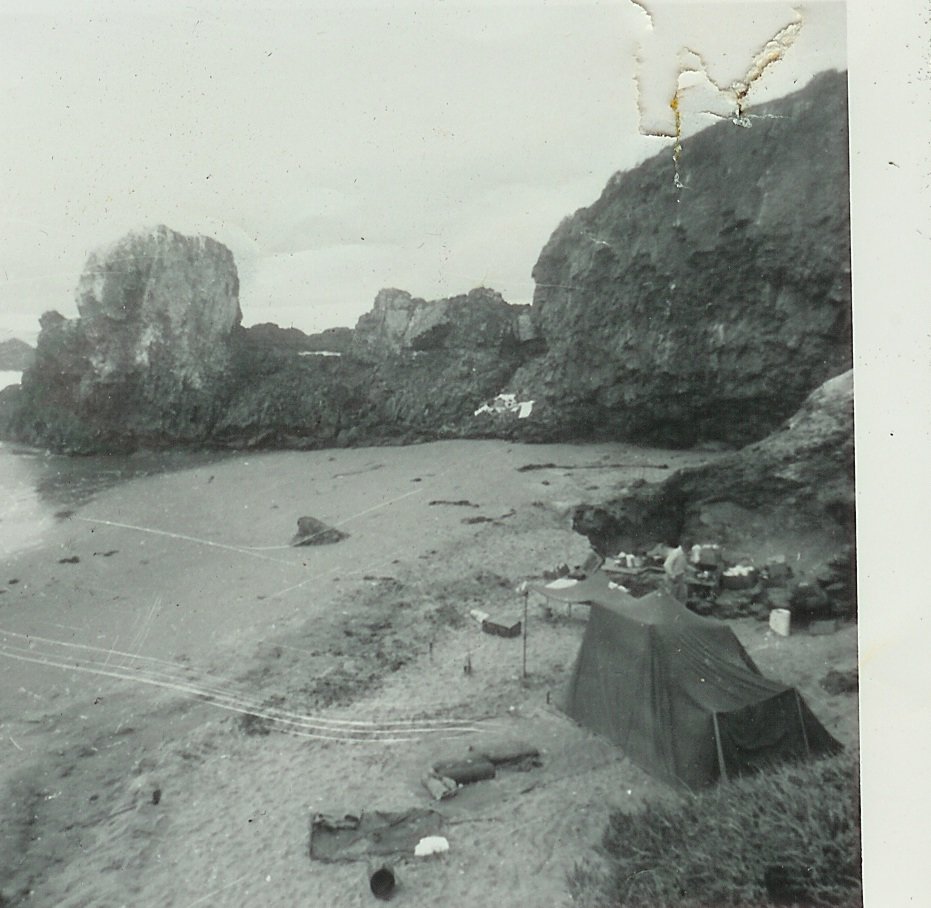
Camping at Punta Cabra
In the beginning, I went as far as I could on our own money, feeling certain that I could borrow enough to complete the job. When I went to the Savings and Loan that carried the original loan, the loan officer told that they did not want to loan money on a project that they had not approved of ahead of time. I showed him my plans, and talked him into coming to see just how much I had done, and how much value was being added. I guess he was impressed, because I got the money I needed to finish the job.
A few details I remember are hard to even imagine today. I bought two 100-pound kegs of nails for $8 each. Lumber was about $20 per 1000 board feet. When I went to the electric shop for an electrician, I was told that they would charge time and materiel, and to figure about four dollars per outlet box for everything. I think that the entire job was a little over $100. The plumber that worked for me was fast, and he never had to go back to the shop for tools! He even took time to teach me a few things. As a matter of fact this project was a great learning experience for me.
When Barbara and the children first moved into the house, we were still without a car, so she had to walk wherever she needed to go. By the time we left Chula Vista we had acquired Dorothyís 1946 Ford sedan, when she got a new car.
After the house was finished, Dorothy gave me money to buy lumber for a fence across the front. We planted a lawn in the yard. Did I mention that we had a very large avocado tree in our front yard? The kids would fill their little wagon with avocados to sell to the neighbors.
When we bought the house it had a telephone in it, which was a welcome change for us. One of the first things I did when I started work on the house was to get a newspaper, so I could look at the classified ads. The only appliance that came with the house was the range. I badly needed a refrigerator. I located one in Pacific Beach for $50. For some reason, Stu happened to be around when I brought it home. Since the family was not with me, I think that he stayed at our house occasionally on his trips to San Diego. Anyway, he helped me get the refrigerator into the house and put in place in the Kitchen. I vaguely remember putting ice cubes under the four corners, to facilitate sliding it into place. Later on we found a dining room table and chairs in the ads. Barbara sold our savings bonds to buy a used washer and dryer. Later she bought a used television set. This was quite a novelty for us! I have no idea of where we got beds and front room furniture. I know that we did not strip the house in San Telmo, because we planned to spend summers and vacations there.
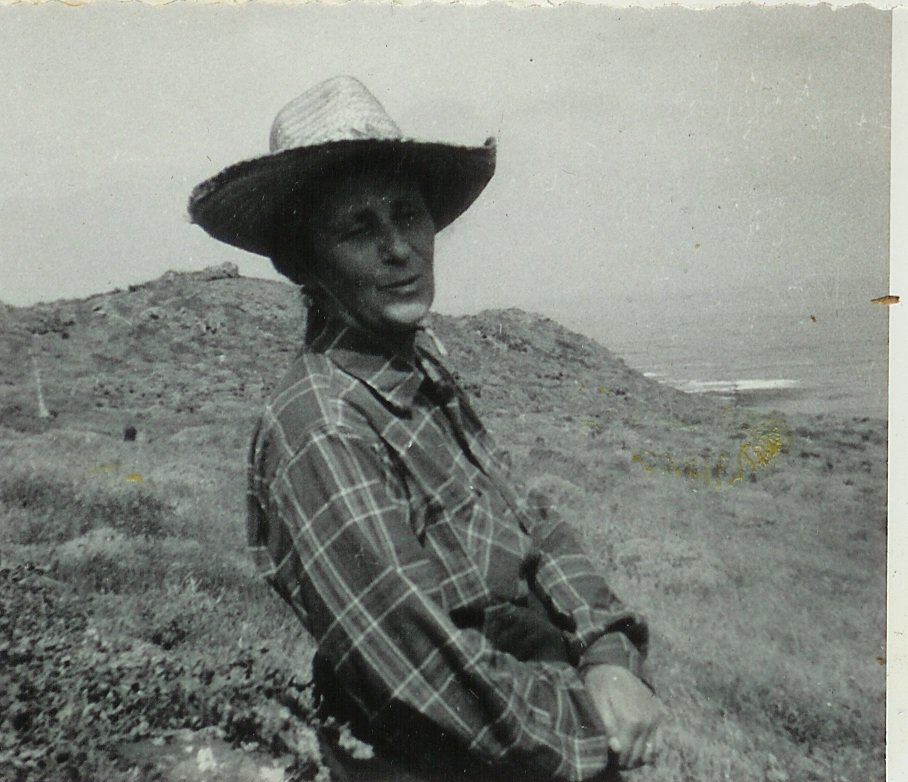
Granny, Punta Cabra
Meanwhile, back at the ranch. After the "Great Zinnia Disaster" the seed business slowed down. Haven Seed co. ceased operations entirely, and Burpee cut back on our acreage. These things sort of coincided with the loss of the Santa Terresa land. That meant that our operation was somewhat reduced in size and scope. I did learn something significant from Al Condit during those later years. He told me that some of the growers in Ventura Co. were planting certain seeds into moist ground, then allowing them to sprout without more irrigation. I learned to do this with both zinnias and tomatoes, and that method of planting served me well in later years. I believe that 1952 was the last year Burpee contracted with us. They left the little house trailer, giving it to me. I later took it to Simi, fixed it up, and our family used it once or twice. Later, I sold it to my brother Tom, to live in while working on a job in Lone Pine.
During the time that the family was in Chula Vista, I "commuted", spending a few days, or a week, with them, then back to the ranch, as needed. For a while I worked on remodeling a small apartment for a man that I had met at the local lumber yard. He was in no great hurry to have it finished, so that gave me a little income when I was with the family. Dividing my time this way was not a good arrangement! I know that I was not doing justice to my obligations at home or at work. This was certainly one of the factors in our decision to leave SanTelmo entirely in 1953. The most notable event of 1952 was the birth of our son, Gerald John. He had a difficult time making his arrival. Barbara spent a day or two in the hospital, with the baby seemingly on itís way, only to be sent home to wait a little longer. About a week later he was born, weighing only five pounds. We had decided on a boyís name, but when he arrived, I told Barb that it didnít seem right. Then, of course, I took off for Mexico, leaving her to pick a name! For a more vivid, more animated account of this episode, talk to Barbara about it. I marvel that she stayed with me!
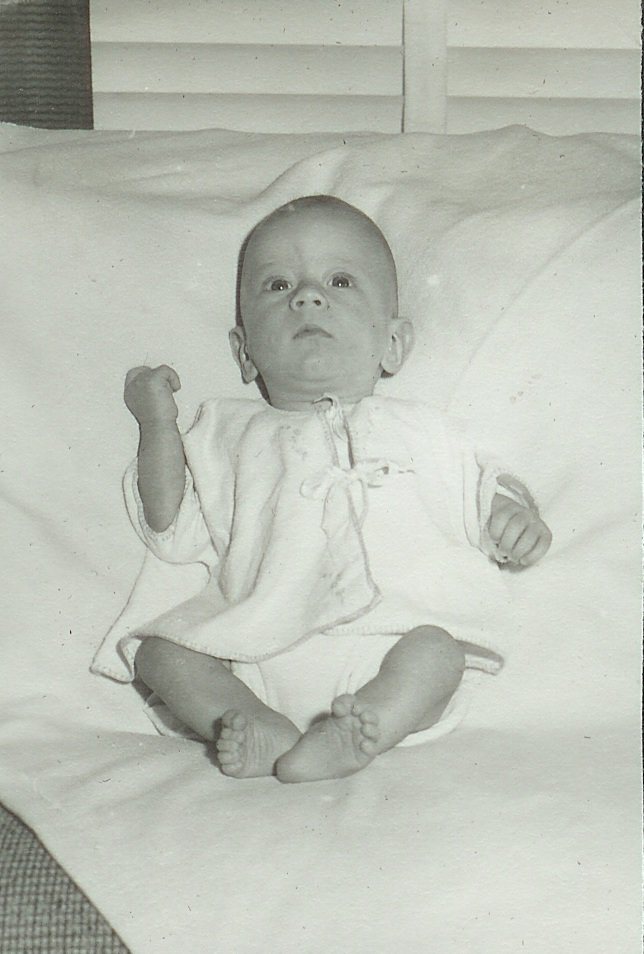
Gerald John Robertson
While I was alone at the ranch, I got rather well acquainted with Pedro Pedroarena, his new bride, Juanita, and also with Ed Lasalle. I was invited to dinner at their place quite often, and Pedro and I shared the road project, as well as a little hunting excursion that I will describe later.
As this story nears itís end, I want to go back and "speak of many things", of people, events, excursions and diversions.
We badly underestimated the difficulties we faced being so far away from services of any kind. I hate to even think about how many times I drove that road to Ensenada, 100 miles, three hours each way. Then, many times, another 80 miles to San Diego. The last 15 miles of "highway" before turning onto the road to the ranch was unpaved, the surface being mostly small rock. The rocks were terribly hard on tires. Buying and repairing tires was an ongoing project. I made a deal with one of the tire shops in San Diego to save all of the so-called "blems", tires that came from the factory with minor defects, for our pickups. We almost never wore out a tire; they just failed from so many breaks in the casing. We referred to this X shaped break as a "Viva Mexico".
Auto parts, lumber, cement and food staples were readily available in Ensenada. For tractor and diesel engine parts we had to go to San Diego. Tom established wholesale accounts for the Tienda Santa Terresa at Western Metal Supply, Smart and Final Wholesale Groceries, Haageís Dairy, and Bridgeford Ham and Bacon. Almost every trip to San Diego included a visit to one or more of these places. At the dairy we got, at minimum, a case of milk and a 2 Ĺ- gallon carton of ice cream. They packed the ice cream in dry ice, so that it would stay frozen. (Once Tom used this method to take ice cream with him on a trip to a remote ranch south of El Rosario. The people there had never seen ice cream, and didnít know what it was!) We preserved the fresh milk by pouring it into ice cube trays for freezing, in our refrigerator or Dorothyís.
Iím sure that anyone who has traveled the road from Ensenada to the ranch with me has already been bored by my recounting of the many mishaps that I experienced during those years. It seems as though every mile or two brings back a memory. Not to worry! I will only tell of a few of the more memorable episodes. Two of these involved Barbara and at least some of the kids. When we first moved to the ranch, our only transportation was the pickup. Donít ask how we all squeezed into it, but somehow we did, when necessary. When the folks moved into the other half of the house we were able to use Dorothyís 1946 Ford sedan for family trips.
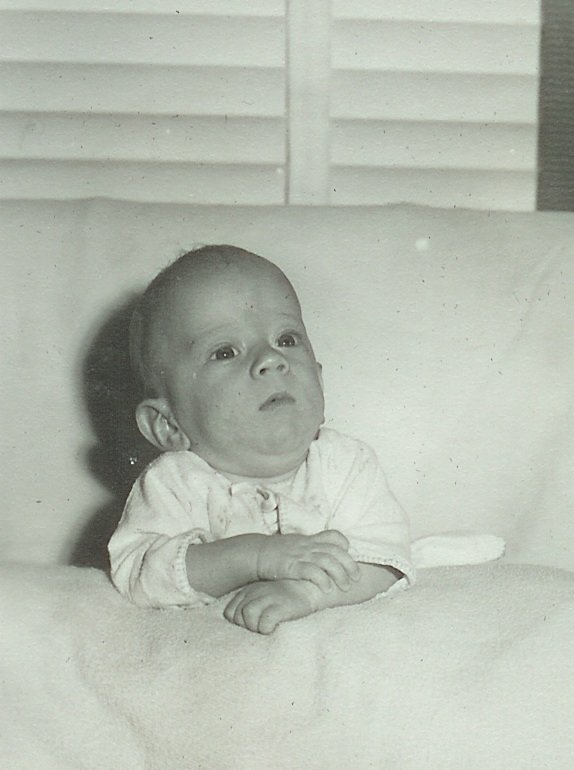
Gerry
Once, we all piled into Dorothyís sedan to go to Ensenada, for what I donít remember. I think we started after lunch, took care of our business, then decided to have dinner at the El Rey Sol. It was dark when we headed back to the ranch. Barbara offered to drive, so that I could get some rest. As we were starting down the grade to Santo Tomas, I glanced at the fuel gauge, and realized that I had forgotten to fill the tank in Ensenada! I took over the driving, and turned back toward town, but only got about a half mile before the engine started to sputter. I turned around again and found a wide parking space about halfway down the grade. I knew that the service station in Santo Tomas would not be open, so the only thing to do was settle in for the night. David was still on the bottle, and we had only about a half bottle left for him by this time. I think it rained most of the night. None of the children made any fuss during the night. They were, and are, real troopers! In the morning, as I was getting ready to walk into Santo Tomas, a pump installation truck stopped to see if we needed help. They towed us to the service station, and we had only a short wait for them to open.
Another time we were headed south from Ensenada after dark. Rounding a curve, I saw cattle in the road ahead. I braked almost to a stop, then the cattle moved off the road, and I started to accelerate. Suddenly another cow came out of the brush, and the car slammed into her. I could see her feet in the air, and thought that she was going to fall on the hood of the car. Fortunately, she rolled back the other way, then trotted off to join the herd. The car had a broken headlight and a bent grill. It could have been much worse!
When Terry was probably not yet two years old, she developed a fever that lasted for two or three days. Finally, Barbara and I decided that if she still had the fever the next morning, I would take her to Dr. Knott, in San Diego. When we checked her early the next morning, the fever was still with her. So, I bundled her up and got her settled on the seat of the PU, and off we went. When we stopped at the Rey Sol for breakfast, Dona Cucca held her for awhile, then said to me, "she is not sick, she just wanted to go for a ride." I drove on up to the Doctor, and after checking her out, he told me that she seemed fine; no fever or other symptoms. After doing errands in San Diego and Ensenada, we started out on the long road home. We had a flat tire along the way. It was dark long before we got home. Needless to say, Barbara was very relieved when I got home with a healthy little girl!
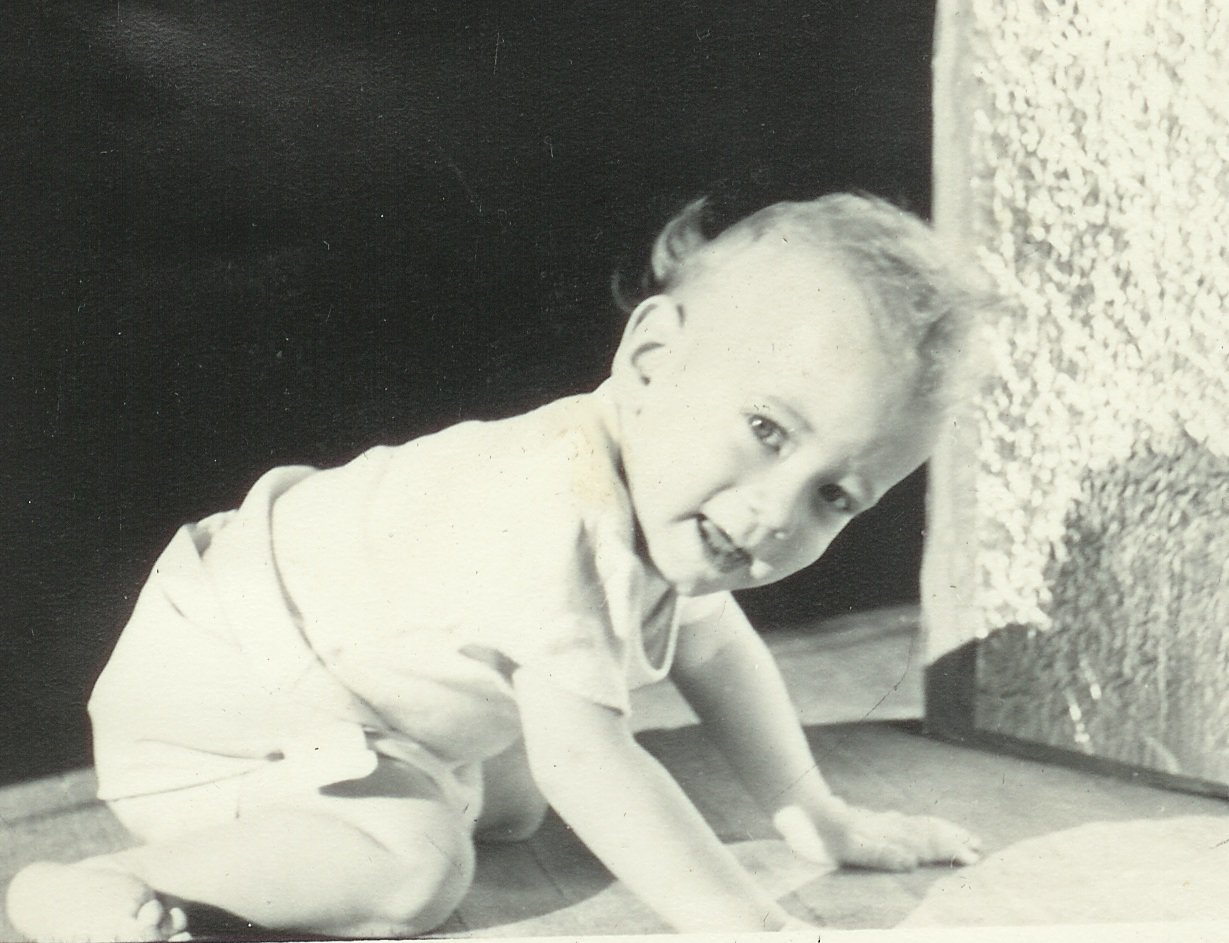
Gerry, about 12
months
The two ranches, San Andres and Santa Terresa, were sort of like people magnets. There was not much else happening in that part of the country, and those that made their living from cattle were suffering from drought years. Because of the hard times, people came from near and far to find work. I know of several that walked at least the last 15 miles from the main road, hoping to be hired. I think that Ana Mariaís father, Samuel Tovar, was one of those. There were also a number of men from the little village of San Telmo. Among others, Victor Ormart, Bernardino Macleer, Francisco Mayoral, Petin Thing, Hector Arce, and another Arce, whose name I canít remember. From Arroyo Seco and San Vicente came four Rendon brothers. The last to arrive, and the oldest, was Epifanio. He soon became my right hand man. Tom bought a new half-ton pickup, and we turned the older PU over to Epifanio. He took the men to and from the various jobs, and kept a time book for me. Over time we gave him more responsibility, and he was a great help to me. We gave him and his wife, Emilia, the old kithcen-mess hall to live in. Braulio R. became our first tractor driver, and was quite good with the bulldozer. When we started operating the tomato seed plant, I put Claudio R. in charge of that operation. He also worked with me when I started drilling a well with our rig. Pancho, Pablo, and Pierin Martinez worked for us for several years. Pancho and Bernardino were Dannyís special buddies. Other names that come to mind; Nacho Ruiz, Felipe Cortez, Rosendo Romero.
About three miles west of our place the Pompa family had a ranch. There were three brothers, I believe; Eulogio, Gregorio, and Guillermo. We hired one or more of them from time to time, to make and lay adobe bricks, and to do stone work, including a nice wall enclosing the area between the two wings of our house.
The second year, after clearing all the mescal and other brush from the Santa Terresa, we disced, plowed, and disced again, then made furrows for the pre-irrigation. Once we started the pumps they ran 24 hours a day. The irrigators worked twelve-hour shifts, using kerosene lanterns at night, mainly to keep an eye on the main ditch and siphons. They started reporting finding many rattlesnakes where the water was running. I guess that since we had disturbed the natural habitat of small rodents, and the snakes that fed on them, this was not too surprising. One morning when I took the day shift out to the field, one of the night crew was standing with his arms extended straight out, with a dead rattlesnake in each hand, their heads dragging on the ground! Snakes were not a major problem in the following years
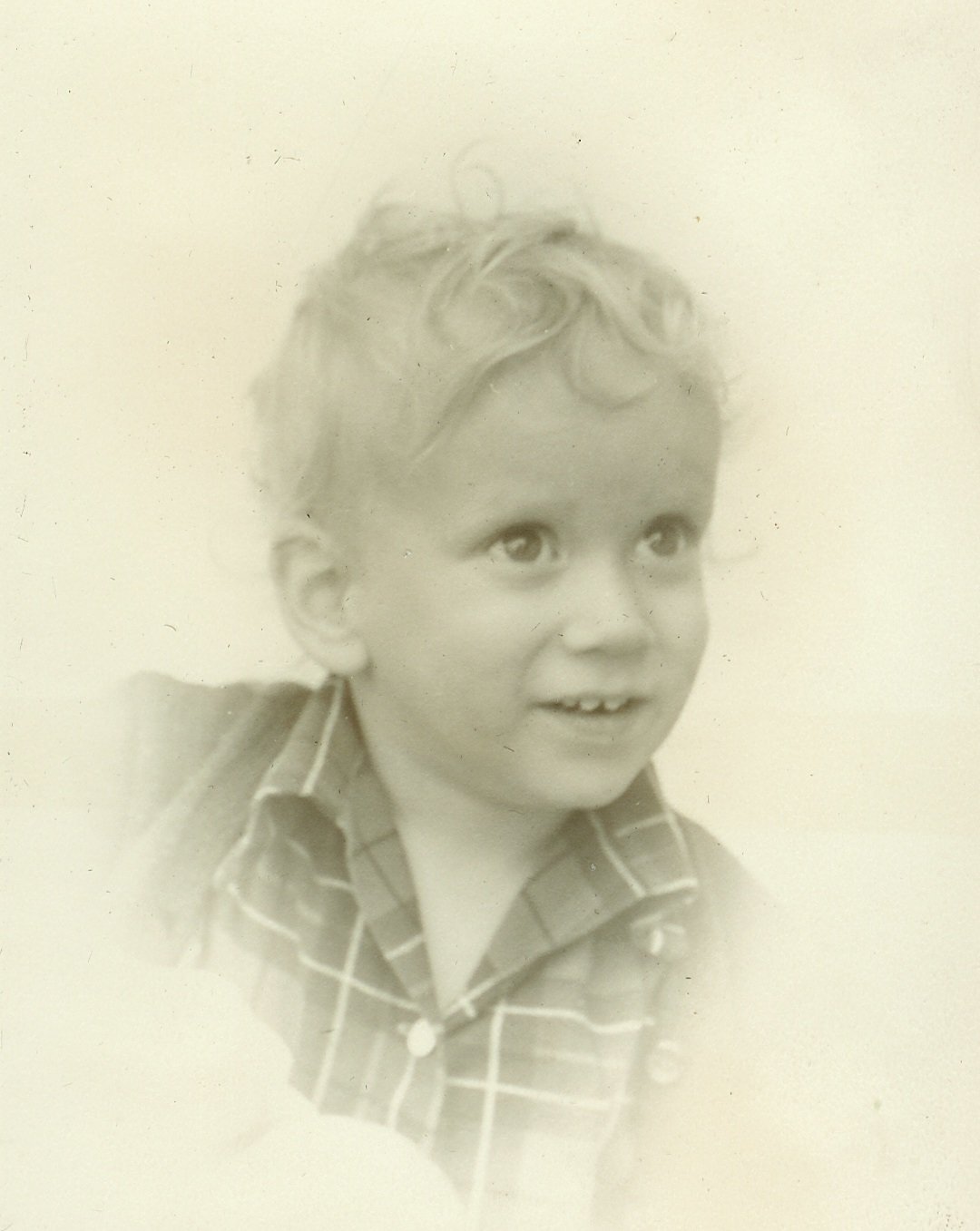
Glenn, about three years old.
All the engines had to be shut down once a week for changing oil and filters. Epifanio and I did this on Sunday morning, shutting down the upper booster, then the lower one, and finally the main pump. We got so that we could do this whole routine, and have the water running again in two hours. Stopping and starting the lower booster, in particular, was a very delicate operation. This was due to a phenomenon known as "water hammer", which I will not attempt to explain on these pages. Suffice it to say, unless we used great caution, we could, and did, break the concrete pipeline near the booster. And sometimes it broke for no apparent reason. One of those breaks was particularly bad, splitting eight or ten joints wide open. I didnít have enough spare pipe to do the repairs, So, while the crew dug out and removed the old pipe, I made a mad dash to Ensenada for as many joints as I could get in the PU. Nacho was the designated pipeline repairman, having had a little experience with concrete. He and the others worked diligently to make the repairs. Then, after waiting three days for the concrete to cure, I eased the water back into the line. After a few minutes, the line broke again. Nacho was terribly despondent at this turn of events. He turned to me and said "patron, if I had a pistol, I would shoot myself!" Imagine the look on his face when I opened the glove compartment of my PU and offered him my pistol!
In the quiet of night, I could hear three, four, or even five pump engines running. At first they kept me awake. With the changes of wind drift, first one, then another would be the loudest. I learned to identify each one by itís own particular sound. Soon, I became accustomed to the noise, and slept soundly. One night I awoke suddenly, and soon realized that one of the engines was not running. (It had run out of fuel) I had become so accustomed to the sound that when it changed I woke up.
We got acquainted with many of the "neighbors". Some of them lived thirty miles away, to the east, in the foothills of the San Pedro Martir. Any accounting of the denizens of that area, at that time, would have to begin with Tom Farlow. He was a wonderfully colorful character. He had left Texas as a young man, for reasons that can only be speculated upon. He settled in the area at the base of the northern end of the San Pedro Martir range. His home ranch was La Conception. I had been there with Grampa, in 1939, but Tom was away at the time. He had two wives over the years, both of them from the Kiliwa Indian village in Arroyo Leon. His second wife, Chepa was a legend in her own right. Tom spoke a delightful mixture of Texan, Spanish and Kiliwa. We never passed up a chance to visit with him.
Our closest neighbor to the east was Gabriel Espinoza. His ranch, Las Cabras, was in the San Telmo valley, about ten miles upstream from us, where the valley becomes a narrow canyon. The Espinozas are a very old family in Baja, as are the Martorels, and Arces, dating back to the days of the missionaries. Tom and Gabriel became very good friends over the years. Gabriel served as packer and guide on some of the trips we made into the mountains during those years.
A road turning off to the right about three miles east of us took us about thirty miles to Rancho Santa Cruz, at the very base of the big mountain. Tom and I, separately, had both been to that ranch earlier, but on horseback. The owner was Esteban Martorel. His brother, Raimundo, had a ranch nearby, El Potrero. Both of them stopped by our ranch occasionally, on their way to or from. Santa Cruz was our jumping off place for pack trips to the mountain. We would send the horses and mules up a day ahead of time, then drive up, camp overnight, and mount up early in the morning.
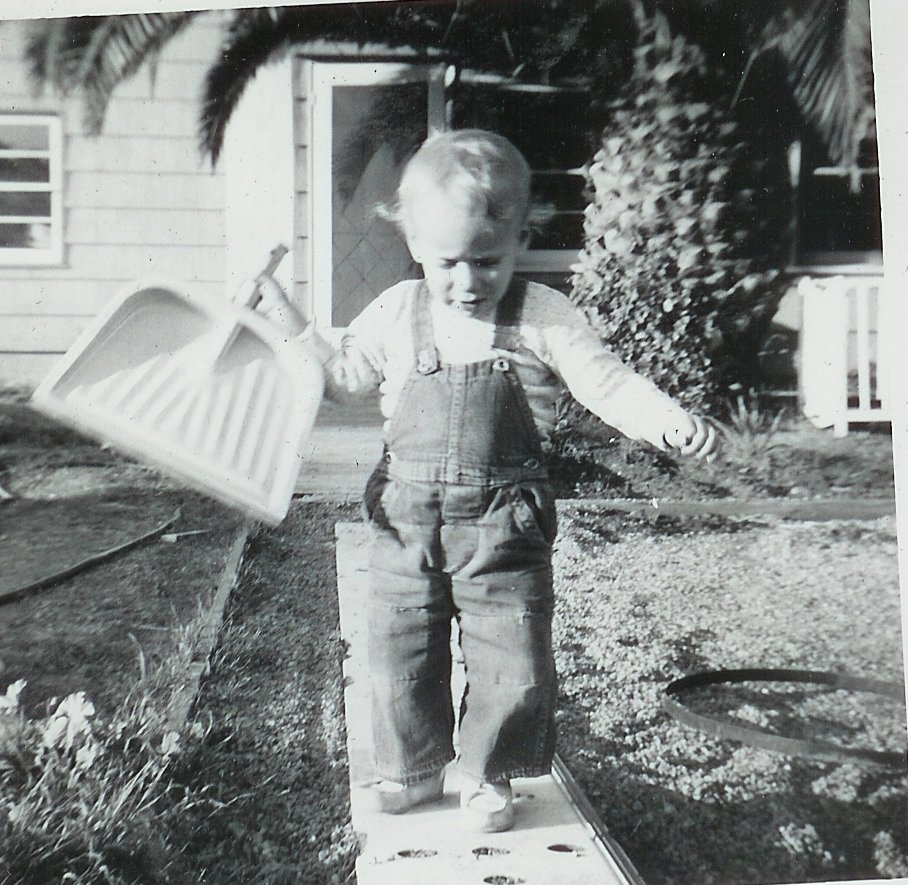
Glennís first steps,
Chula Vista
Surely the best known of our neighbors, at least to Americans, was the Meling family, at Rancho San Jose, eighteen miles east of us. Alberta, "Bertie" Meling was the daughter of Harry & Ella Johnson, who had settled originally near the coast, north of Cape Colnet. On the older maps it was called San Antonio del Mar, or Johnson Ranch. They had come from Texas during the time that an American company had a concession to develop the northern part of Baja, probably 1888. Mr. Johnson had come ahead, to secure a place for the family, and his wife came on her own, with the children, her dairy herd, cheese making equipment, and household belongings, by train to San Diego. That sort of strength and determination was certainly passed on to her daughter, Bertie. Salve Meling was the son of Norwegian immigrants who had arrived in Baja about the same time as the Johnsonís. Dry years forced Mr. Johnson to look farther and farther inland for feed for the cattle. This search carried him to the western slopes of the San Pedro Martir mountains. There he found a deposit of placer gold. This deposit had been known and worked for many years on a very small scale, due to the fact that there was no water available for washing the gold out of the sand. Johnson filed a claim on a large area that had not yet been worked. After making some tests, he determined to mine gold on a larger scale. He set about surveying, and constructing a ditch that ultimately reached 18 miles in length to bring water from the Arroyo San Rafael for the mining process. The remains of that ditch are still visible today, but only us old timers know where to look!
In time, the mine became the central focus of Johnsonís business activity, so the dairy and cattle business was moved to a ranch in the foothills, some ten miles west of the Socorro Mine. This ranch was known as Rancho San Jose, but today it is better known as the Meling Ranch. We had known some of the Melings for a number of years. I went there on a trip with Tom and Grampa Utt in 1941 or 42. Grampa had been there many times before that. The two boys, Andy and Philip, had both spent some time with us in Simi, Andy to go to high school, and Philip to work. Salve reminded me a little of my Danish grandfather. He was small in stature, with blue eyes, and obviously capable of doing anything and everything that needed to be done to survive on the frontier. He seemed to sort of stay in the background, and let Bertie manage things, and manage she did! The twinkle in Salveís eyes sort of indicated that he was fine with this arrangement!
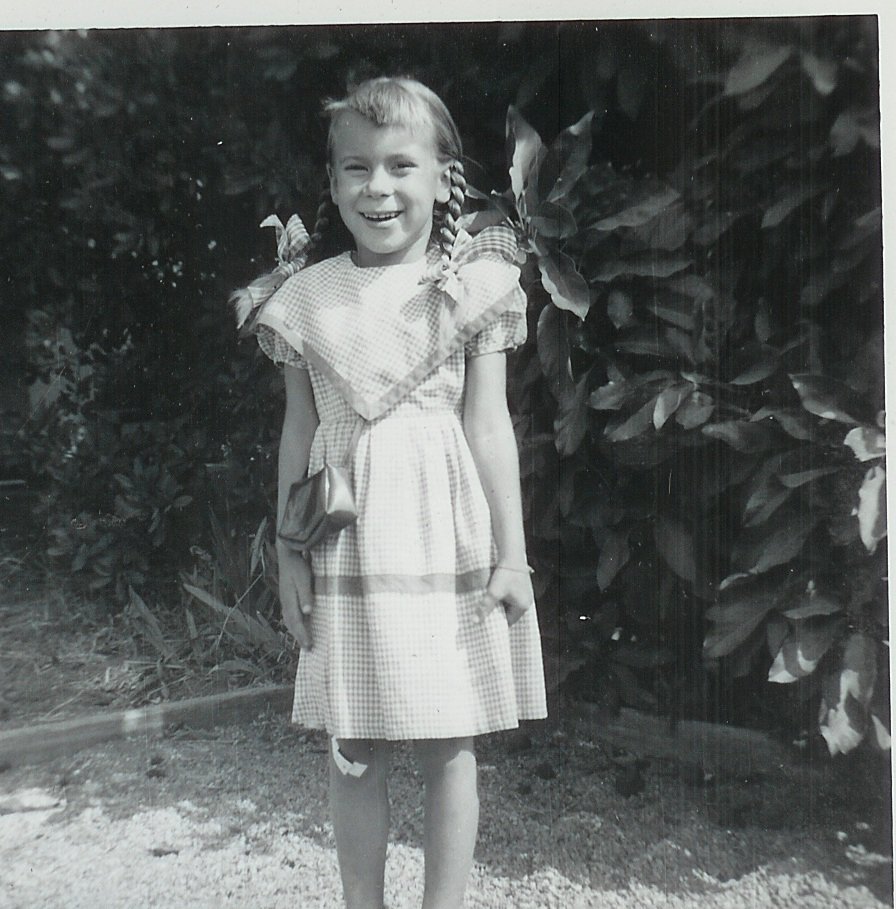
Terry, off to Kindergarten, Chula Vista
The Meling ranch never stopped being a working cattle ranch, but it also evolved into a guest ranch. As a few adventurous Americans started exploring the more remote areas of Baja, some of them found there way to the Meling ranch. Bertie started putting people up in any unused rooms that she had, and feeding them delicious meals. Her warm hospitality, and the good quail hunting in the San Jose valley, kept them coming back. More rooms were added over time, and a large kitchen and dining room. During the time that we were in San Telmo, her daughter Aida, and husband Billy Barre, came back to the ranch, and eventually took over the guest business. We drove up there to visit a few times, and Bertie also stopped at our place on her infrequent trips to Ensenada. To my knowledge, the Melings never owned an automobile, or pickup. Bertie could always catch a ride with one of her guests or friends going north, then, when she had finished her business in Ensenada, she would leave word at Hussongís Service Station that she needed a ride south. In those days there was an old hotel, named La Virginia, I think, that the people from the remote ranches used when they were in town. When I made the trip with Tom and Grampa to the Meling ranch earlier, we got such a message, and picked up Mrs. Meling at the Virginia, and took her to the ranch. We stayed in some empty bedrooms in the main house.
One day a very old, beat up truck pulled into the yard. It was piled high with used lumber, old corrugated roofing, and a few household things. An elderly couple got out, and all of us went out to visit. The man was Mexican, and I believe that his wife was American. We were told that they planned to build a small house on up the valley. Dorothy invited them into her house, and fed them lunch. This pattern repeated itself many times. They would stop on their way in and on their way out, always at mealtime! And always hungry! Each trip saw another truckload of junk for their house. Dorothy always seemed to have some extra canned goods in her cupboards to send with them. And they were most gracious in accepting them. After a time, she started driving up to visit with them, and I went with her now and then. They had built a small, crude house in the mouth of a small canyon that emptied into the San Telmo valley, only a couple of miles east of us. There was a small spring in the canyon that provided water enough for them, and a small garden. I think that they had been there for at least two years, when Dorothy remarked to me that she had not seen them for some time. She wanted to check on them to see if they were OK. She filled a small box of food for them, and I drove her to their house. The truck was gone, and the house was empty. We walked up the canyon fifty yards or so, calling out, but no one answered. Back at the house we took a closer look around. It was as if they had just vanished into thin air! Dirty dishes were left on the table, and, as far as we could tell, nothing in the house had been touched. We never saw or heard from them again! The whole thing was, and remains a mystery. When they first arrived, they seemed to know exactly where they were going, but we had driven past that little canyon dozens of times without knowing there was a spring there. How did this couple know about it? They apparently didnít know any of the local people, but they knew of the spring. Having been so visible on their arrival, why did they steal away so suddenly and quietly? My brother Tom remembers a conversation he had with them that led him to believe that the man was on the run, that he had political enemies that he feared. That makes some sense, but does not explain how they knew about the spring. The mystery deepened about a year later. By this time Barbara and the kids were in Chula Vista. Some school friends, Bud and Dorothy Pulliam, came down to visit. Bud and I went to the ranch for a few days. While we were there, my friend Pedro came over to suggest that we go out for a little deer hunt. We got out the rifles, and some lunch, and away we went, on foot. We walked up onto the ridge on the east side of Santa Terresa, following it for an hour or more. Then we headed east, crossing a couple of low ridges, and finally following a small canyon that would take us back to the San Telmo valley. Our lunch had to be what we could carry in our pockets. It consisted of one can of sardines, one can of Chile Serrano, and a small box of soda crackers. This was actually pretty typical of what the Mexicans took with them when they were going to be away from the ranch at noon. After this delightful repast, we headed on down the canyon. As we went, the canyon got narrower and steeper, finally becoming mostly large boulders in the bottom, forcing us to walk to one side. As we went around some large boulders, we came to a place where , in wet weather, the water would drop straight down, maybe six or eight feet. At the bottom of this little "waterfall" was a hole, about eight or ten feet deep, with a similar diameter. There was a homemade wooden ladder in the hole. The work had been done with pick and shovel, using a bucket and rope to get the dirt up out of the hole. Dirt, sand and rocks were spread out downstream of the hole. As we went on downstream, I was not the least bit surprised to find that this canyon had a spring, and abandoned house at the mouth. More questions! What was the man looking for in that hole? It certainly was a natural trap for any placer gold that may have been washed down in the heavy rains, but I donít think there had ever been any such deposits discovered in that area. Was this what brought them back here? Had some treasure been hidden there years before? Did both of them leave, or did one stay behind, in an unmarked grave? The possibilities are endless! Alas, it will forever remain an unsolved mystery!
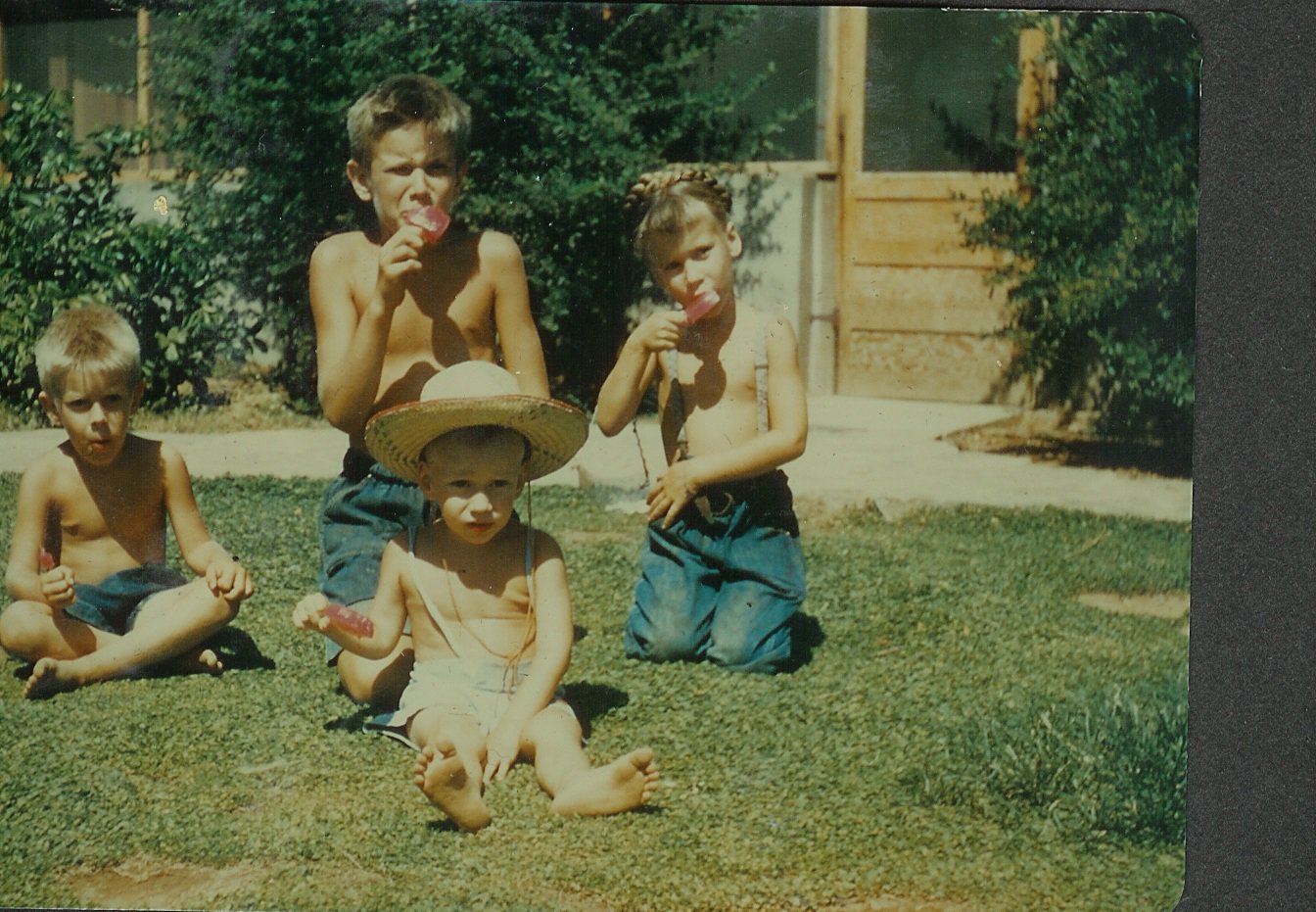
David, Dan, Terry Glenn, San Telmo
I think that it was in 1951 that the Mexican Government granted permits to two different individuals, or companies, to cut timber on the San Pedro Martir. Of course, there were no roads going up to the timber, so both of them started work on building those roads. A relative of the Melings, Douglas Johnson headed one group. He started his road at the Meling ranch. The road that he pioneered was almost the exact route of the present road that goes to the Observatory. It reached more or less to where the present gate to the National Park is located. He also set up a small mill at the Meling Ranch.
A Mr. Edwards had a concession for cutting at the north end of the mountain, so his road started just a few miles east of our place. He, and sometimes his wife, stopped frequently at the ranch for one reason or another. We got fairly well acquainted. This road followed up the Las Chollas Arroyo for several miles. This was a rather wide arroyo, with low ridges on either side that ran north-easterly for many miles. The road eventually turned east, climbing a series of low ridges to arrive in the watershed of the San Jose arroyo. Along the way, it passed by Buena Vista, at the northern extreme of the Meling ranch. A little farther along it went up a narrowing canyon that had a little stream of water flowing in it. Here Tom Farlow had built a small house and corrals. He called it his "winter camp". He said that he was too old to stand the cold at his home place, Conception, which was at about six thousand feet elevation. Here Mr. Edwards also installed a small sawmill. The road continued on up this canyon through a miserable stretch of steep grade, loose dirt, and large rocks. Once you got past that it was smooth going for several miles. In that area Mr. Edwards had established what he called the "Water Camp". It was on a ridge that was only about a mile from the Arroyo San Rafael, which always had a goodly stream of water. He had cut a road down to the water in a side canyon with a gentle slope. Farther up, at the very base of the mountain, was the "Powder Camp", so named because from here up the road had to be blasted out of solid rock for a distance of more than a mile. This camp was on a little flat area just below the Johnson Ditch. Both roads were simply "pioneered", that is carved out with a bulldozer, without benefit of a grader, drainage and culverts, or surfacing. Driving them was somewhat of a challenge!
All of this construction must have taken more than a year, maybe two. However, just as suddenly as it had started, it came to a halt. The story that I heard was that they were not able to get permits to haul the lumber on the Federal Highway. Whatever the reason, a cynical person might reach the conclusion that the Government had planned it that way from the start. Iím sorry that those people lost their investment, but Iím very glad that the mountain was not logged. The mountain today is a National Park, and remains almost as I remember it from my first trip in 1939.
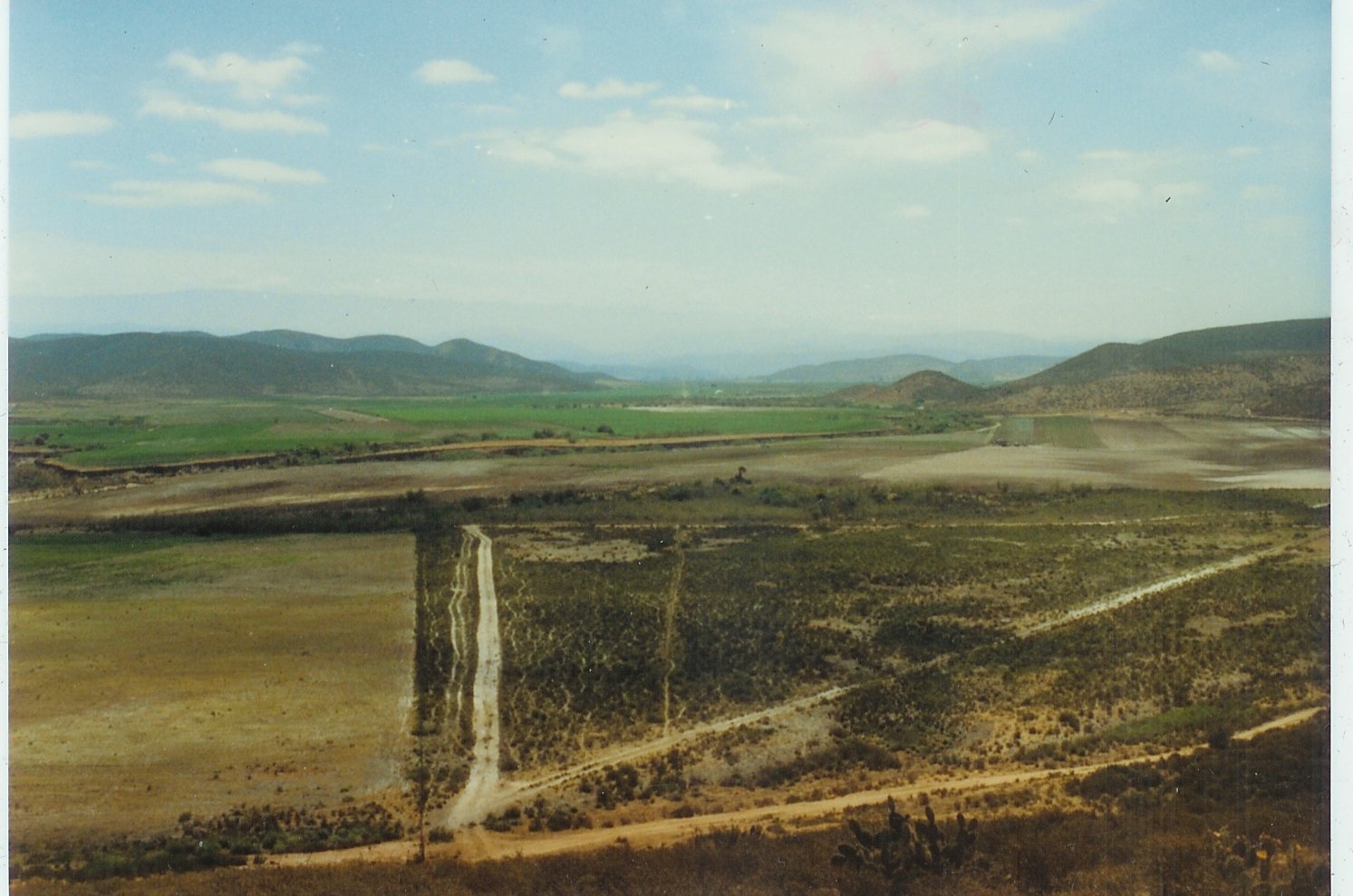
San Telmo Valley, looking east toward the Ranch, 1987
These two roads, especially the northern one, opened up lots of country for us to explore with a pickup, instead of horse and mule. I made a number of one-day trips up the north road with various relatives and friends. After Tommy moved back to Simi, he and John Wilson bought a used Jeep together. We used this jeep on one trip to follow the road that had been blasted out of rock around the north end of the mountain. From the end of this road we could walk among the pines. On other trips we parked at either the water camp or powder camp, then hiked down to the Arroyo San Rafael to do some trout fishing. It was satisfying to think that these trout were descended from those I had helped to plant there in 1939. Of course, my brother Alan had also done the same thing in 1938. However, Iím pretty certain that I caught only "my" fish! This road has a locked gate now, just above the Johnson Ditch. The only people that use that stretch of road today are the cattlemen that move their stock to the north end of the mountain for summer pasture.
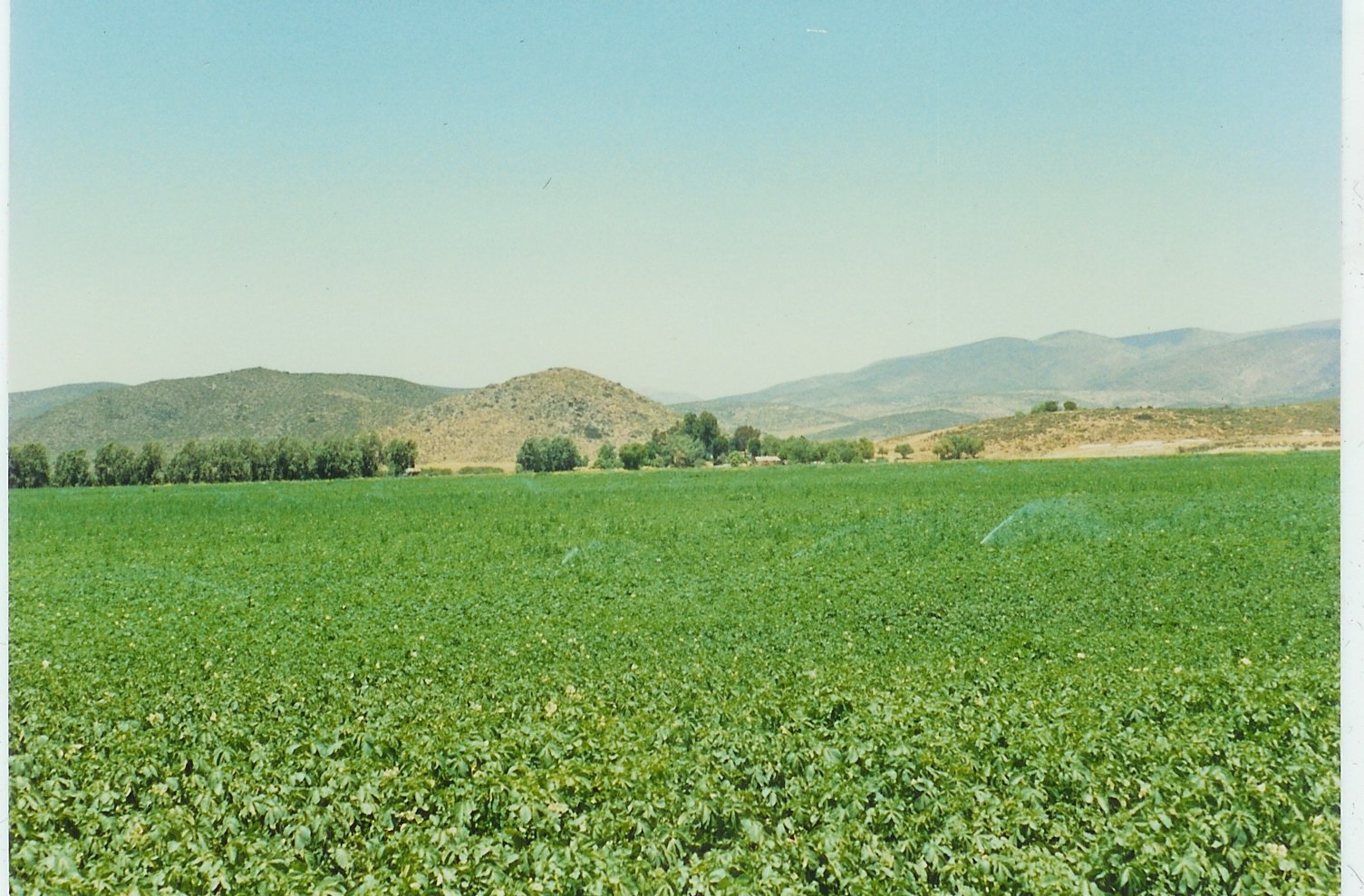
A nice field of
potatoes on the ranch, 1987
I made four pack trips to "my" mountain, the San Pedro Martir. We never seemed to have time for these trips under routine circumstances. Then, when we had guests that suggested a trip, there was always time! One such trip consisted of Jean and John Wilson, Rae and Frank Wilken, Merilie, Barbara and me. Of course we had to round up horses, mules, and a packer or two. We had two saddle horses, and we got the rest from the Pompas, or Gabriel Espinoza. As I mentioned earlier, we sent the livestock up to Rancho Santa Cruz early in the morning, and we followed in the afternoon with all the gear, and feed for the animals. Gabriel and a man from our ranch, Claudio R, took care of the animals. Early the next morning we were mounted and ready for the long, steep climb up the mountain. About half way up is a small spring and a grove of oak trees. This makes a welcome resting spot for both man and beast! Appropriately, it is called El Descanso, or resting place. Before reaching the crossing of La Zanja Arroyo, we turned off to the south, to find a camping place farther downstream. There is no established trail to this area, but by breaking a little brush, our packers got us through to the stream. We found a nice flat, open area to make our camp. I had camped near there in 1939, with Grampa and Ted Deaver. After lunch, and a much needed rest, we got the fly rods rigged up, to match wits with the wily trout. We spread out on the stream, Barbara and I walking upstream a bit to start fishing. She was the first of us to hook a fish, and you have never seen anyone so excited! I put my pole down, and helped her with her fishing. Watching, and sharing in her excitement was much better than fishing! Everyone caught fish, and we had a grand fish fry that evening.
That night I got one of the worst scares of my life. We had a tarp that we spread out on the ground, large enough for all the bedrolls. Sometime in the night, I rolled over and my hand came down on something cold and clammy. My only thought was rattlesnake! I very quietly found my flashlight, then, putting my hand over it to allow only a tiny bit of light to escape, I shined it in the direction of the snake. Well, imagine my relief to find that the deadly rattlesnake had turned into a large frog! Sort of a fairy tale in reverse! I tossed the frog out into the bushes, and no one else was aware of the grave peril they had been in!
There was one other mishap that, while not as dramatic, was quite serious. It is common practice to hobble all the horses, especially the mares, so that they can graze at will. The mules will almost always stay close to the mares. In this case, Gabriel and Lilo, his helper, spent some time blocking, with brush, all the places that the animals might wander to far. This area was thick with manzanita, and as I mentioned, no trails. Because of these precautions, only one mare was hobbled. In the morning all the animals were gone, including the hobbled mare. Claudio(Lilo) set off at a trot, to track our animals. He didnít return until mid-afternoon, having followed them all the way back to El Descanso!
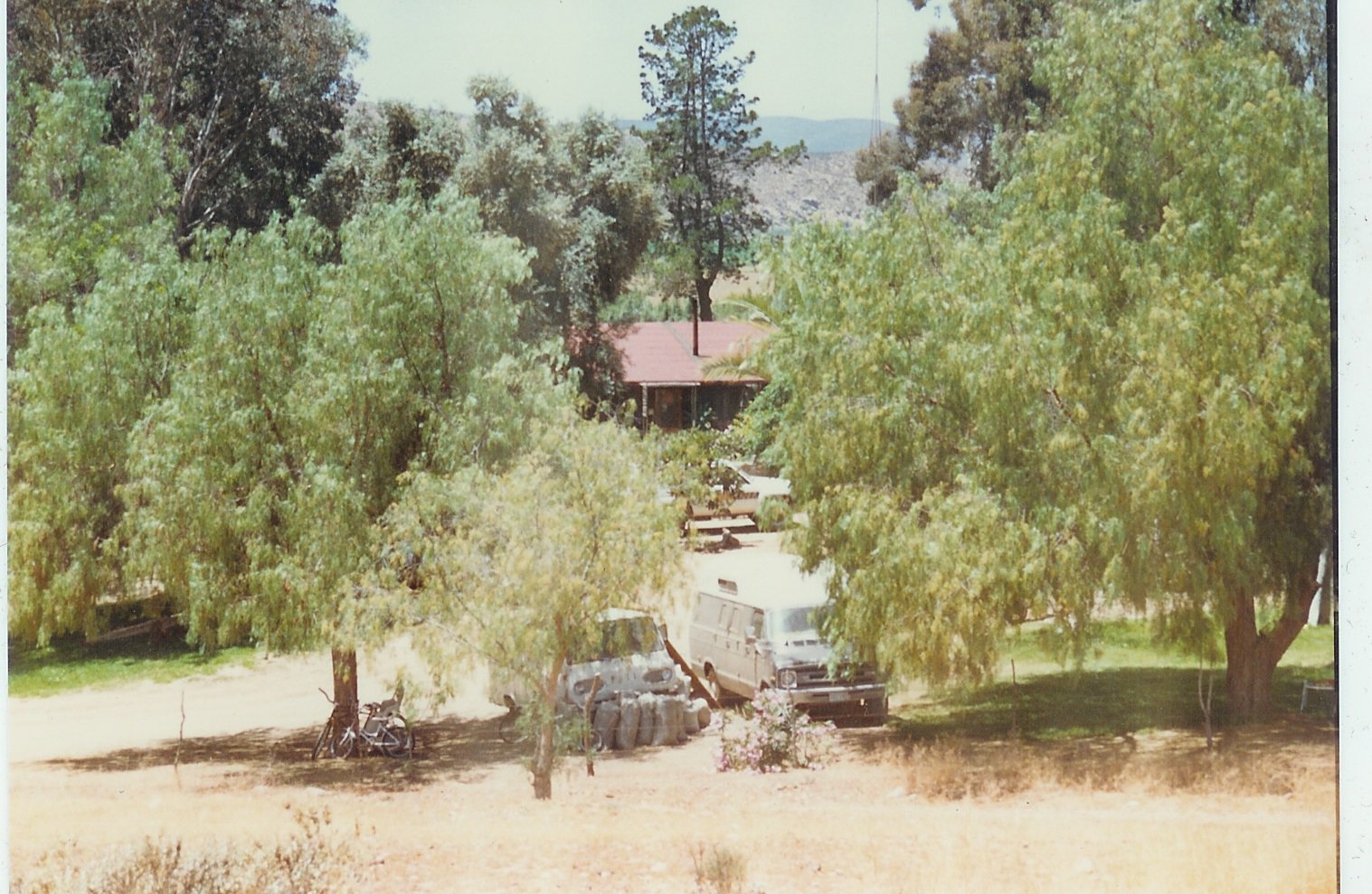
The Changala Family
planted lots of trees around the house, 1987
Another time Tom, Tommy, and I took Howard Peto up to La Grulla. That was quite an experience for him, as he had never done any riding at all. I think Gabriel was our packer on this trip also. We put Howard on a sure-footed mule named Alazan. He shortened this to Alice, and talked to her constantly as we rode. When we arrived at the old camping spot at La Grulla, we found that it was occupied by "tourists", brought in from the Meling ranch. For my part, I was quite indignant about this. I assumed that this spot should be reserved in perpetuity for the descendants of C. E. Utt! Alas, it was not to be, so we rode a mile or two downstream for our camp. I remember well an episode that occurred as Tommy and I were fishing together. We were working our way downstream, sort of taking turns fishing the pools as we came to them. On one of my turns I climbed up on a large boulder, six or eight feet above a nice little pool. When I dropped my fly on the water, it was taken immediately by a very nice trout. I thought that I would have a better chance of landing him if I worked him over to the far side of the pool with my rod. As I got him out onto the sandy bank, he threw the hook, and was flopping his way back to the water. Without stopping to think, I dropped the rod and leaped into the pool to try to get that fish in my hands before he escaped! Despite my best efforts, I lost my fish. There was an upside to my misfortuneóTommy went into gales of laughter at my antics, and never missed a chance to give me a bad time about it in later years.
A trip that happened on the spur of the moment was when John Sais told me that he was being called into the Army Reserve because of the Korean War. I had told him many tales of the Mountain, and we had sort of talked about going up some day. He said that he would really like to go before he left for the Service. So, I got Macleer to get a couple of mules, along with our two horses, ready for the trip. This time we were able to use our camp at La Grulla. As John and I were fishing the next day, we got caught in one of those sudden summer rains. We needed shelter, so we went back upstream to where there was a large overhanging rock. There we sat down to wait out the rain. We had both taken trout from the pool in front of the rock earlier, but decided to try it again as we waited for the rain to stop. Much to our surprise, nearly every cast caught a fish. We caught more fish during the rain than we had earlier, in the same pool.
What turned out to be my last pack trip to San Pedro for forty years was after Tommy had left the ranch to work at Maulhardt Equipment Co. He came down on a vacation, and he, Tom and I made a quick trip to La Zanja. We made our camp at "Contento". Tommy and I shared another fishing adventure. We fished up-stream until there was not much more than a trickle of water. Quite unexpectedly, we came to a small pool of deep water. We both fished this pool, from different sides. A large trout rose to one of the flies, but didnít take it. By now we had spooked him, so we wandered on up-stream, hoping to find more pools, to no avail. As we started back down, we formed a plan, or a pact if you will, that would give each of us an equal chance at the "land locked" trout. We would approach the pool on a large rock above it, then we would each drop our flies in the water at the same time. As luck would have it, the trout rose to my fly, but in my eagerness to set the hook, I pulled up on my rod too fast. My fly shot up and lodged in the branch of a tree, and all I could do was watch as Tommy brought in MY trout. I can guarantee you that Tommy never misses a chance to remind me of that little mis-adventure.
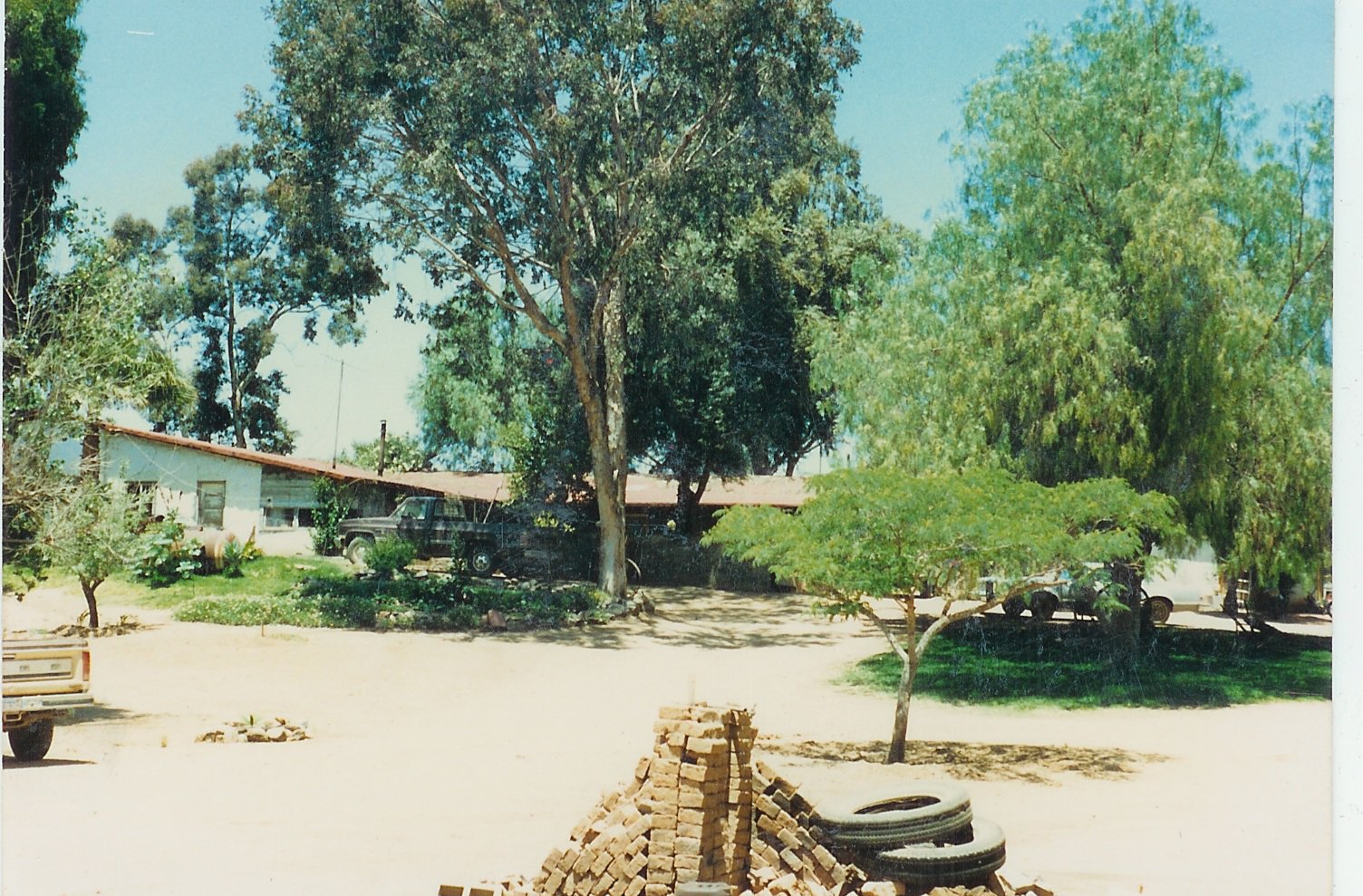
1987
One of our favorite family outings was to drive down to Johnson Beach, near San Antonio del Mar. To get there we went out to the highway, turned north to Colnet, then out over a mesa to the coast. A short walk over the dunes brought us to a beautiful, shallow, sand beach.
A couple of times we drove down to the coast at Santa Maria, south of San Quintin. If the tide was low, we could gather large Pismo clams, just by digging with our hands wherever we saw a little ripple in the sand. Barbara and I, along with our friends Ted and Polly Walck, visited there in 1966, and finding clams was much more difficult!
Another destination was Punta Cabra. To get there, we turned west off the highway at San Vicente, following San Vicente Arroyo to the coast, then north a few miles to a nice little cove. Not much of a beach, but it was a good place to camp. The road down the Arroyo could be pretty miserable because of the water crossings. We soon discovered that there was another, longer road out over the hills that brought us to the highway several miles north of San Vicente. This became the preferred route.
Many Americans heard about the Meling ranch, and decided to drive there without much idea of what they were getting into, and therefore not taking simple precautions, such as having a full tank of gasoline, or asking for directions, or not paying attention to signs. From my very first trip into that country as a boy, I learned some very basic rules, such as;
Never, ever, pass up a chance to fill your gas tank. In the very early days there were no service stations, as such. Just a few ranches that had a few 55-gallon barrels, that might or might not have gas in them when you arrived.
Ditto for water: always travel with full containers.
Never pass by a vehicle or person in need of help: no emergency road service here!
If your own vehicle breaks down, leave it in the road. That way those that do not observe #3, above, have to stop and help in order to get around the stalled vehicle!
One day two young men walked into the ranch, saying that they had broken the oil pan on their car on the road up to the Meling Ranch. We drove up in the PU to tow the car back to our ranch where I might be able to fix it. When I saw what they were driving, I marveled that they got as far as they did. It was a sports car, an MG, I think. Very, very low; practically no ground clearance. I think that the first bit of rutted road did them in. Fortunately for them, that was just as the road left the valley, heading into the hills, so they only had about five miles to walk. The oil pan was of cast aluminum, and for sure I had not mastered the art of welding aluminum with a torch. I did have some aluminum rod that Stu had given me to mend sprinkler pipe. I patched the pan up as best I could, then used some quick drying gasket cement to seal the cracks. I bolted the pan back on the engine, filled it with oil, and sent them on their wayóback to San Diego.
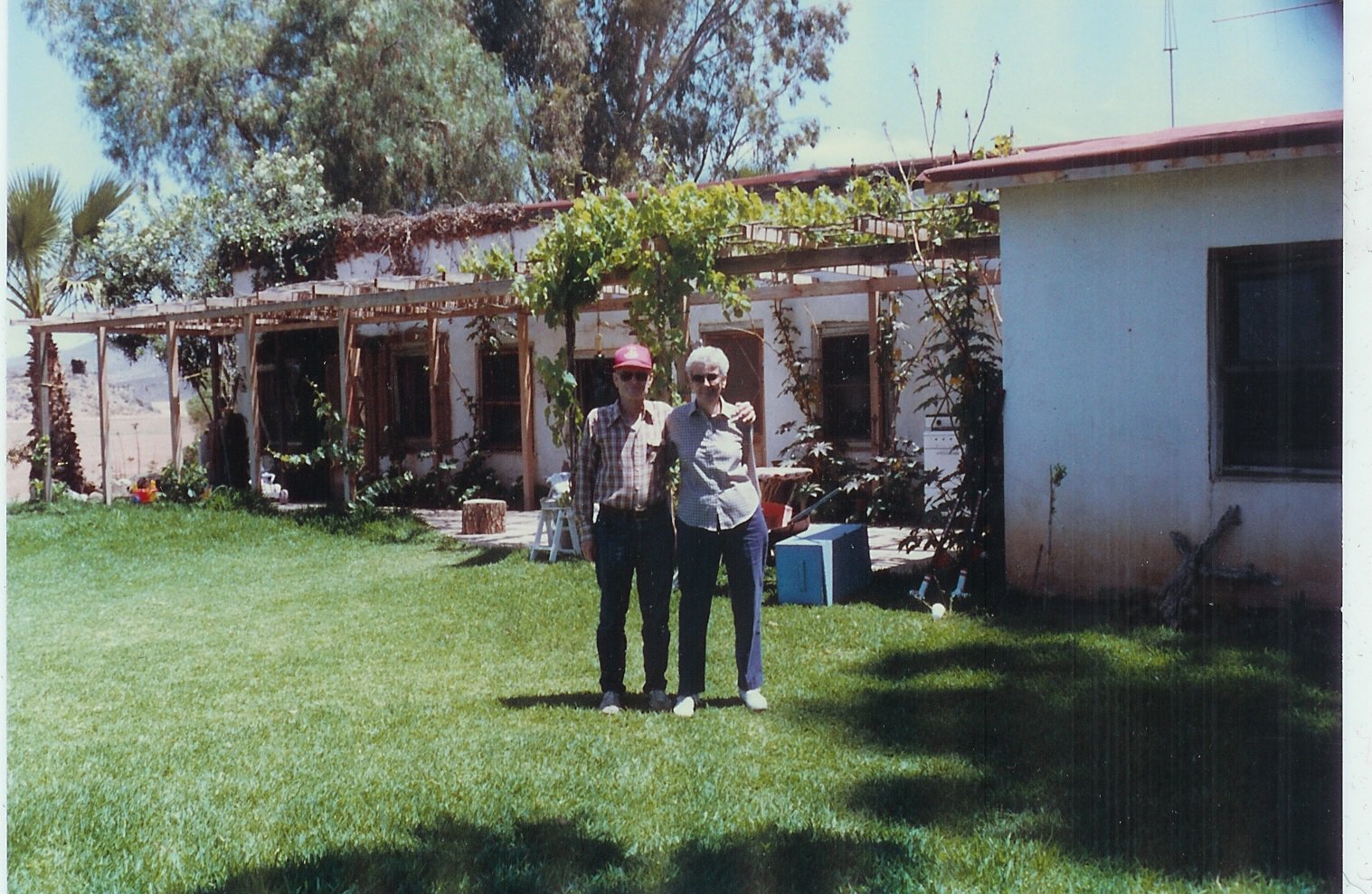
Leigh and Barbara, in the backyard of the house, 1987
Another time an older lady hobbled up to our door, looking totally exhausted and bedraggled. She explained that she and her husband had run out of gas on their way to the Meling ranch, or so she thought. We brought her inside, and Barbara fixed her some food, and packed a lunch to take to her husband. As we visited, I learned that her husband was not well, had heart trouble as I remember it. That was why she had walked in, leaving him in the car. Also, from the things she told me, I knew that they had turned off onto the road to Santa Cruz. I think that when they ran out of gas she walked a long way on out the road, hoping to find the Meling ranch. She finally returned to the car, and they spent the night in the car, fearful that at any moment they would be attacked by wild beasts. Then, at first light, she started back down to our place. Iím guessing that she walked back at least fifteen miles, maybe more. Poor lady, she was exhausted and worried sick about her husband. As soon as I got water, food, and gas in the PU, we drove out and found her husband. Other than being worried about her, he was OK. It took no persuasion from me to get them to abandon their trip to the Meling Ranch!
Mr. Edwards, whom I mentioned earlier, also walked into the ranch for help. He and his wife had been on their way up to his road construction camp when his PU engine died, and would not start. He drove a Ford PU just like mine, so I took the only spare parts I had on hand, a set of distributor points and condenser, and a can of gas just in case, and off we went. When we got to his truck, I took off the distributor cap and had him crank over the engine. I could see that the points were not opening as they should, and therefore no spark to the plugs. A simple adjustment would have him going, but I put the new points in, por las dudas. (for the doubts-just in case). He was ever so grateful; he thought I was a genius! (I realize that with the advent of electronic ignition, an entire generation has grown up not needing to know any thing about distributor points, but those were the good old days!)
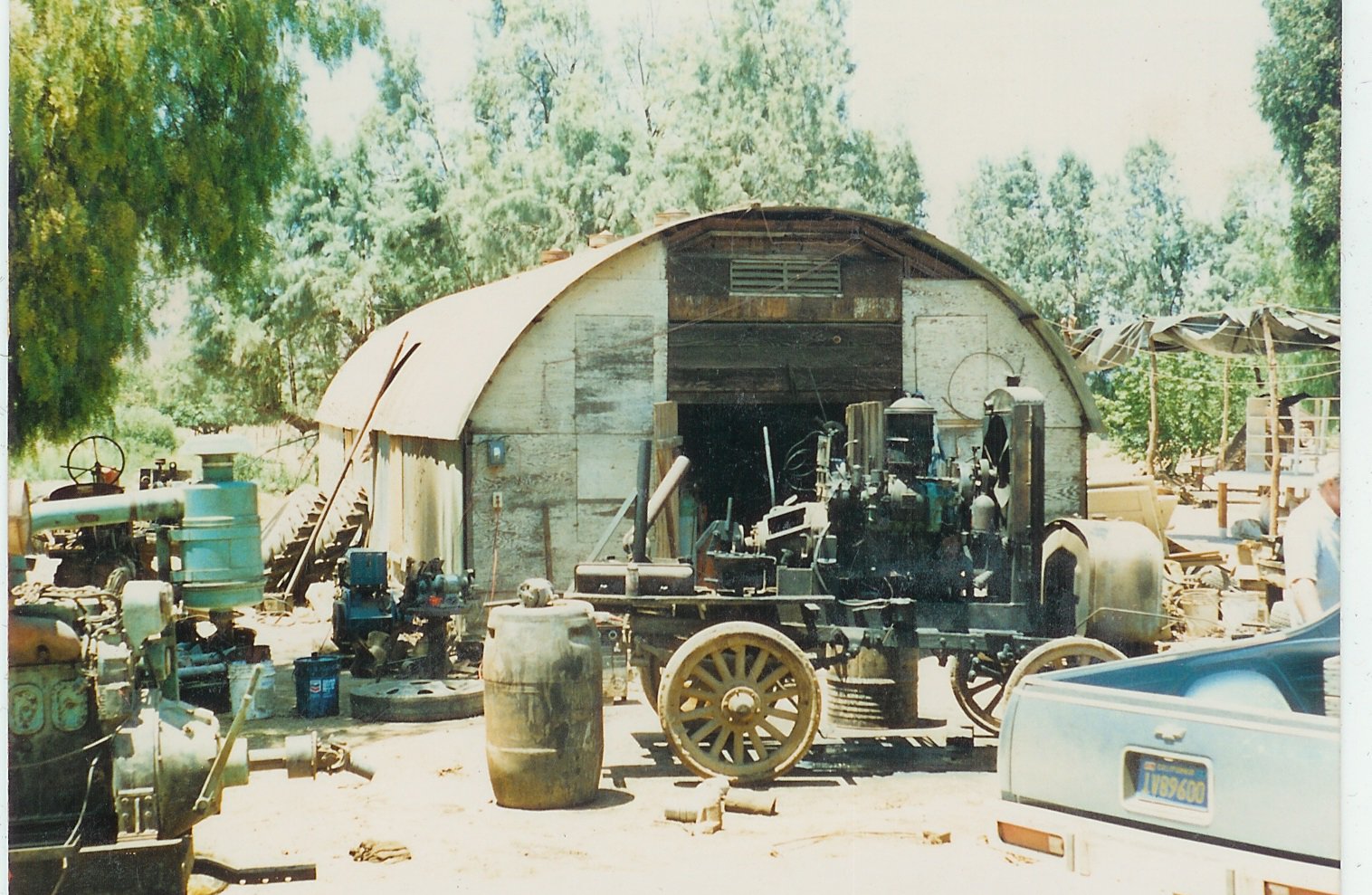
1987, lots more
junk around the old Quonset Hut
In the winter of 1952-53 I planted barley on all of Tomís 250 acres. I had a contract to sell it to the brewery in Tecate. I irrigated it with the sprinklers once or twice, as needed between rains. By the first of April it looked really good. It had headed out nicely, and the kernels of grain were starting to fill. I was sure that there was enough moisture in the ground to mature what was going to be a very nice crop. I went to spend a few days with Barbara and the children. When I returned, I realized that something was very wrong. The heads seemed to be drying up. When I felt them, they were soft, and empty, rather than plump and firm. Epifanio told me that a few days before, on April 10th, there had been a very severe frost. Obviously, it was cold enough to destroy the developing kernels of grain. That was not a very nice anniversary present!
There were other factors involved, but the loss of the barley crop surely was the last "straw", if you will, in my decision to leave the ranch. The ranch seemed to be going downhill, little by little. We no longer had a market for tomato or bell pepper seed, and Burpee had cut back on our acreage. Also, as I mentioned earlier, neither Barbara nor I were happy with me being away from home so much of the time. It was a very hard decision to make. I hated to walk away from five years of effort, and from the dream. Most of all, I felt guilty about leaving Tom with the project that we had started together. As bad as I felt at the time, I know it was the right thing to do.
Of course, there was the little matter of finding a job. I had always worked for, or with, my father. (With a couple of years off to work for my Uncle---Sam, that is!) Looking for a job was a new experience for me. I figured that I had learned enough about mechanics to be able to find work in that field. Also it was something that I enjoyed doing. I had gotten acquainted with the service managers at the International Harvester dealer and the Caterpillar dealer in San Diego. Neither of these shops had any jobs available, so I decided to go up to Oxnard to see about a job with Maulhardt Equip. Co, where my brother Tommy was working. I had known the service manager, Norman Frost, since the very start of the San Telmo project. He agreed to give me a job, and so the die was cast.
Of course, there were many loose ends to be taken care of. I talked to a number of people in Ensenada about buying my truck, finally selling it to Walter Hussong. I didnít come out well on that deal, but I got enough to pay off the loan in San Diego. We finally agreed to sell the house for somewhat less than it was worth, but we needed to have it over and done with before we moved. We were able to pay Barbaraís folks back for the down payment they had lent us.
We also had to move stuff out of both houses, San Telmo and Chula Vista. We moved into my folksí house on Sinaloa Ranch, what my children refer to as the "Big House". By the time this was done, we were about as broke as we could be. Dorothy loaned me $100 to buy groceries until I got my first paycheck. I was able to pay her back from that first check, and we managed to avoid personal debt for a long time after that.
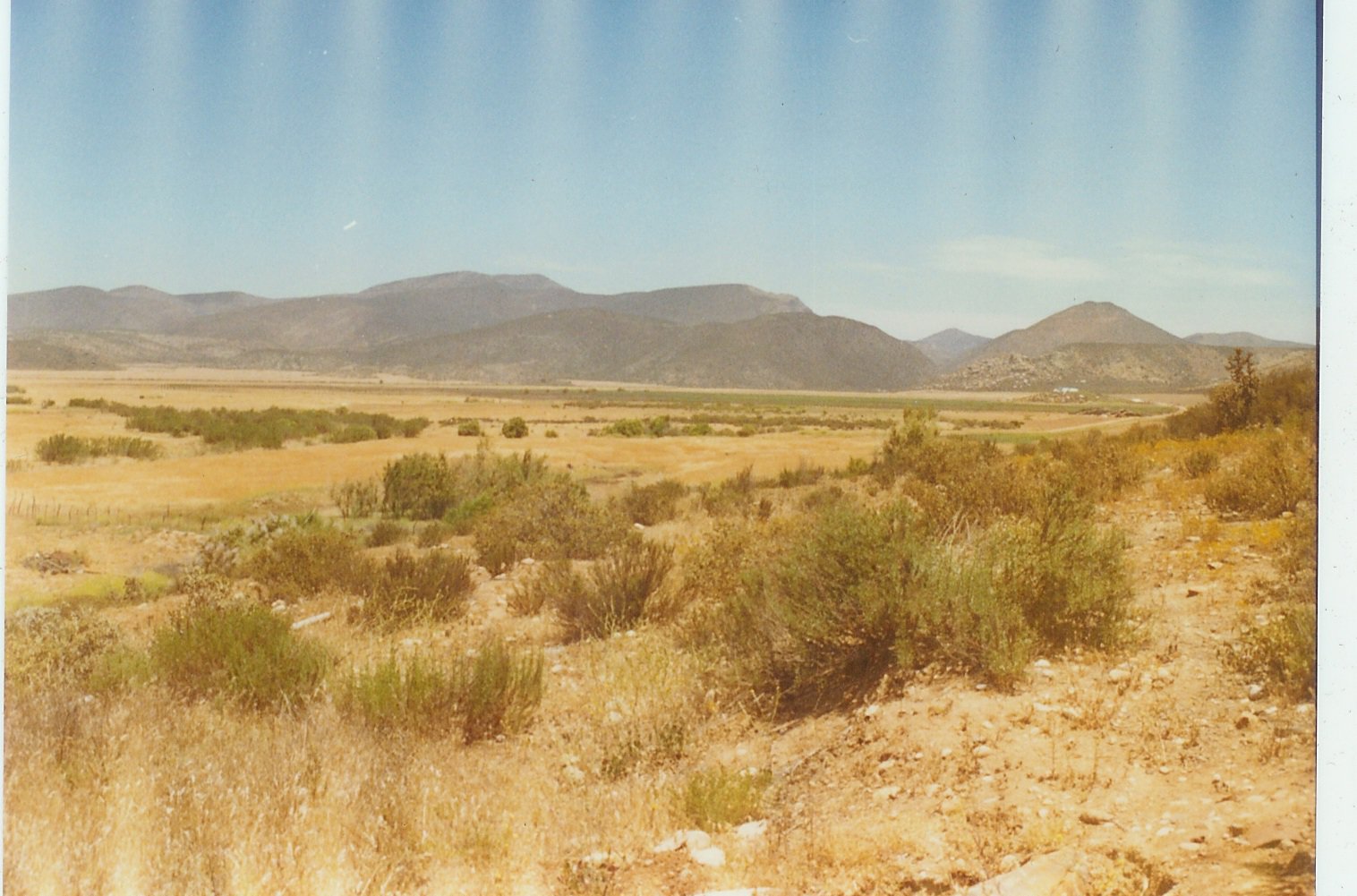
Santa Terresa Valley, 1987
I feel that the only real failure in life is not to learn from our mistakes. We certainly made many mistakes, and we certainly did not succeed in our goal of building a viable operation, but I definitely learned many things. From my brother Tommy I learned a lot about mechanics. From Carl I learned lots about building a house. From all of my activities I learned a little about the financial end of everything. I became fairly adept at that most important of survival skills, improvising. Of course, I learned lots about farming, both positive and negative! About myself, I learned that I was not exactly a "people" person. I loved and admired my father, but I came to understand that I was not ever going to "be" him. We just had different styles. At that time in the evolution of farming one generation represented an enormous leap, from mules to tractors, and in management styles. Personal and generational differences crept into many aspects of our relationship. I tried my best to keep all these things in mind later on, when Gerry and I worked together.
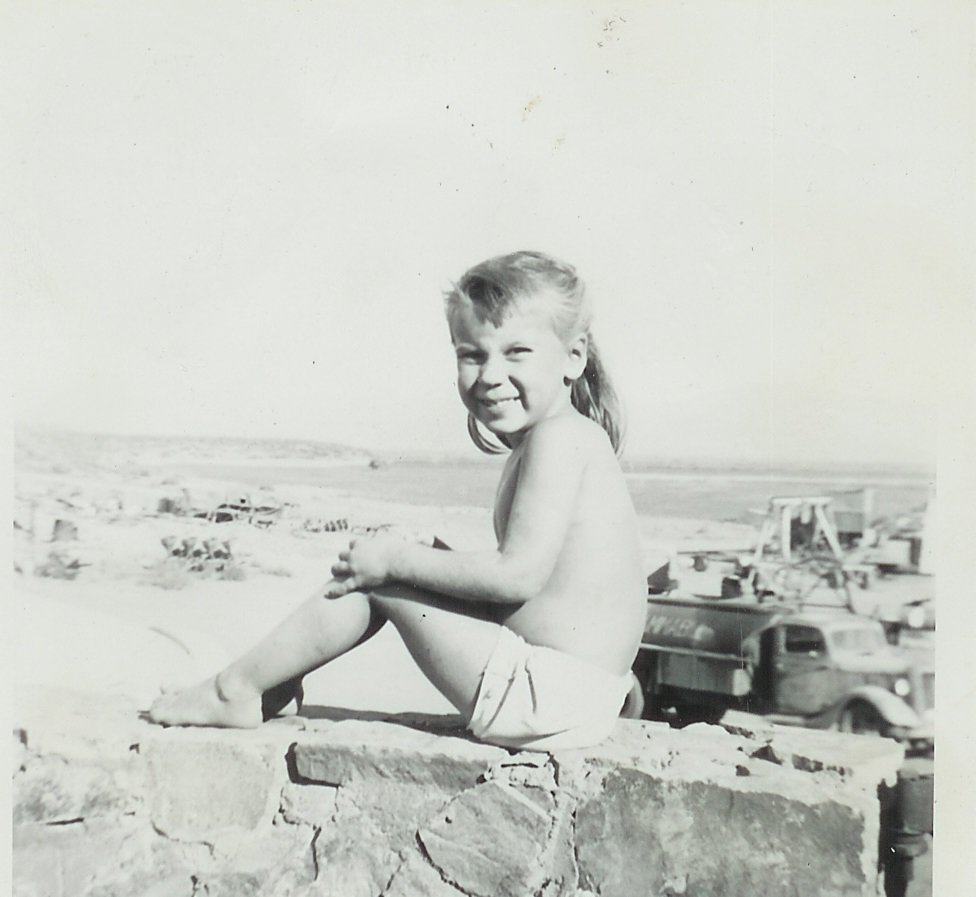
Terry, about 1950
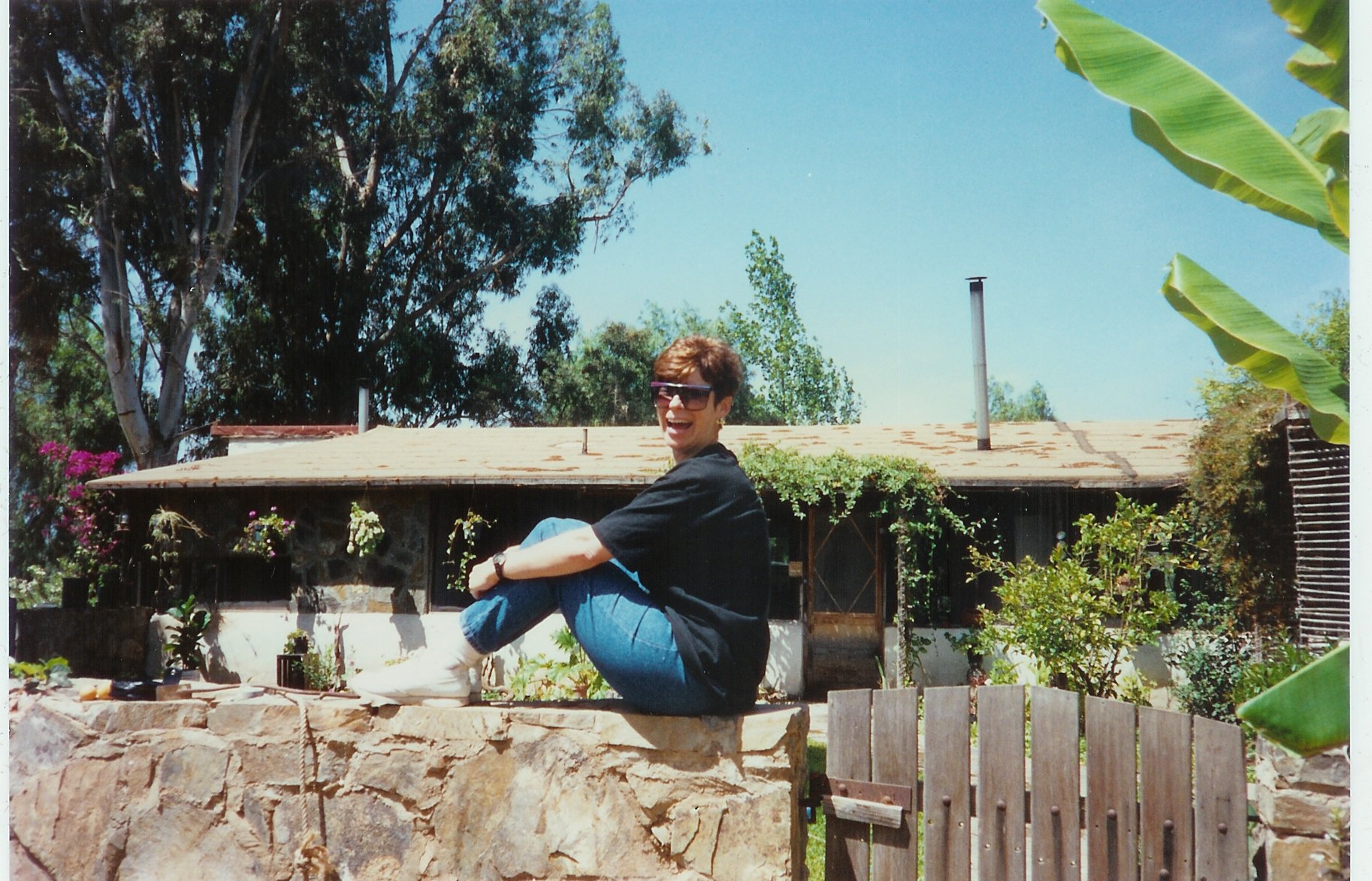
Terry, 1992
I have absolutely no regrets about the whole adventure. It was truly an adventure! We met lots of interesting people, had many trips to the seashore, and to San Pedro Martir. Barbara and I, and the older children, have nothing but fond memories of those years. And it was a grand learning experience!
After we left the ranch, Tom and Dorothy started spending most of their time in a little house in Ensenada, leaving Epifanio in charge of the ranch. After a few years Tom lost his 250-acre ranch to a local rancher, Jose Antonio Arce. Arce went to court with a survey map that was an exact replica of Tomís map, except that it was dated two years earlier. The Judge decided in Arceís favor, and Tom opted not to pursue it in a higher court. About this time, he also sold the remaining ranch to Tony and Shirley Changala, from Irvine, CA. After a few more years all the wells in the valley went dry, due to a prolonged drought. The Changalas had to leave the ranch for several years before being able to return and start farming again. I have visited the ranch, and the Changala family, several times in the last 10 years. The ranch is productive, and succeeding generations of Changalas are quite happy to be there.
Many of the people that I got acquainted with during those years remained a part of my life for years to come.
Some of the men from the ranch came to work for Tom at San Miguel; Epifanio Rendon, Samuel Tovar, and Felipe Cortez come to mind. Claudio (Lilo) Rendon eventually owned and operated his own well drilling rig. Pablo and Aldegunda worked at the El Rey Sol. Pedro Pedroarena and Juanita came to Ensenada to operate a laundry during the drought years. They both died in a plane crash on their way to La Paz. The Mexican Government bought the LaSalle ranch to turn it into an Ejido. Gerry and I ran into Bernardino Macleer on a trip that we took to tour the back country from Ojos Negros to Mikeís Sky Ranch to San Telmo. He guided us on a side trip to San Antonio de Los Murrillo, in the Santo Domingo arroyo. On various other trips I encountered Tom Farlow, Jr, Francisco Mayoral, Hector Arce and his wife, Marina, and of course several generations of Melings. On a trip to the Mountain with all of my children, except David, we encountered three men riding their horses near La Grulla. One was Espinoza, one Martorel, and one Arce, all descendants of men that I had known.
I had social and business contact with Al Condit for many years. Howard Peto left Burpee to start his own seed company. I did business with Peto Seed Co, as a salesman, and then later I bought tomato seed from them when I was farming.
John Sais became the district manager for Associated seed Co. He and his wife and children lived in Santa Paula. The last time I saw him, he was ill with cancer. I heard later that he had passed away.
So, the great adventure ended, but never really went away.
One door closed, another opened.